Introduction
In the rapidly evolving landscape of artificial intelligence, organizations are discovering the transformative potential of AI Proof of Concepts (PoCs). These initial demonstrations serve as critical stepping stones, allowing businesses to validate the feasibility of AI solutions before committing to full-scale implementation. By embracing a structured approach to PoCs, companies can mitigate common challenges, enhance operational efficiency, and align AI initiatives with their strategic goals.
This article delves into the essential steps for launching an effective AI PoC, identifying key success metrics, overcoming resistance to change, and preparing for a seamless transition to full-scale implementation. With practical insights and actionable strategies, organizations can confidently navigate the complexities of AI adoption and unlock new avenues for growth and innovation.
Understanding the Importance of AI Proof of Concept
A Proof of Concept (PoC) in artificial intelligence acts as a crucial initial demonstration to validate the feasibility of an AI approach before committing to full-scale implementation. It enables organizations to test hypotheses, evaluate relevant technologies such as Small Language Models (SLMs), and assess the potential impacts on business processes.
By conducting a PoC, you can identify common challenges, such as:
- Poor master data quality
- Integration concerns
Early on, refine your approach, and address stakeholder hesitations regarding complexity and cost. Many organizations perceive AI projects as time-intensive and costly, which can lead to ‘AI Implementation Paralysis’—a hesitation to start due to fears of complexity and resource allocation.
This proactive step is essential to ensure that the proposed AI approach aligns with your organization’s specific goals and effectively addresses the actual needs of the business, ultimately leading to informed decision-making and strategic resource allocation.
Moreover, as illustrated in our case study on enhancing operational efficiency through GUI automation, such initiatives can significantly improve workflow and decision-making processes.
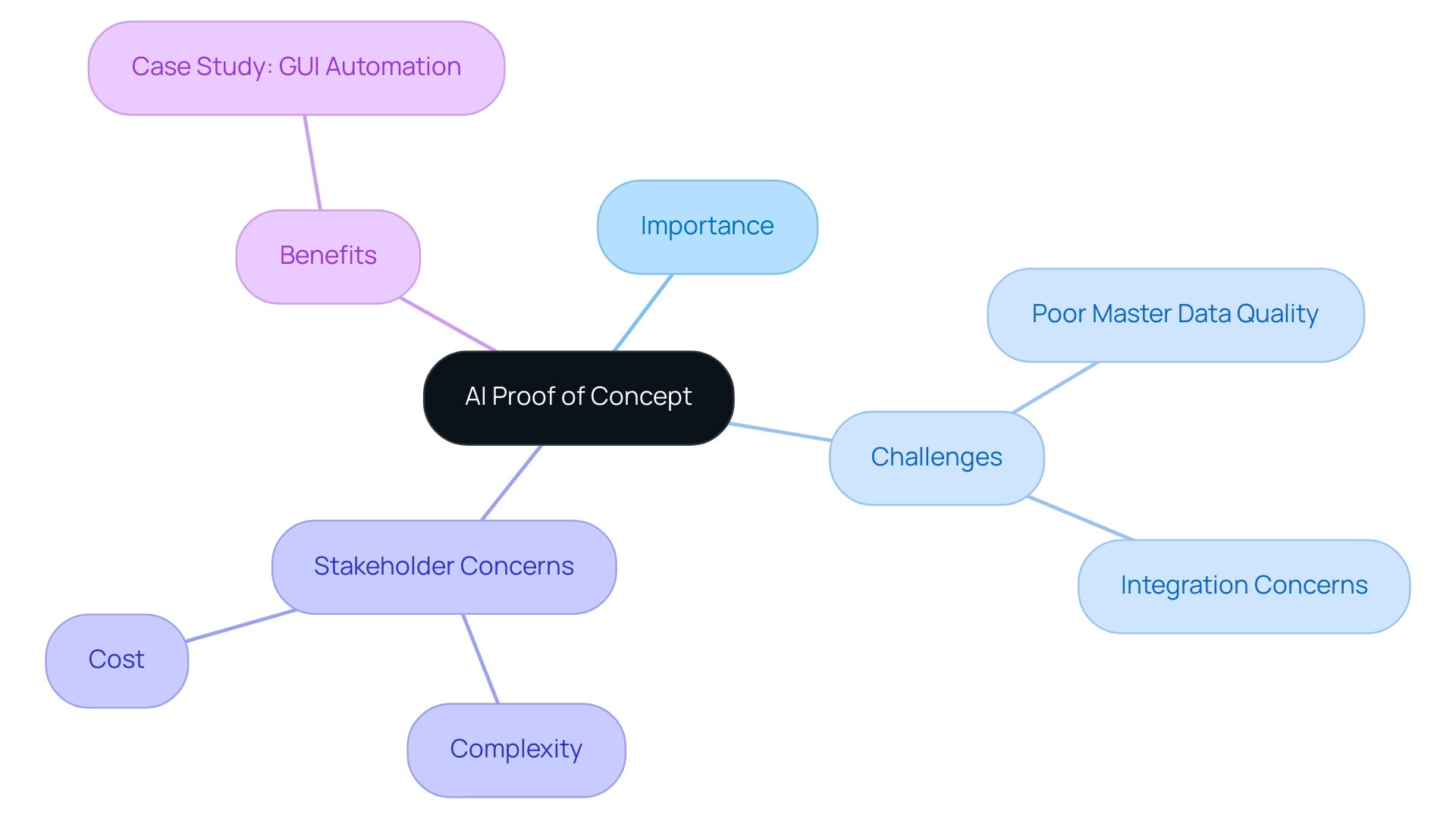
Step-by-Step Guide to Launching Your AI Proof of Concept
-
Define Your Objectives: Begin by clearly outlining the goals of your AI PoC. Identify the specific problem you aim to solve, such as overcoming repetitive tasks or addressing staffing shortages, and how AI, in conjunction with RPA solutions, can contribute to resolving it. This will guide your project and keep it focused.
-
Assemble Your Team: Gather a cross-functional team that includes stakeholders from IT, operations, and relevant business units. Their diverse perspectives will enrich the PoC process and ensure alignment with organizational needs, especially in identifying opportunities for RPA implementation.
-
Select the Right Technology: Research and choose AI technologies and RPA options that best fit your objectives. Consider factors such as scalability, integration capabilities, and vendor support. Ensure the technologies align with your goal of enhancing operational efficiency and modernizing outdated systems.
-
Develop a Prototype: Create a prototype that showcases the core functionality of your AI system, integrating RPA where applicable. This should be a simplified version that allows you to test your hypotheses without extensive resource investment.
-
Conduct Testing: Implement your prototype in a controlled environment. Collect feedback from users and evaluate the performance of the AI system alongside RPA functionalities against your defined objectives. This phase is crucial for identifying any areas for improvement and ensuring that the approach reduces errors and boosts productivity.
-
Analyze Results: Evaluate the outcomes of the testing phase. Did the AI approach, in conjunction with RPA, meet the predefined objectives? What insights were gained? This analysis will inform your next steps and decisions on scaling, especially in terms of leveraging Business Intelligence to extract actionable insights.
-
Prepare for Scaling: Based on the results, develop a plan for expanding the AI application and RPA across the organization. Consider necessary adjustments, resource allocation, and stakeholder engagement strategies to facilitate a smooth transition.
-
Communicate Findings: Share the results of your PoC with key stakeholders. Highlight successes, challenges, and recommendations for moving forward. Highlight how RPA tools can tackle workplace challenges, renew outdated systems, and improve efficiency, which is essential for gaining support for full-scale implementation.

Identifying Key Metrics for Success
To effectively evaluate the success of your AI Proof of Concept (PoC) and its integration with Robotic Process Automation (RPA), it is imperative to define key metrics that will provide insight into its performance. Consider the following metrics:
-
Accuracy: Measure how accurately the AI model performs in comparison to benchmarks or expected outcomes. This is critical in assessing the model’s reliability, especially when utilizing innovative tools like EMMA RPA, which enhances accuracy through intelligent automation.
-
Time Savings: Calculate the reduction in time taken to complete tasks with the AI approach versus manual processes. This metric highlights efficiency gains, particularly through RPA’s ability to automate repetitive tasks and improve workflows, thus alleviating staffing shortages.
-
Cost Reduction: Analyze any decreases in operational costs as a result of implementing the AI system. This can include labor savings or decreased error rates, demonstrating the financial viability of utilizing tools like Power Automate, which streamlines workflows and lessens the burden on outdated systems.
-
User Adoption Rate: Monitor how quickly and effectively users embrace the new AI system. High adoption rates suggest that the approach meets user needs and is user-friendly, facilitating a smoother transition to automated processes.
-
Return on Investment (ROI): Assess the financial return produced by the AI system in relation to its implementation costs. This metric is essential for justifying the investment to stakeholders, particularly when the ROI risk is borne by providers who recognize the value of delivering successful automation offerings.
By identifying and tracking these key metrics, organizations can gain valuable insights into the effectiveness of their AI PoC and make informed decisions about future implementations, ultimately driving business productivity and enhancing decision-making through RPA and tailored AI offerings like EMMA RPA and Power Automate, which promote collaboration between human workers and automated systems.
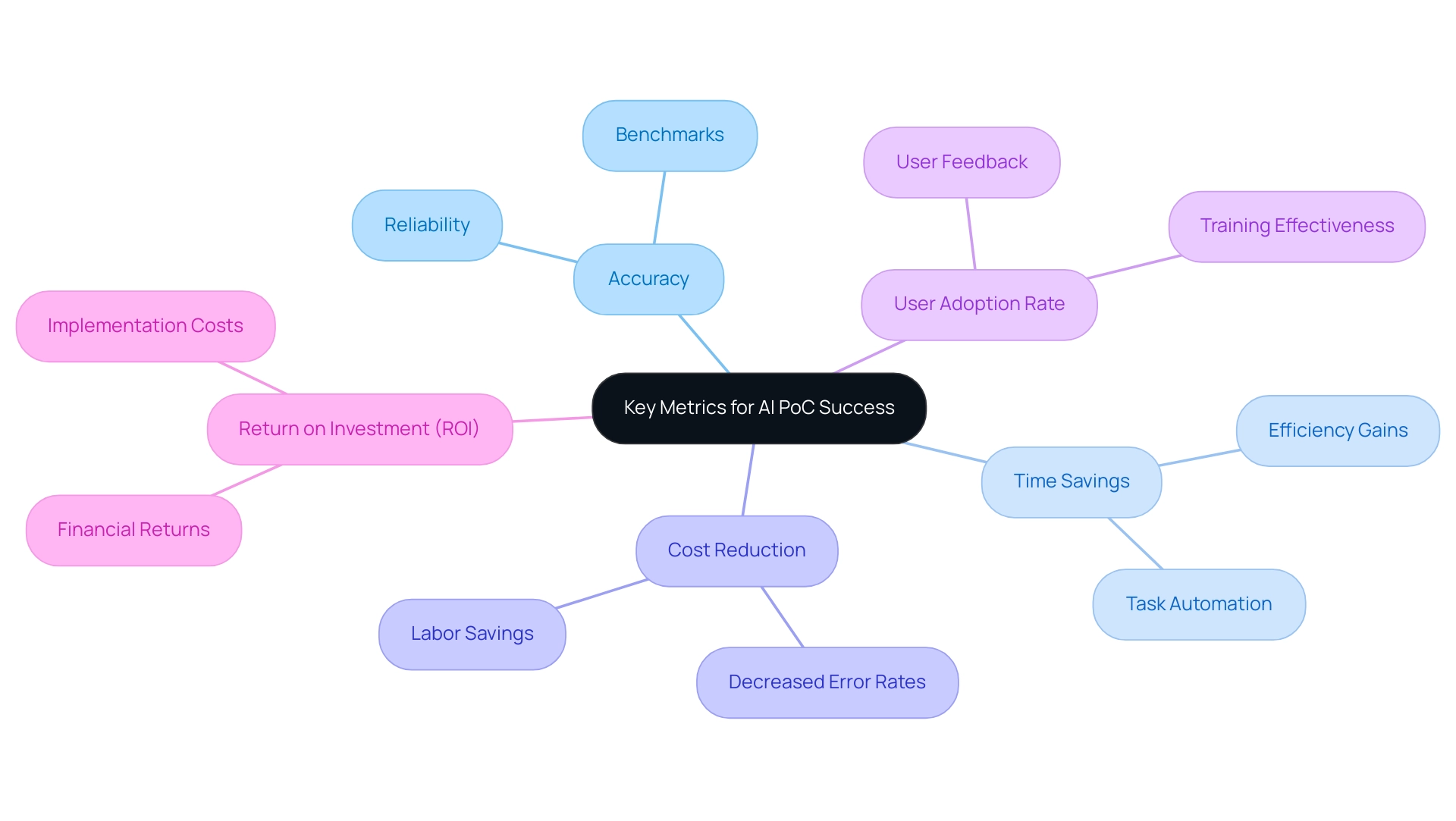
Overcoming Resistance to Change
-
Communicate Clearly: Openly discuss the purpose and benefits of the AI Proof of Concept (PoC) with all employees. Address any concerns and emphasize how the approach will enhance their work rather than replace them, especially as our tailored AI offerings are designed to align with specific business goals.
-
Involve Employees in the Process: Encourage participation from employees in the development and testing phases of the PoC. Their involvement fosters a sense of ownership and can lead to valuable feedback, ensuring that our GenAI workshops and training sessions effectively equip them with practical skills.
-
Provide Training and Support: Offer training sessions to help employees become familiar with the new technology, particularly focusing on how to utilize Robotic Process Automation (RPA) to streamline their workflows. Providing support during the transition can alleviate fears and build confidence in using these AI solutions.
-
Highlight Success Stories: Share success stories and positive outcomes from the PoC to demonstrate its value. This can motivate employees and create a positive narrative around the change, showcasing how Business Intelligence can transform raw data into actionable insights that drive growth.
-
Emphasize Business Intelligence: Highlight the critical role of Business Intelligence in enabling informed decision-making by turning raw data into actionable insights. This can empower employees and enhance their understanding of how these tools can benefit their roles.
-
Expand on GenAI Workshops: Detail how our GenAI workshops provide hands-on training, equipping employees with the necessary skills to implement AI applications effectively. This training focuses on real-world applications, ensuring that employees are prepared to leverage AI technologies in their daily tasks.
-
Be Patient and Flexible: Understand that change takes time. Be open to feedback and willing to make adjustments to the implementation plan based on employee input. By introducing Hayley, your AI-based junior consultant, you can provide personalized consulting guidance to help navigate these changes effectively.
By proactively addressing resistance to change and leveraging our resources, organizations can create a more supportive environment for the successful adoption of AI technologies.
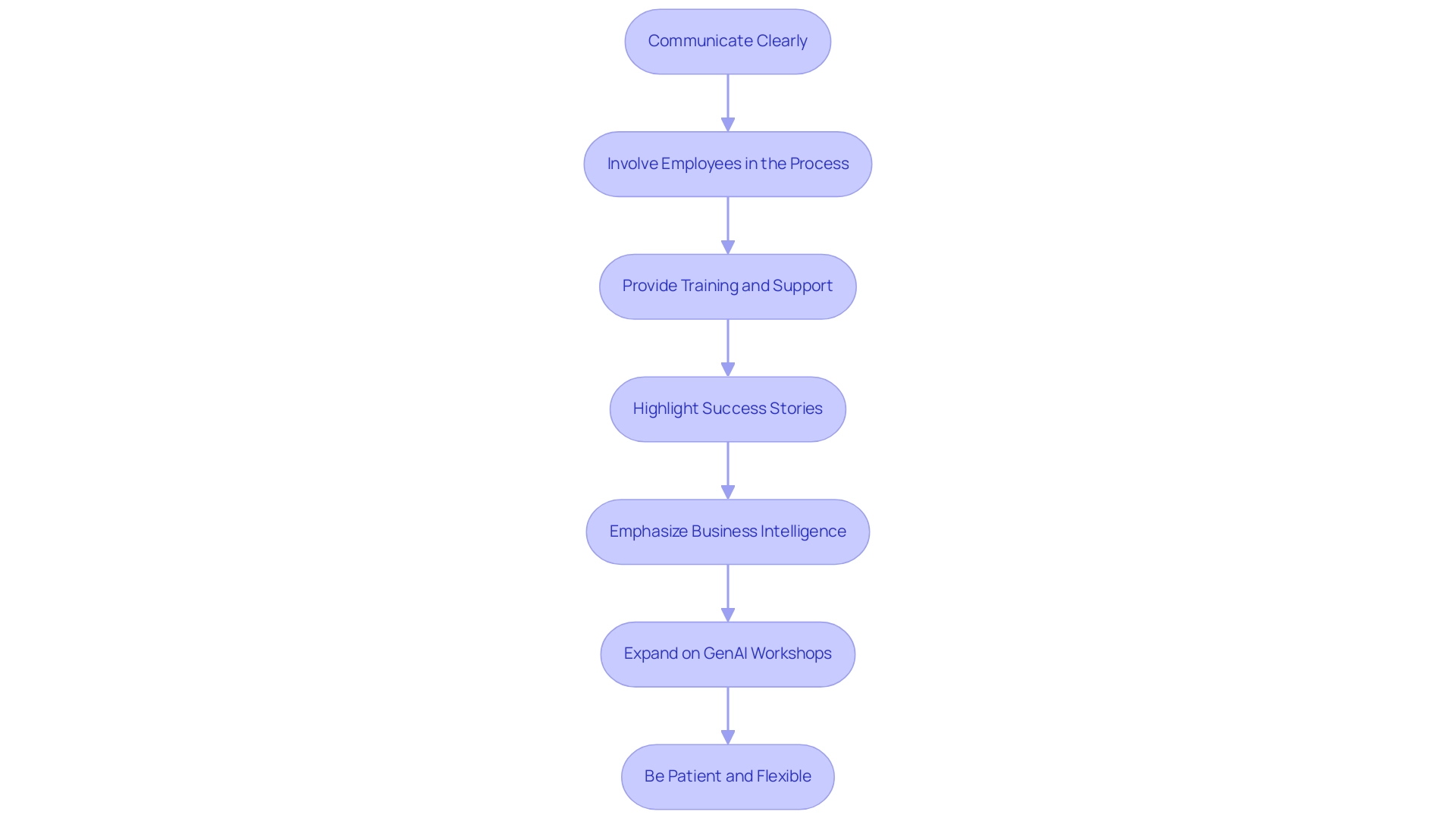
Preparing for Full-Scale Implementation
-
Review PoC Outcomes: Analyze the results of the Proof of Concept (PoC) thoroughly. Determine strengths, weaknesses, and areas for enhancement to ensure the approach aligns with your business objectives and tackles any challenges encountered during implementation.
-
Develop an Implementation Plan: Create a comprehensive plan outlining the steps to roll out the AI system across your organization. This plan should include timelines, required resources, and key responsibilities, ensuring that the integration of RPA enhances operational efficiency.
-
Engage Stakeholders: Maintain continuous communication with stakeholders throughout the implementation process. Their ongoing support will be crucial for leveraging the benefits of RPA and overcoming any challenges that arise, ensuring that the AI approach is tailored to meet your specific business needs.
-
Monitor and Adjust: Once the AI system is implemented, closely monitor its performance. Be ready to make modifications based on practical usage and input from users, ensuring that the approach stays effective in generating data-driven insights and efficiency in operations. Business Intelligence plays a key role here, as it can help transform raw data into actionable insights, facilitating informed decision-making.
-
Foster a Culture of Continuous Improvement: Encourage a mindset of continuous improvement by regularly evaluating the AI system’s performance and exploring opportunities for enhancements. Highlight how RPA can alleviate the burden of manual, repetitive tasks, thus contributing to this culture of improvement. This approach will help your organization adapt to the rapidly evolving AI landscape and maintain a competitive edge.
By following these steps, organizations can effectively transition from a PoC to a full-scale implementation of AI solutions, driving innovation and operational efficiency while overcoming technology implementation challenges.
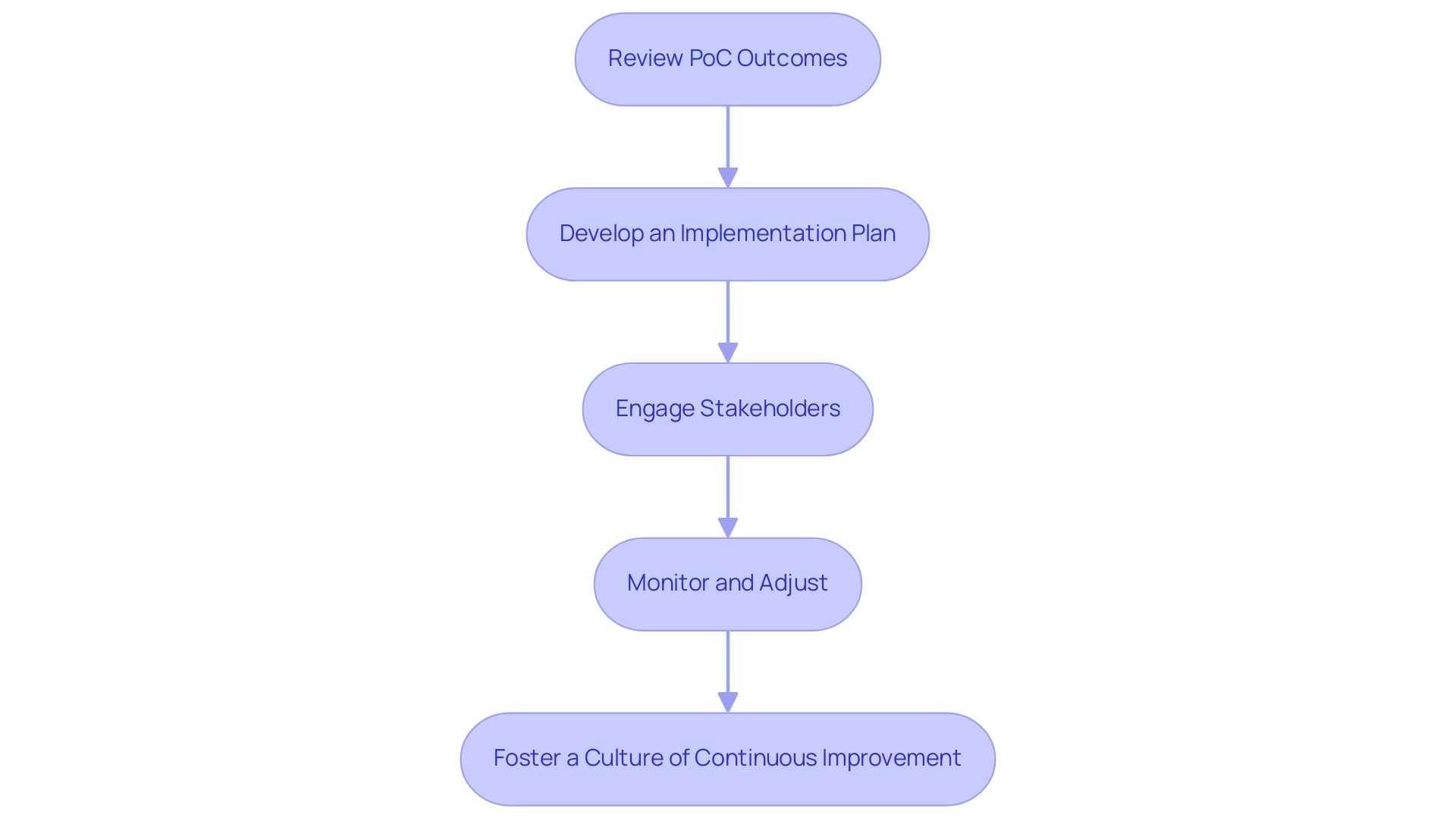
Conclusion
Embracing AI Proof of Concepts (PoCs) is a strategic move that enables organizations to validate solutions before committing to extensive implementations. By following a structured approach—defining clear objectives, assembling the right team, selecting appropriate technologies, and testing prototypes—businesses can confidently navigate the complexities of AI adoption. Each step is crucial for addressing common challenges and ensuring that the AI initiatives are aligned with organizational goals.
Key metrics such as accuracy, time savings, cost reduction, user adoption rate, and return on investment serve as essential benchmarks for evaluating the success of AI integrations. By closely monitoring these indicators, organizations can make informed decisions that drive productivity and enhance operational efficiency. Moreover, overcoming resistance to change through effective communication, training, and highlighting success stories fosters a culture of acceptance and readiness for innovation.
The transition from a PoC to full-scale implementation is not just a technical shift; it is a transformative journey that requires careful planning and stakeholder engagement. By reviewing outcomes, developing comprehensive implementation plans, and fostering continuous improvement, organizations can create a robust framework for leveraging AI technologies. This proactive approach not only mitigates risks but also positions businesses to harness the full potential of AI, ultimately unlocking new avenues for growth and innovation.
The time to act is now; embracing AI through PoCs can lead to significant advancements in operational efficiency and strategic success.
Introduction
In an age where efficiency reigns supreme, mainframe automation emerges as a transformative force, redefining how organizations operate. As companies grapple with the complexities of outdated systems and the demands of a fast-paced market, the strategic implementation of automation technologies becomes essential. From robotic process automation (RPA) to artificial intelligence (AI), the tools available today not only streamline operations but also enhance accuracy and scalability.
However, the path to successful automation is fraught with challenges, including resistance to change and integration complexities. This article delves into the myriad benefits of mainframe automation, explores the key technologies driving this evolution, addresses the hurdles organizations face during implementation, and highlights future trends that promise to shape the landscape. By understanding and navigating these elements, businesses can unlock new levels of efficiency and innovation, positioning themselves for sustained success in an increasingly competitive environment.
Defining Automation in Mainframe Systems
Automation in mainframe systems represents a strategic shift toward executing tasks with minimal human oversight, significantly enhancing operational efficiency. A mid-sized company faced challenges such as:
- Manual information entry errors
- Slow software testing
- Difficulties integrating outdated systems without APIs
By streamlining repetitive tasks such as information entry, report creation, and system oversight through graphical user interface processes, the company attained significant enhancements. They reported:
- A 70% reduction in entry mistakes
- A 50% acceleration in software testing
- An 80% improvement in workflow efficiency, achieving a return on investment within just six months.
In 2024, organizations implementing robotic process automation (RPA) in their mainframe environments have seen a 30% reduction in processing time for routine tasks. Tools like EMMA RPA and Microsoft Power Automate specifically address these challenges by streamlining workflows and minimizing errors, which enhances employee morale.
As Craig Stedman, an industry editor, points out, ‘Business users typically engage in the process to ensure that information meets their needs and to assist in establishing internal standards and usage policies as part of governance programs.’ This collaborative method promotes a culture of information governance and improves overall system effectiveness. Companies that prioritize data governance and quality in their strategies are better positioned to adapt to evolving business needs, ultimately driving greater business value.
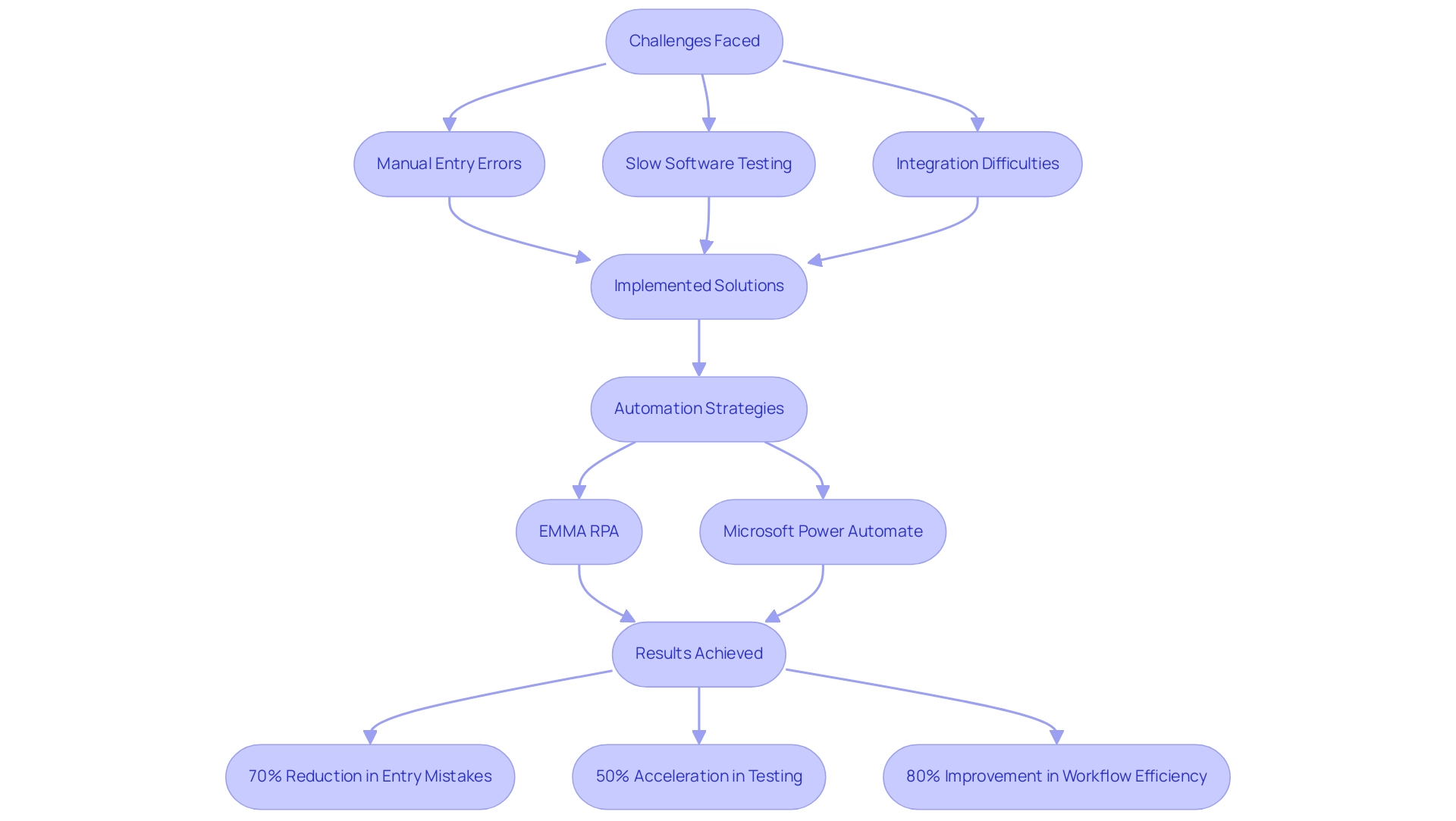
The Importance and Benefits of Mainframe Automation
The importance of mainframe optimization, especially via Robotic Process Automation (RPA), is crucial for organizations looking to improve efficiency. By embracing automation, businesses can unlock a range of substantial benefits:
-
Cost Reduction: Automating processes significantly decreases reliance on manual labor, leading to considerable savings in operational expenditures. In fact, a recent study indicates that organizations adopting mainframe technology can expect cost savings of up to 30% by 2024. For instance, companies utilizing BlueprintCPQ’s cloud-based solutions have reported notable reductions in IT overhead, with some seeing savings of over $100,000 annually.
-
Enhanced Accuracy: Automation reduces human error, ensuring consistent and precise information processing. A case study involving a mid-sized healthcare company demonstrated that implementing GUI automation reduced data entry errors by 70%, showcasing the importance of accuracy in maintaining trust in operational data and decision-making.
-
Increased Speed: Tasks that previously required hours or even days can now be executed within minutes, granting entities the agility to adapt swiftly to market demands. The same case study highlighted that automated software testing processes were accelerated by 50%, significantly improving workflow efficiency.
-
Improved Compliance: Automated systems assist entities in adhering to regulatory standards, thereby mitigating the risks associated with non-compliance, which can be costly and damaging to reputation.
-
Scalability: With mechanization, businesses can effortlessly scale operations to accommodate growth without necessitating significant additional resources, ensuring they stay ahead of evolving market dynamics.
Before implementing RPA, many companies faced significant challenges, including high manual labor costs, frequent errors, and slow response times. The current landscape underscores the necessity of continuous innovation in CPQ solutions to align with changing customer preferences. Industry insights from Interactive Selling Systems (ISS), a pioneer in CPQ technology since 1983, emphasize that ‘streamlining is not just an enhancement; it is a crucial element for succeeding in today’s competitive environment.’ The strategic implementation of RPA and tailored AI solutions in mainframe systems positions organizations to not only improve efficiency and reduce costs but also to drive forward-thinking innovations.
A compelling case study of BlueprintCPQ illustrates these benefits effectively. By leveraging their cloud-based CPQ solution, a manufacturing client reported a 25% reduction in pricing errors, leading to faster sales cycles and increased customer satisfaction. This example emphasizes how mechanization not only lowers expenses but also improves overall business performance, reinforcing the essential role that RPA and Business Intelligence play in informed decision-making and efficiency.
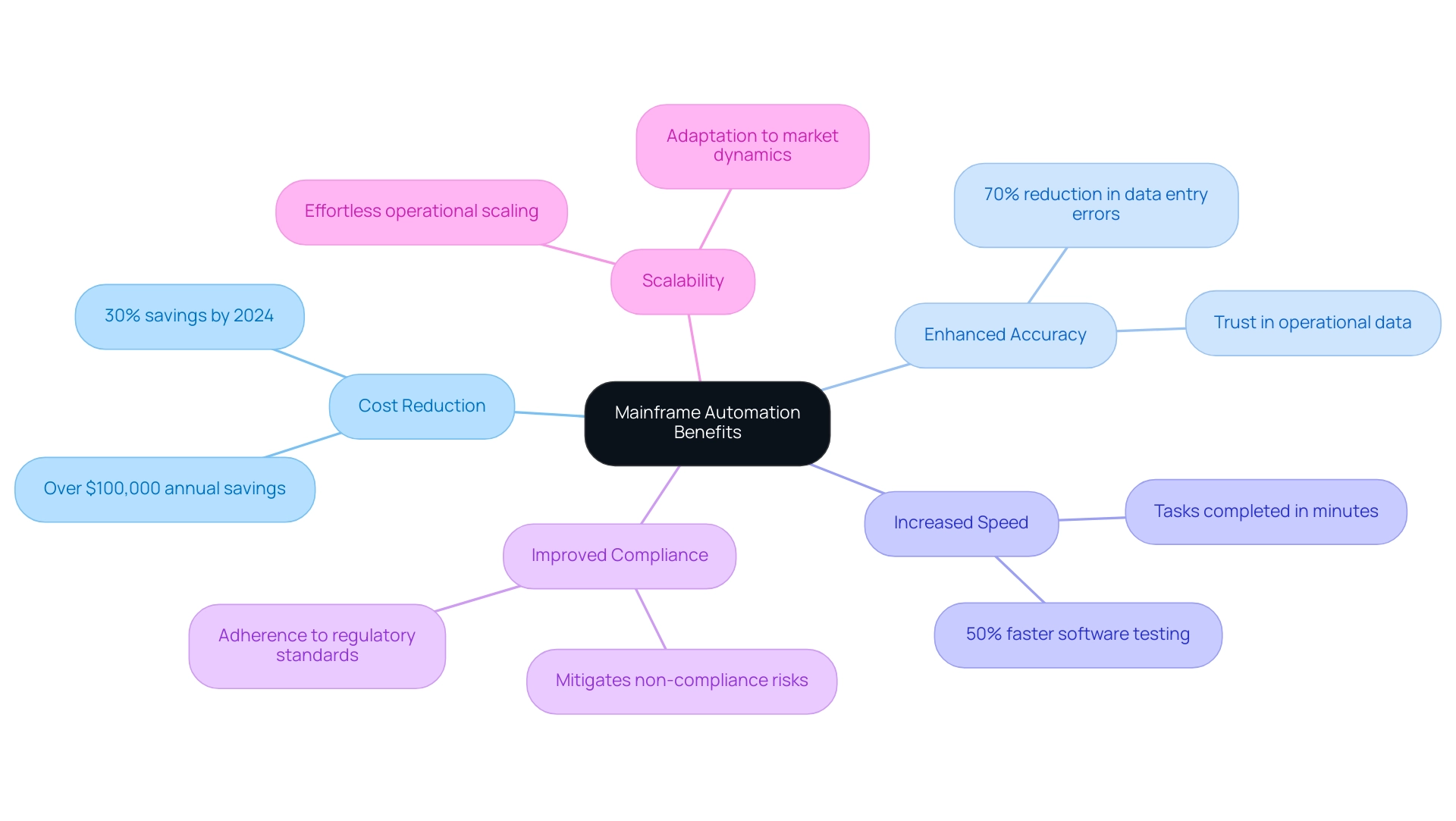
Key Technologies in Mainframe Automation
The landscape of automation in mainframe systems is powered by several key technologies that are essential for optimizing operations:
-
Robotic Process Automation (RPA): RPA tools, such as EMMA RPA and Microsoft Power Automate, excel at automating repetitive tasks by mimicking human actions. These innovative solutions enhance efficiency, improve employee morale, and address challenges such as task repetition fatigue and staffing shortages. EMMA RPA, for example, transforms processes by offering a user-friendly interface that facilitates seamless digitalization, enabling organizations to minimize errors and enhance productivity. Recent statistics indicate that the market share of RPA tools is expected to reach 30% by 2024, showcasing their growing importance in operational efficiency. This capability not only accelerates processing times but also minimizes the potential for errors, leading to enhanced accuracy in operations.
-
Artificial Intelligence (AI): AI technologies significantly enhance automation efficiency by allowing systems to learn from past information and make informed decisions. Our customized AI solutions, including Small Language Models and GenAI Workshops, enable companies to tackle challenges such as inadequate master information quality and perceived AI complexities. Small Language Models offer efficient data analysis while ensuring enhanced privacy, and GenAI Workshops provide hands-on training for custom GPT creation. According to industry experts, AI’s role in mainframe management is crucial for organizations aiming to streamline processes and react more dynamically to changing operational demands. Significantly, Thomas Rutter highlights that “AI can change conventional methods, enabling smarter, more adaptable systems.”
-
Mainframe Automation Tools: Tailored software solutions specifically designed for mainframe environments facilitate the automation of critical tasks such as job scheduling, resource management, and system monitoring. Recent developments in these tools have introduced enhanced features that improve user experience and operational control. By utilizing these advanced solutions, enterprises can ensure that their mainframe operations run smoothly and efficiently.
-
Cloud Integration: The integration of mainframe systems with cloud services offers remarkable flexibility and scalability. This synergy enables the creation of more dynamic solutions that can adjust to the changing requirements of the business environment. By utilizing cloud capabilities, entities can improve their efficiency strategies, ensuring they stay competitive in a swiftly evolving environment.
By utilizing these advanced technologies and remaining updated on the latest trends, entities can create a thorough system that not only improves their mainframe operations but also positions them for increased efficiency and competitiveness in the market.
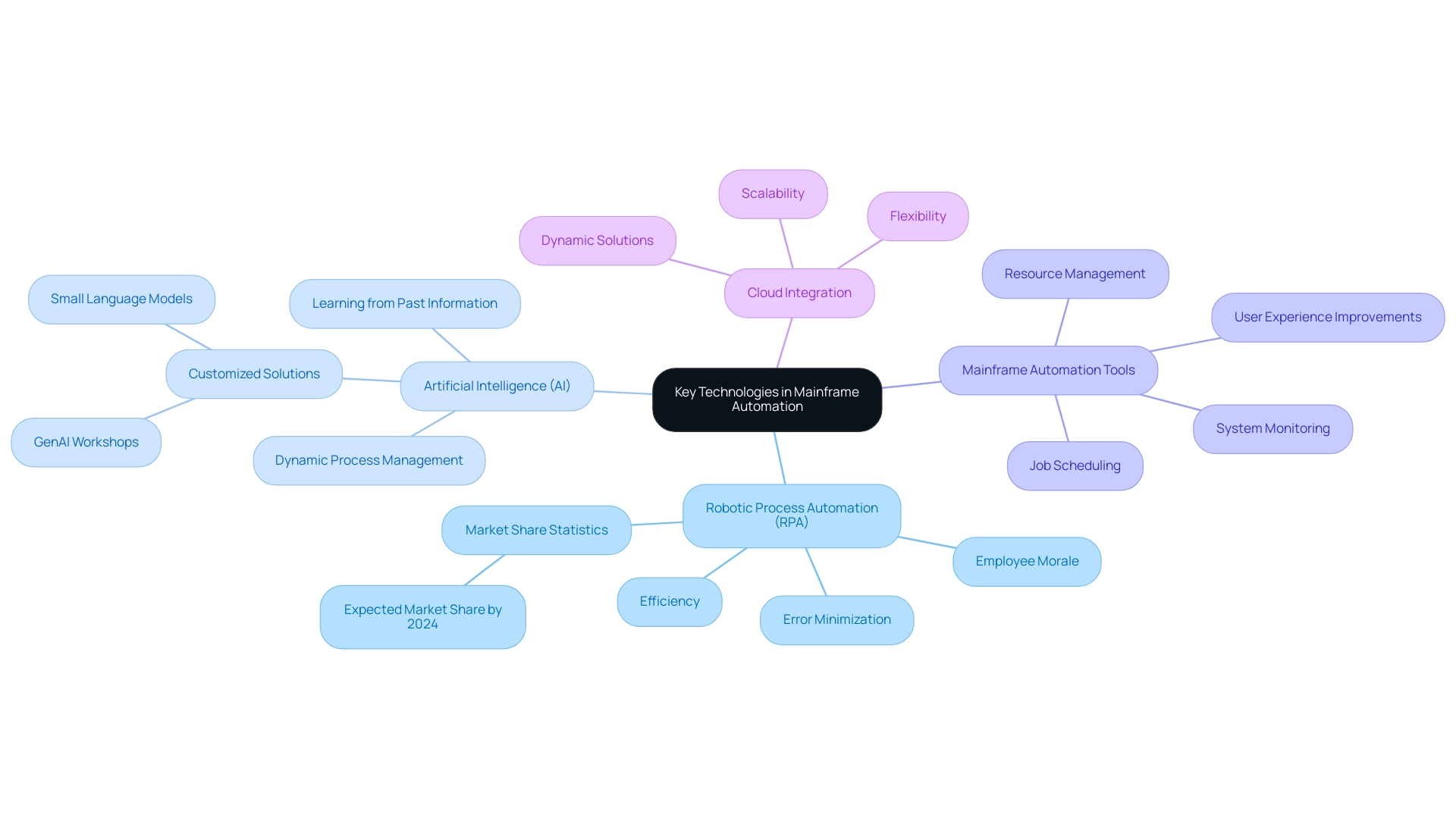
Challenges in Implementing Mainframe Automation
Despite the clear advantages of mainframe automation, organizations often face a series of challenges during implementation that must be effectively managed:
-
Resistance to Change: Employee apprehension about adopting new technologies can pose a significant barrier, with around 60% of employees expressing concerns regarding mechanization in their workplaces as of 2024. Implementing robust change management strategies is crucial to fostering a culture of resilience and encouraging acceptance among staff. For example, one organization successfully navigated this challenge by actively involving employees in the process, ultimately reducing resistance by 40%.
-
Integration Complexities: The technical challenges of incorporating automated tools with existing mainframe systems require careful planning and comprehensive testing. This ensures compatibility with legacy frameworks and minimizes disruptions. Industry experts indicate that nearly 70% of mechanization initiatives fail due to integration issues, underscoring the necessity for meticulous preparation.
-
Skill Gaps: The swift advancement of technological innovations often leaves organizations facing skill shortages. Investing in focused training and development programs is essential to prepare teams with the necessary skills to manage and utilize new technological solutions effectively. Automation specialist Dr. Linda Carter emphasizes, “Organizations must prioritize upskilling their workforce to keep pace with technological advancements.”
-
Cost Considerations: While mechanization can yield significant long-term savings, the initial costs can be substantial. Organizations should conduct a thorough evaluation of the return on investment for mechanization initiatives, carefully balancing upfront expenses against anticipated future benefits. This evaluation should also consider the potential for RPA to streamline workflows, reduce errors, and ultimately enhance operational efficiency.
-
Role of Business Intelligence: In addition to RPA, leveraging Business Intelligence tools is essential for informed decision-making. These tools can convert raw data into actionable insights, assisting organizations in evaluating the effectiveness of their initiatives and making strategic adjustments as necessary.
Addressing these challenges proactively is essential for paving the way for successful mainframe process initiatives. As mentioned by Jason Bloomberg, with legislative frameworks like the Digital Resilience Act (DORA) influencing mandates, operations teams must rise to the challenge and cultivate resilience in their processes, leveraging RPA and tailored AI solutions to enhance efficiency and combat workplace challenges.
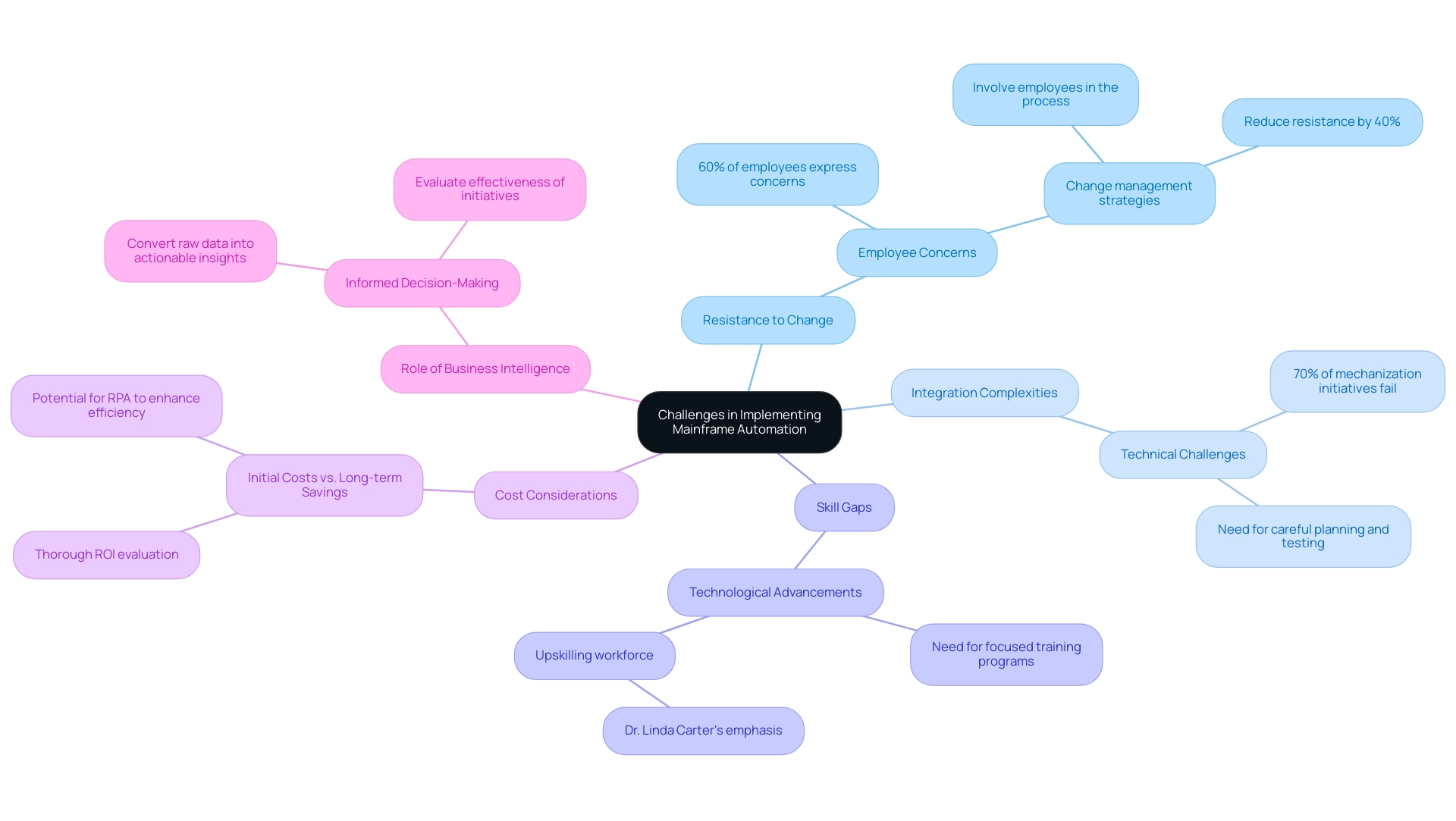
Future Trends in Mainframe Automation
As technology rapidly advances, several trends are set to shape the future of mainframe automation, providing entities new opportunities for efficiency and growth:
-
Increased AI Integration: The adoption of AI in automation tools is poised to revolutionize decision-making processes, enabling the development of smarter, more adaptive systems. Recent statistics reveal that IBM’s self-service digital assistant handled 5.4 million interactions across 77 countries, showcasing the impact of AI in enhancing operational efficiency. Mario Schlener, a leader in global risk technology, stresses this transition:
As enterprises enhance the use of AI within their firms, it is crucial to have trust in the information and models that inform their analyses and decisions.
Such confidence is essential as entities adopt AI-driven processes and address issues related to inadequate master data quality and perceived complexities in AI integration. -
Growth of Low-Code and No-Code Platforms: These platforms are democratizing access to process improvements, empowering non-technical users to create and implement workflows independently. For instance, platforms like Mendix and OutSystems have gained traction in companies, allowing teams to streamline operations without extensive programming knowledge. This shift expands the range of automated solutions accessible within organizations, making it simpler than ever to improve efficiency and tackle integration challenges.
-
Enhanced Data Analytics: The incorporation of advanced analytics into automated processes will aid in process optimization and provide deeper insights into operations. This capability can drive significant efficiency gains and inform strategic decision-making, highlighting the importance of Business Intelligence in driving data-driven insights for organizational growth.
-
Focus on Cybersecurity: As automated processes proliferate, the need for robust cybersecurity measures will become increasingly paramount. Organizations must prioritize securing their system frameworks to protect sensitive data and maintain functional integrity.
-
Generative AI Solutions: As highlighted by Per Falck Jensen from NTT Data Business Solutions, their proactive approach to implementing generative AI solutions reflects the industry’s shift towards more innovative process strategies. This trend is essential for remaining competitive in a changing market and utilizing generative AI for strategic management and competitive edge.
-
Robotic Process Automation (RPA): RPA directly tackles the challenges of task repetition and operational inefficiencies, which are often viewed as obstacles to streamlined processes. By automating manual workflows, RPA not only boosts efficiency but also reduces the time and costs associated with traditional processes. This enables organizations to conquer the hesitation to embrace AI by showcasing rapid successes and concrete advantages.
By staying aware of these trends, organizations can effectively utilize the full potential of mainframe technology and customized AI solutions, positioning themselves for success in the future. For instance, firms like EY are already leveraging the Confidence Index methodology enabled by watsonx. Governance to enhance risk management in AI solutions, which underscores the vital role of confidence in navigating future automation landscapes.
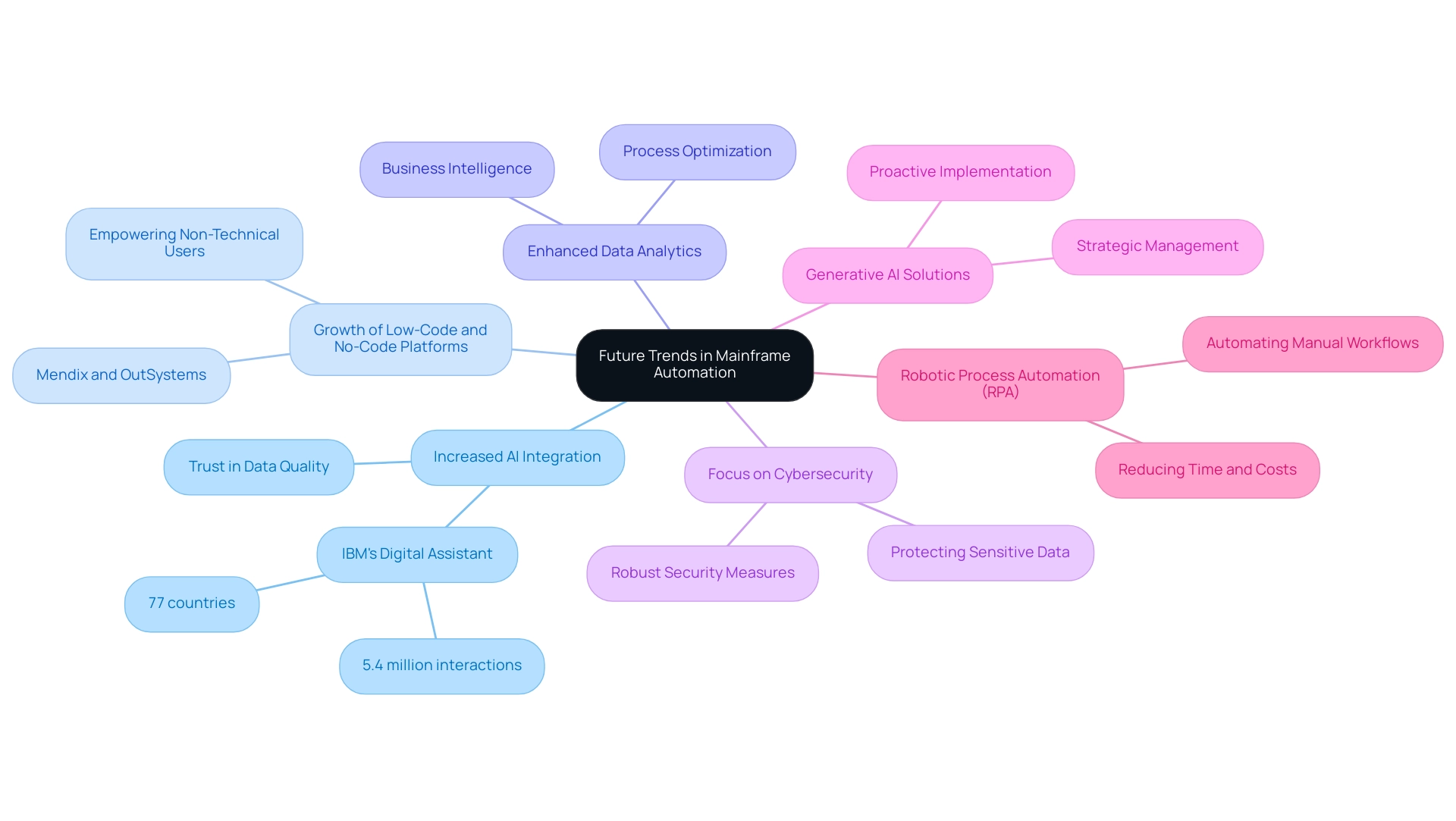
Conclusion
Mainframe automation is not just a technological upgrade; it is a strategic imperative for organizations aiming to thrive in today’s fast-paced marketplace. By leveraging tools such as Robotic Process Automation (RPA) and artificial intelligence (AI), businesses can significantly enhance operational efficiency, reduce costs, and improve accuracy across their processes. The successful implementation of these technologies can lead to remarkable outcomes, including substantial reductions in manual errors and accelerated task completion times, ultimately driving greater business value.
However, the journey toward automation is not without its challenges. Organizations must address resistance to change, integration complexities, and skill gaps while also ensuring a robust change management strategy. By proactively overcoming these hurdles, companies can cultivate a culture of innovation and resilience that embraces automation as a cornerstone of operational success.
Looking ahead, the future of mainframe automation promises exciting developments, including increased AI integration, the rise of low-code and no-code platforms, and enhanced data analytics capabilities. These trends will empower organizations to streamline their operations further and adapt to evolving market demands. By staying attuned to these advancements and strategically implementing automation solutions, companies can position themselves for sustained success and competitiveness in an ever-changing business landscape.
Embracing automation is not just about keeping pace; it is about leading the charge toward a more efficient, innovative future.
Introduction
In an industry where speed and efficiency are paramount, the role of automation in telecommunications has emerged as a game-changer. As organizations grapple with the complexities of modern networks and the demands of an increasingly digital landscape, embracing automation is no longer optional—it’s essential. From reducing manual errors to accelerating service provisioning, automation technologies like Robotic Process Automation (RPA) and advanced AI solutions are transforming operations, enabling telecom companies to respond swiftly to market needs and enhance customer satisfaction.
With projections indicating a significant rise in automation adoption, the time is ripe for businesses to harness these tools, streamline processes, and unlock new levels of operational efficiency. This article delves into the transformative power of automation in telecommunications, exploring its benefits, challenges, and future trends that will shape the industry’s landscape.
Defining Automation in Telecommunications
Automation in telecommunications embodies the strategic use of technology to carry out tasks that once demanded human intervention, ranging from network configuration and fault management to service provisioning. A notable case study involving a mid-sized company demonstrated that they faced significant challenges, including:
- Manual information entry errors
- Slow software testing
- Difficulty integrating outdated systems without APIs
By utilizing GUI tools, they enhanced operational efficiency through automated data entry and software testing, leading to a significant 70% decrease in data entry mistakes and a 50% increase in testing speed. With projections indicating that over 70% of telecommunications companies will implement some form of mechanization by 2024, this shift is crucial for enhancing service delivery and responding swiftly to market demands.
Industry expert Jane Doe emphasizes, ‘Automation is no longer a luxury but a necessity for telecom companies aiming to stay competitive in an ever-evolving landscape.’ The emergence of technologies such as EMMA RPA and Microsoft Power Automate has further transformed operations, facilitating user-friendly digitalization and smooth business process management.
EMMA RPA specifically addresses the challenge of manual data entry by automating repetitive tasks, while Power Automate streamlines workflows by connecting various applications and services. These tools not only minimize human error but also enhance productivity, empowering organizations to meet customer expectations with greater accuracy and speed.
By adopting mechanization, companies can cultivate a more robust working environment, as demonstrated in the case study where the incorporation of mechanization resulted in a 30% decrease in service delivery time, highlighting the overall effect of mechanization on efficiency.
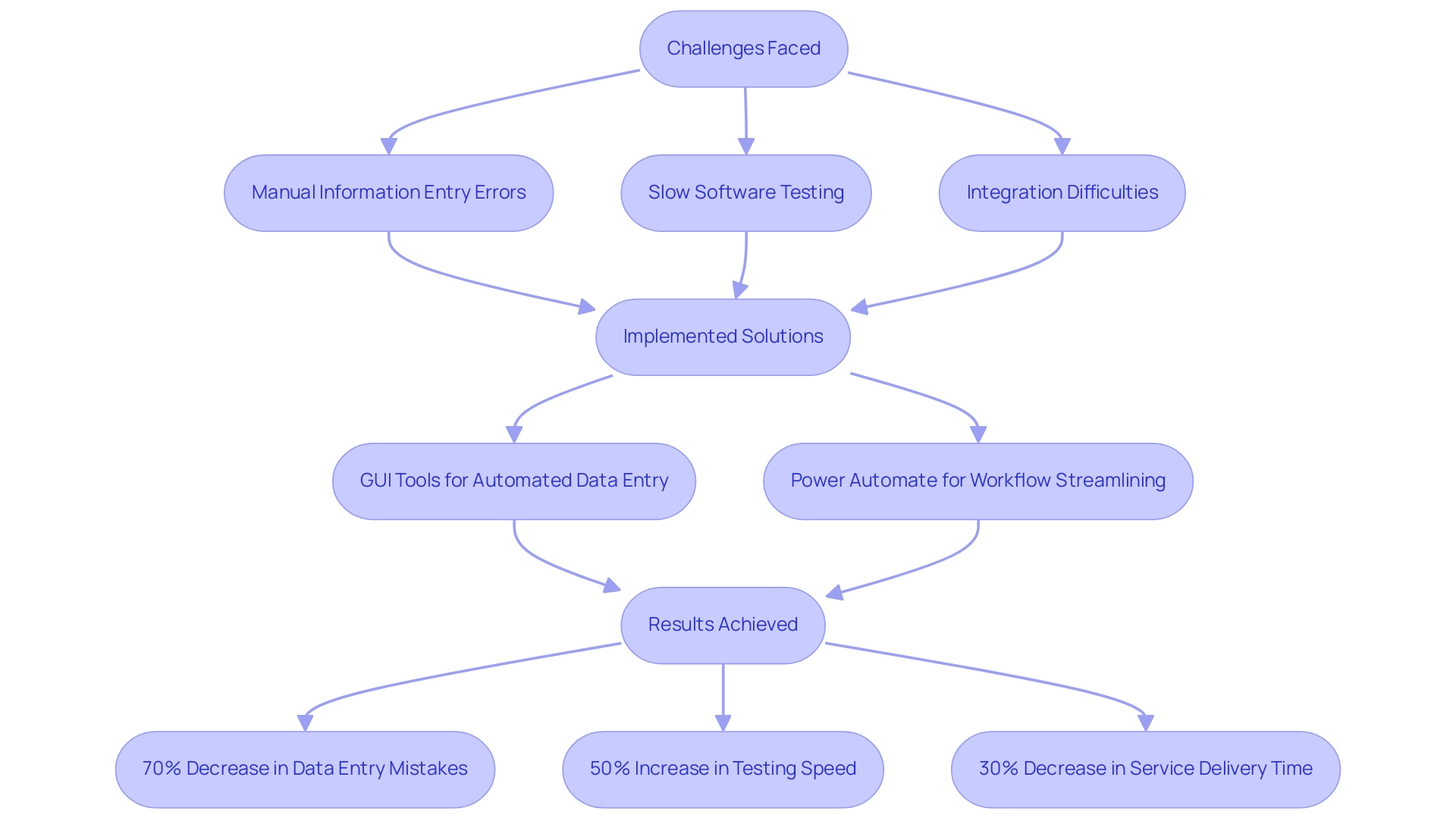
The Benefits of Automation in Telecommunications
The advantages of mechanization in telecommunications are multifaceted and essential in today’s rapidly evolving AI landscape.
Firstly, it leads to significant operational efficiencies by streamlining processes and reducing the time required for task completion. For instance, automated network monitoring can identify issues in real-time, allowing for quicker resolutions that enhance service quality.
Additionally, leveraging Robotic Process Automation (RPA) can result in substantial cost savings by minimizing the need for manual labor and reducing errors that lead to costly downtime.
Furthermore, the integration of mechanization and tailored AI solutions empowers businesses to unlock powerful insights through Business Intelligence, facilitating informed decision-making that drives growth and innovation.
In a competitive environment, failing to utilize these data-driven insights can leave businesses at a disadvantage.
Ultimately, these enhancements lead to faster response times and consistent performance, resulting in improved customer satisfaction.
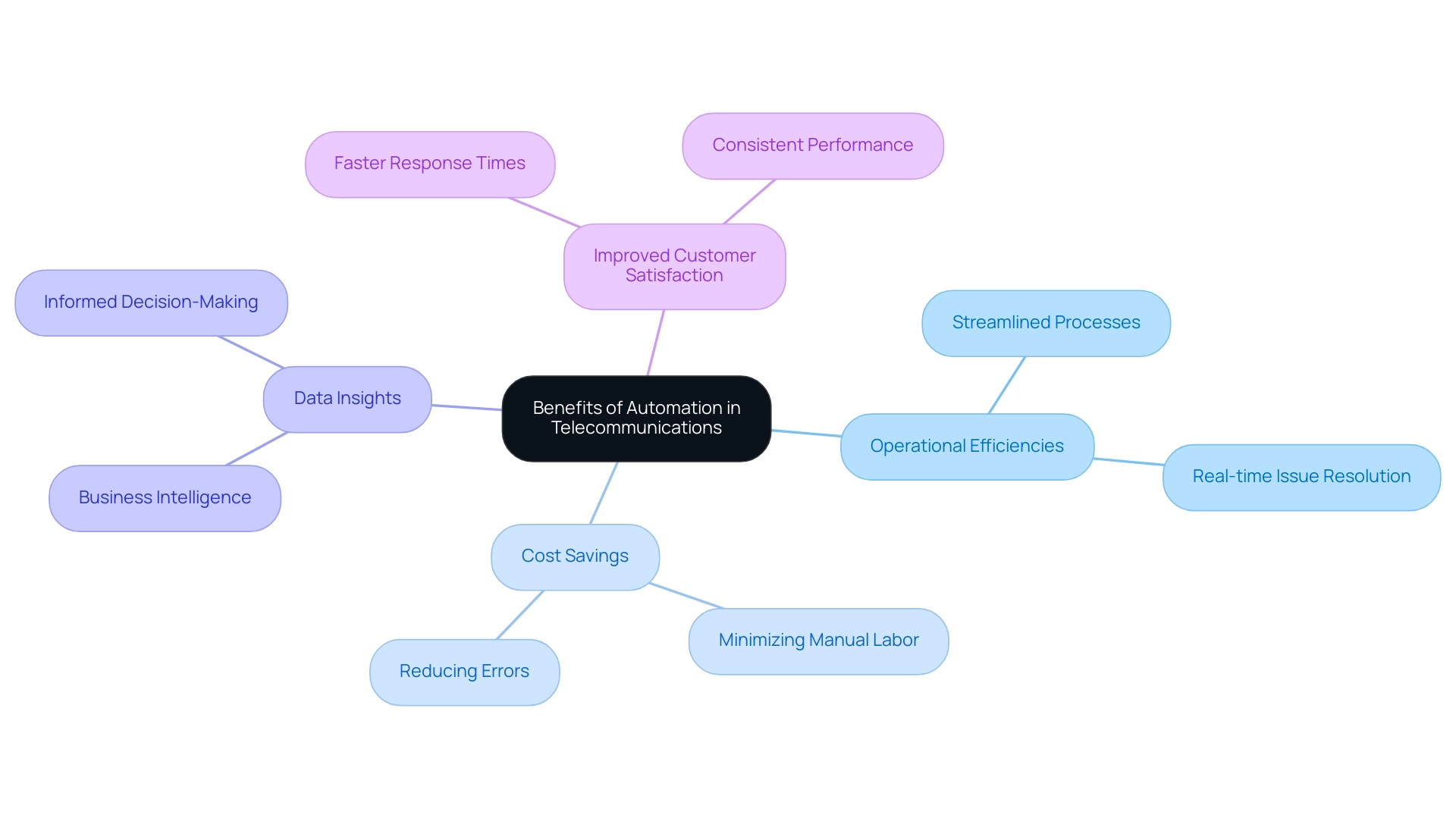
Navigating New Complexities in Network Automation
As telecommunications networks develop, organizations encounter new challenges in their operational journeys. Integrating legacy systems with contemporary control tools, ensuring robust cybersecurity measures, and managing the extensive data generated by automated processes are critical challenges. Furthermore, resistance from employees accustomed to traditional methods can hinder progress.
To effectively address these challenges, companies should invest in comprehensive training and change management strategies. Our GenAI workshops focus on personalized customer experiences and ethical AI usage, while our hands-on training equips your team with the practical skills needed to implement and manage AI solutions effectively.
Additionally, our RPA solutions empower businesses by streamlining repetitive tasks and fostering a culture that embraces innovation and technological advancement. With a risk-free ROI-driven strategy, we guarantee a seamless shift to more efficient processes, maximizing productivity and minimizing burdens.
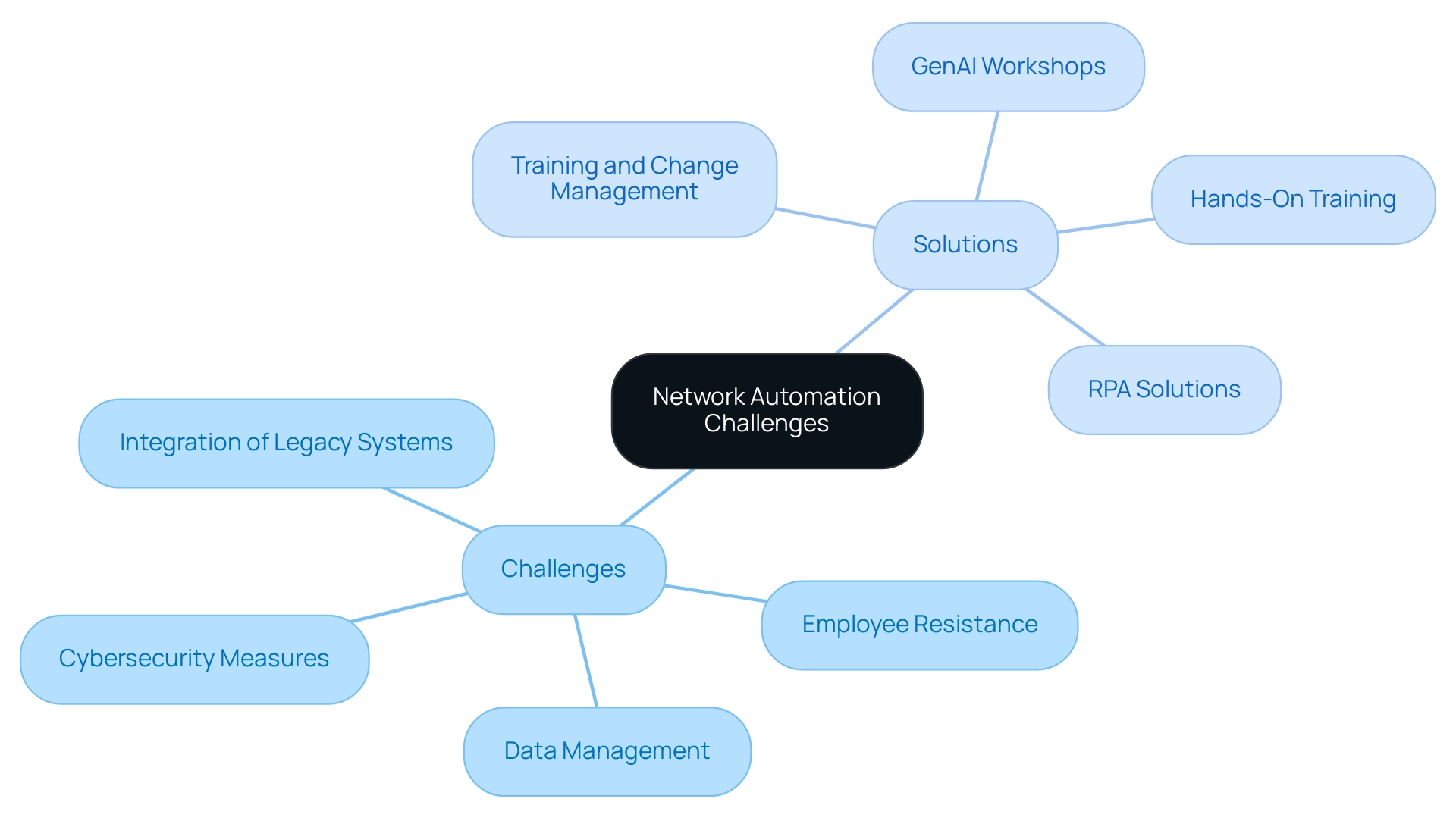
The Role of AI and Intelligent Automation in Telecommunications
AI and smart technology are essential for transforming communication operations. By leveraging machine learning algorithms and advanced analytics, companies can optimize network performance, predict maintenance requirements, and personalize customer interactions. Tools like EMMA RPA and Microsoft Power Automate streamline manual workflows, addressing challenges such as:
- Task repetition fatigue
- Staffing shortages
This boosts efficiency and reduces errors, ultimately enhancing employee morale. For example, AI-driven chatbots efficiently manage customer inquiries, allowing human agents to focus on complex issues. This integration of AI not only enhances efficiency but also nurtures innovative services that set companies apart in a competitive marketplace, ensuring they remain ahead in a rapidly evolving landscape.
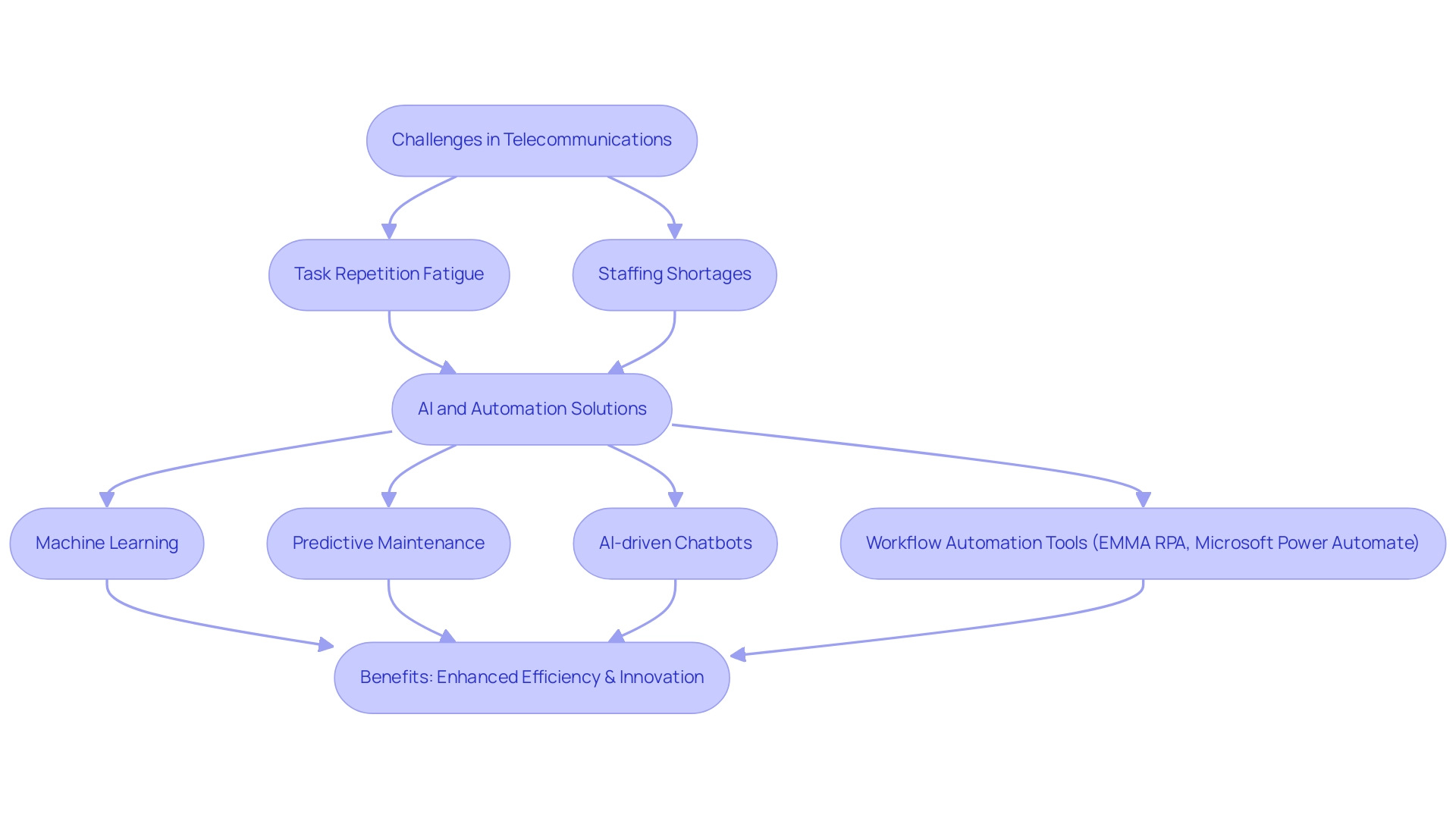
Future Trends and Strategic Impacts of Automation in Telecommunications
The evolution of mechanization within telecommunications is poised for a significant acceleration, primarily driven by advancements in AI, machine learning, and IoT technologies. As network complexity escalates and service demand intensifies, leveraging Robotic Process Automation (RPA) becomes essential for enhancing scalability and operational efficiency while also delivering substantial cost savings.
A pivotal trend is the advent of 5G technology, which not only facilitates faster information transfer but also necessitates innovative automation solutions to manage the surge in traffic and connectivity effectively. For instance, Hadrian X, the world’s first autonomous bricklaying robot, demonstrates this potential, functioning 95% quicker and up to 90% less expensive by utilizing 5G networks for rapid information processing. As Kashyap Vyas aptly notes, ‘Hadrian X does its job effortlessly, as it can quickly process massive amounts of information transferred over a 5G network.’
Moreover, 5G technology significantly enhances healthcare through applications like remote surgery and quick access to patient data, which are crucial for improving decision-making and potentially saving lives. The shift towards edge computing will also require refined automation strategies to optimize resource allocation and elevate performance.
Additionally, the strategic impacts of tailored AI solutions and Business Intelligence on the sector will shape the industry’s future landscape. Business Intelligence plays a critical role in transforming raw data into actionable insights, enabling informed decisions that drive growth. Companies that proactively adopt these trends will not only enhance their operational capabilities through RPA but will also position themselves as leaders in the telecommunications sector, driving innovation and competitive advantage into 2024 and beyond.
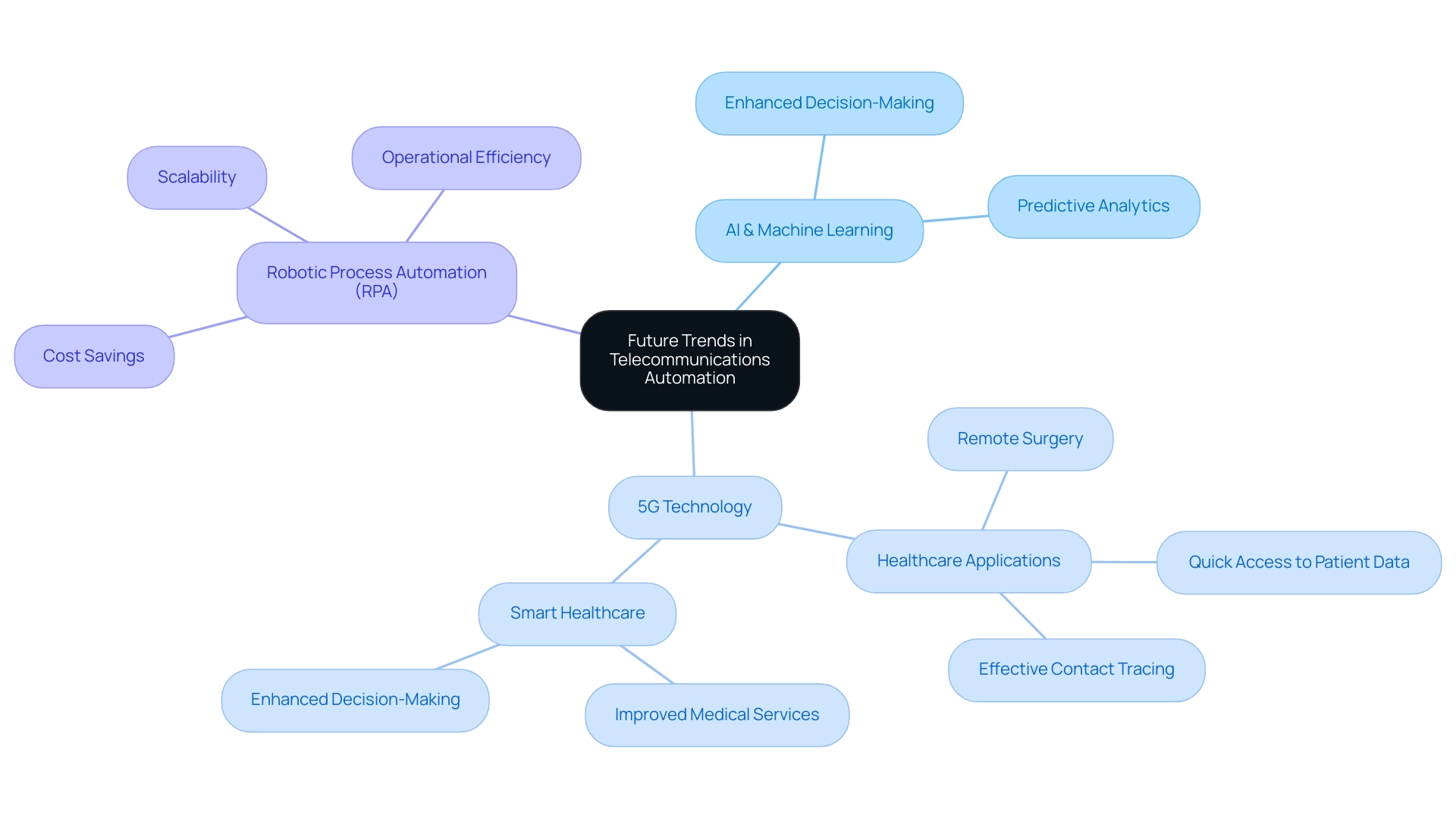
Conclusion
Embracing automation in telecommunications is no longer a choice but a necessity for companies aiming to thrive in a rapidly changing environment. By strategically implementing automation technologies such as Robotic Process Automation (RPA) and AI solutions, organizations can significantly enhance operational efficiency, reduce manual errors, and accelerate service delivery. The case studies highlighted demonstrate how automation can lead to remarkable improvements, including a 70% reduction in data entry errors and a 50% acceleration in software testing processes.
However, the journey toward automation is not without its challenges. Integrating legacy systems, ensuring robust cybersecurity, and managing employee resistance are critical hurdles that need to be addressed. By investing in comprehensive training and change management, companies can foster a culture that embraces innovation and effectively harness the benefits of automation.
Tools like EMMA RPA and Microsoft Power Automate are instrumental in streamlining workflows and enhancing productivity, ultimately leading to improved customer satisfaction.
Looking ahead, the future of telecommunications will be shaped by the continued evolution of automation technologies, especially with the rise of 5G and edge computing. These advancements not only promise enhanced operational capabilities but also the potential for groundbreaking services that can redefine customer experiences and drive growth. By proactively adopting these trends and leveraging intelligent automation, telecommunications companies can position themselves as leaders in the industry, driving innovation and maintaining a competitive edge well into the future.
The time to act is now—embracing automation is the key to unlocking unparalleled efficiency and success in the telecommunications landscape.
Introduction
In the rapidly evolving landscape of artificial intelligence, the role of a Certified AI Consultant has emerged as a cornerstone for organizations striving for operational excellence. These professionals are not just tech experts; they are strategic partners who harness the power of AI to transform business processes, enhance efficiency, and drive growth. By tailoring solutions to meet specific organizational needs, Certified AI Consultants navigate the complexities of AI adoption, ensuring that companies can leverage innovative technologies like Robotic Process Automation (RPA) and Business Intelligence effectively.
As industries across the board recognize the immense potential of AI, understanding the qualifications, skills, and real-world applications of these consultants becomes essential for any organization aiming to stay competitive in a data-driven world. This article delves into the critical aspects of AI consulting, from defining the consultant’s role to exploring certification programs and showcasing transformative case studies that highlight the tangible benefits of engaging with certified professionals.
Defining the Role of a Certified AI Consultant
A Certified AI Consultant excels in optimizing business operations by harnessing the transformative power of artificial intelligence. These experts are crucial in evaluating organizational requirements and creating tailored AI applications that streamline processes and improve overall efficiency. Their core responsibilities include:
- Identifying areas for AI integration
- Developing tailored strategies
- Ensuring that AI solutions align with overarching business goals
By utilizing innovative tools like EMMA RPA and Microsoft Power Automate, certified experts can tackle challenges such as:
- Task repetition fatigue
- Staffing shortages
- Outdated systems
Ultimately enhancing data quality and productivity. They act as strategic partners, skillfully maneuvering through the intricacies of AI adoption to provide quantifiable advancements, as demonstrated by a case study where GUI automation greatly improved organizational performance in a mid-sized healthcare firm, decreasing data entry mistakes by 70% and speeding up workflows by 80%. The methodologies employed included:
- Automating data entry
- Enhancing software testing
- Integrating legacy systems seamlessly
With over 1.2 million professionals now leveraging AI to advance their careers, the impact of AI on both organizational performance and individual growth is undeniable. According to Grace A., ‘I realized I was making so many mistakes on my resume that I’ve now fixed. I’m much more confident in my resume now,’ highlighting the transformative effect of AI on professional development. Recent advancements in AI consulting practices emphasize the critical need for ethical AI use and continuous learning, ensuring organizations remain at the forefront of technological innovation. Overall, certified AI consultants play a vital role in fostering operational excellence and enhancing efficiency across organizations. Schedule a complimentary consultation today to discover how our RPA offerings can transform your operations.
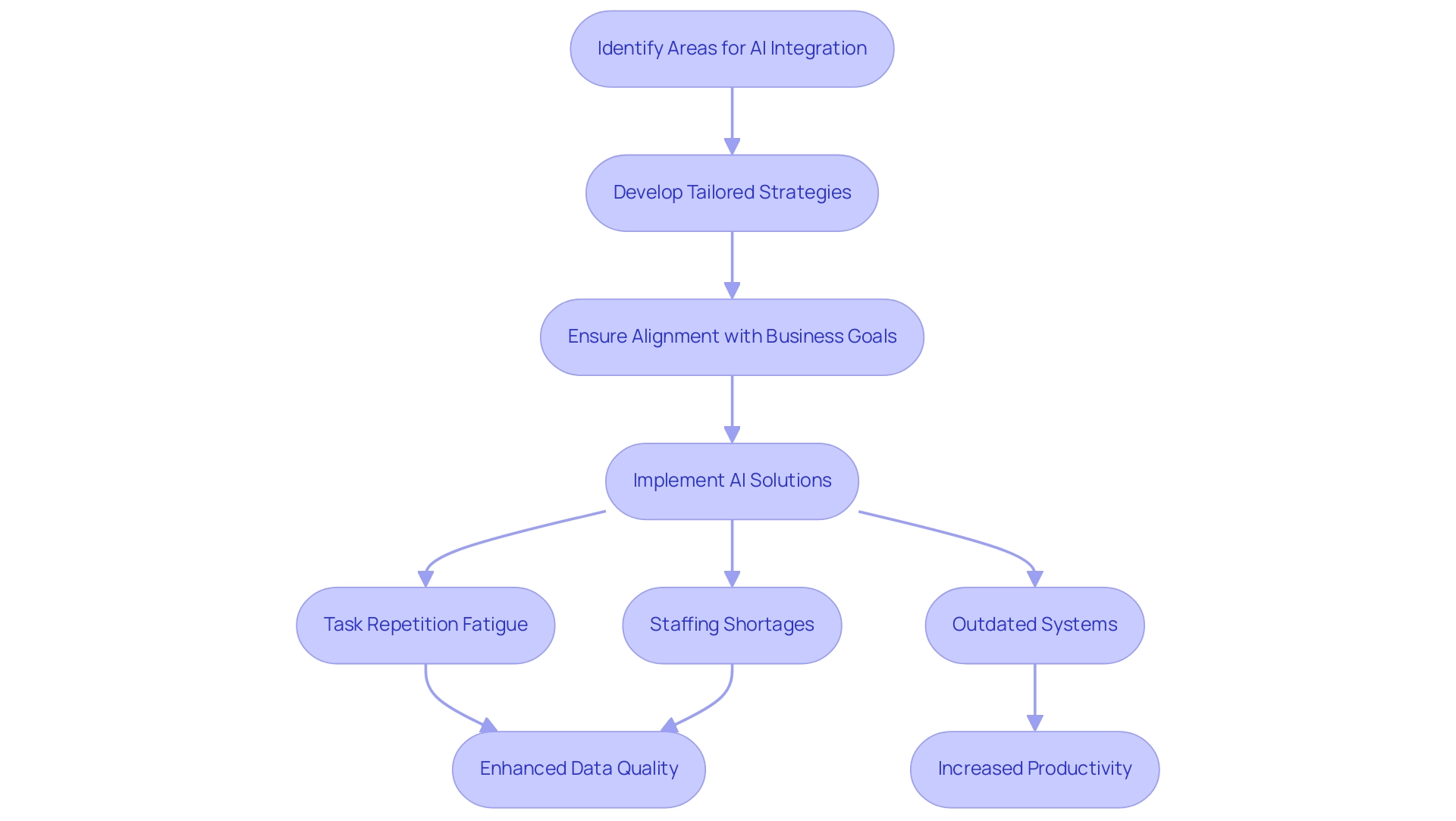
Essential Qualifications and Skills for AI Consultants
Becoming a Certified AI Consultant demands a robust educational foundation in computer science, data science, or a related discipline. Key skills required for AI consulting include:
- Mastery of machine learning algorithms
- Proficiency in programming languages such as Python and R
- A comprehensive understanding of data analytics
Somanathan C., an AI expert, highlights the significance of structured learning, stating, “I entered the course with prior knowledge of Gen AI, which helped me grasp the content easily. The material was well-structured and informative. The clear, concise explanation of new topics was the most valuable part, making it easy to understand and integrate with my existing knowledge, enhancing my learning experience.” This perspective underscores the importance of clear and concise explanations in mastering new AI topics.
Furthermore, experience in project management and a thorough grasp of business processes are indispensable for delivering effective AI solutions. Utilizing Robotic Process Automation (RPA) can also automate manual workflows, improving efficiency in a rapidly evolving AI landscape, while Business Intelligence plays a crucial role in driving data-driven insights that support business growth. For instance, companies that have implemented RPA have reported up to a 30% reduction in operational costs and a 50% decrease in processing times.
Certification from reputable institutions, such as the 11-month Artificial Intelligence Engineer program costing $1,490, enhances credibility and demonstrates a commitment to the field. However, navigating the AI landscape can be challenging due to the overwhelming number of available solutions and the rapid pace of technological advancements. The rising demand for AI experts across sectors such as healthcare, finance, retail, and manufacturing underscores the necessity for continuous learning and staying informed about the latest AI advancements. The projected increase in demand for AI professionals further emphasizes the need for individuals to acquire and refine these critical skills to succeed.
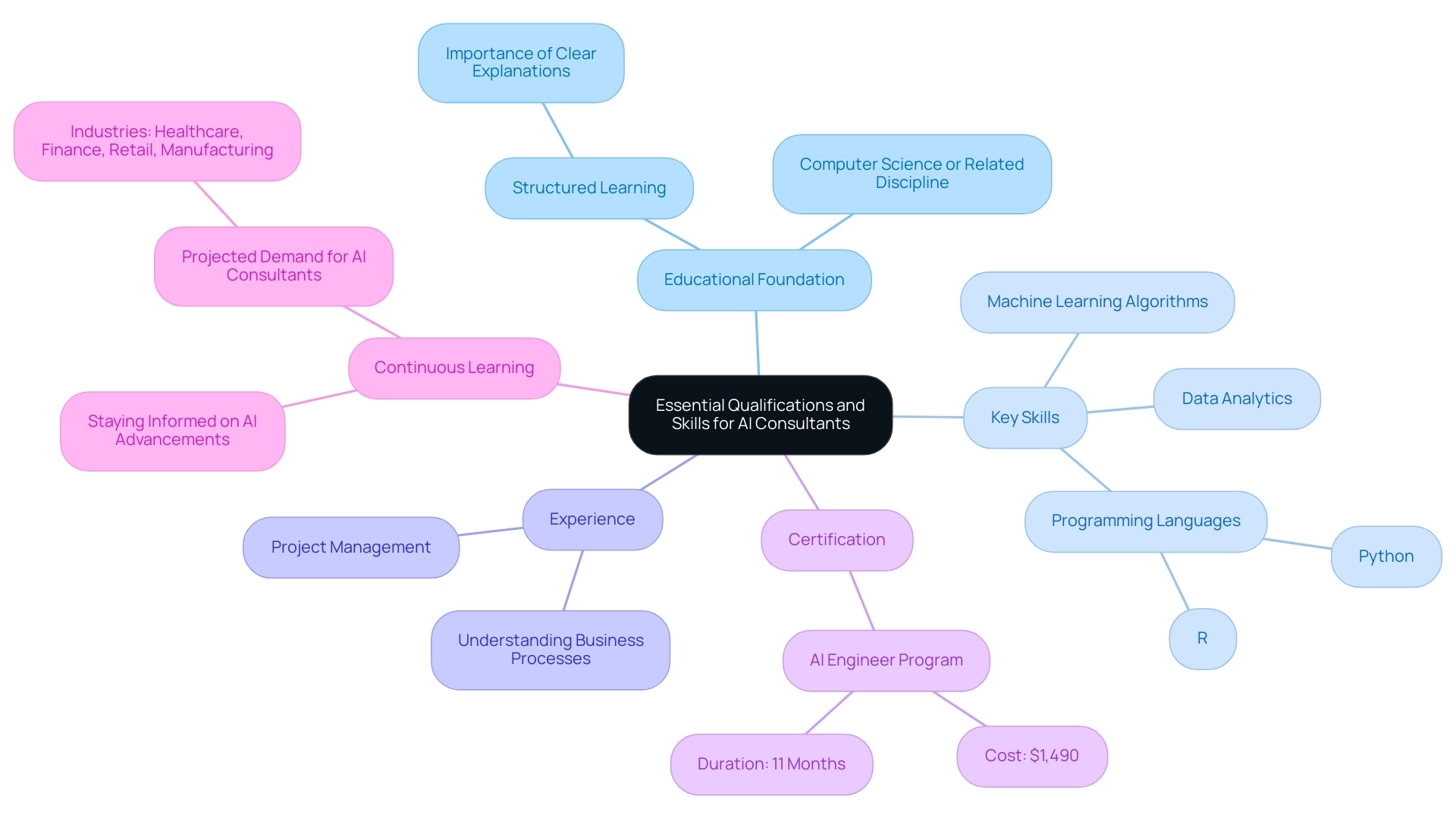
The Value of Engaging a Certified AI Consultant
Engaging a Certified AI Consultant offers transformative benefits to organizations, leveraging the skills gained through experience, which is critical as 60 percent of US workers possess practical expertise without formal degrees. As emphasized by the McKinsey Global Institute, ‘Human capital at work: The value of experience,’ these advisors provide unmatched expertise that leads to notable enhancements in performance, productivity, and decision-making.
Data from 2024 suggest that organizations employing certified AI specialists see up to a 30% rise in productivity due to the adoption of customized AI approaches and Robotic Process Automation (RPA). By streamlining workflows, reducing manual errors, and freeing up valuable resources for strategic initiatives, businesses can significantly enhance their productivity.
Furthermore, the integration of Business Intelligence is crucial, as it enables organizations to transform raw data into actionable insights, supporting informed decision-making that drives growth. The collaboration between BCG and NASA’s Ames Research Center to launch a GenAI lab underscores the innovative edge of AI consulting services.
AI specialists assist organizations in navigating the complexities of data management and analytics, enabling them to extract actionable insights that drive growth. For example, a recent case analysis showed that a manufacturing company enhanced its efficiency by 25% after adopting AI-driven predictive maintenance strategies suggested by certified advisors.
Additionally, the generative AI case study demonstrates how this technology can enhance performance, innovate rapidly, and create new business models, positioning companies as industry leaders. Addressing technology implementation challenges is also a key focus of AI experts, who provide strategies to overcome obstacles and ensure successful integration of these solutions.
Ultimately, investing in a Certified AI Consultant provides businesses with a competitive edge in today’s data-driven market, ensuring they stay at the forefront of innovation and excellence while achieving measurable enhancements in productivity.
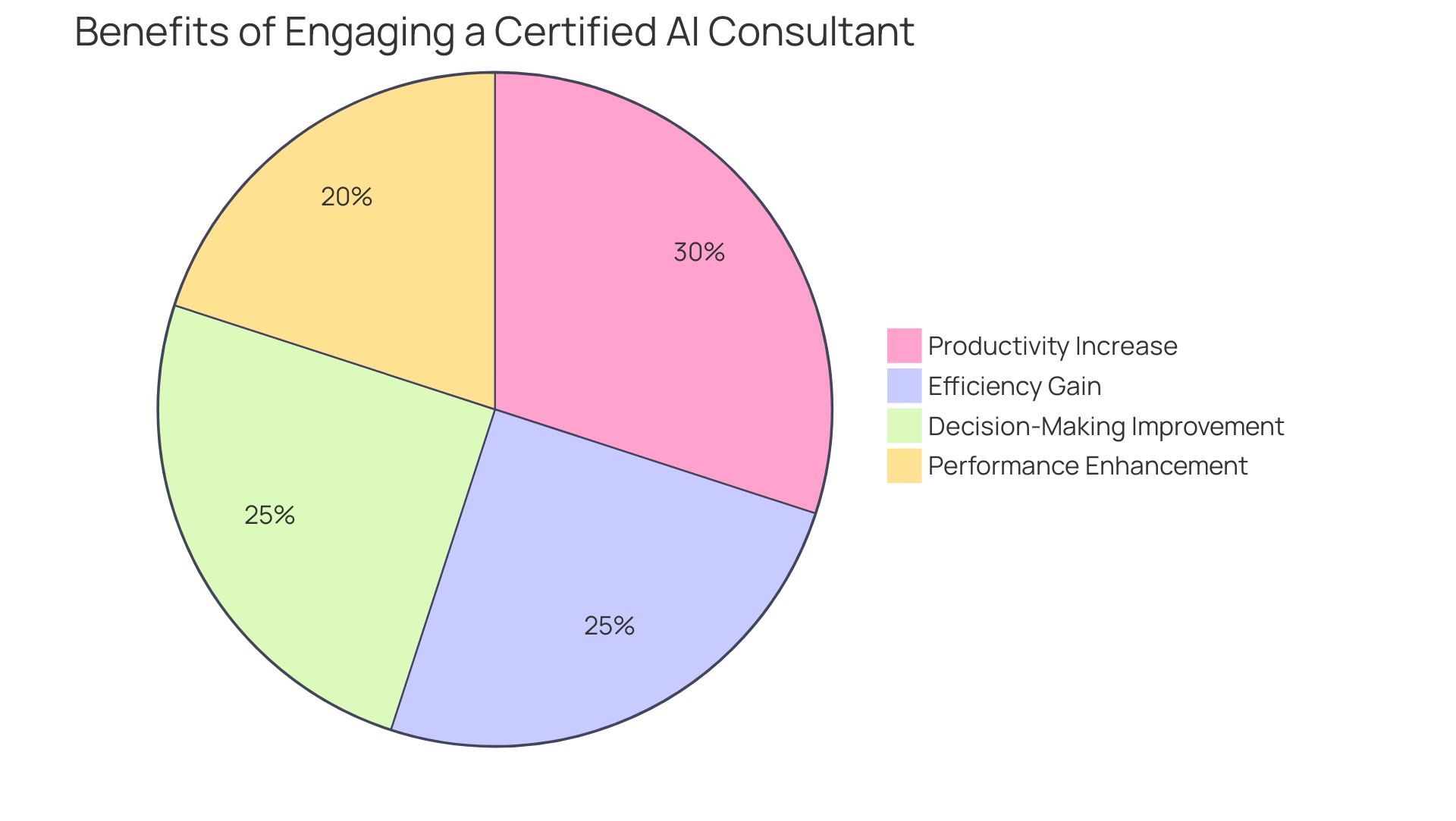
Exploring Certification Programs for AI Consultants
Aspiring AI consultants have a wealth of certification programs to choose from, each meticulously designed to equip them with the skills and knowledge needed to thrive in this dynamic field. Notable programs from the International Association of Artificial Intelligence (IAAI) and the Data Science Council of America (DASCA) are particularly esteemed, covering crucial topics such as:
- Machine learning
- Data mining
- AI ethics
These programs ensure a well-rounded education. As organizations increasingly leverage Robotic Process Automation (RPA) to automate manual workflows and enhance operational efficiency, professionals with AI certifications are better positioned to address challenges such as:
- Poor master data quality
- Common hesitations surrounding AI adoption
According to recent statistics, certified professionals can see a salary increase of up to 20% and greater job stability, underscoring their significant impact on career advancement. Gartner Peer Insights also highlights the value of these certifications, noting verified reviews from experienced IT professionals.
Furthermore, Oracle University’s collaborative Learning Community offers continuous updates on training, assisting professionals in staying ahead in leveraging customized AI tools and Business Intelligence for informed decision-making. These tailored AI solutions not only streamline processes but also enhance data-driven insights, allowing businesses to make informed decisions.
Completing a certification program not only sharpens technical skills but also significantly boosts credibility with potential employers, distinguishing candidates in a competitive job market. Real-world success stories of certified AI consultants illustrate how the right knowledge and tools can unlock new opportunities and drive business growth, particularly in addressing the complexities of AI implementation.
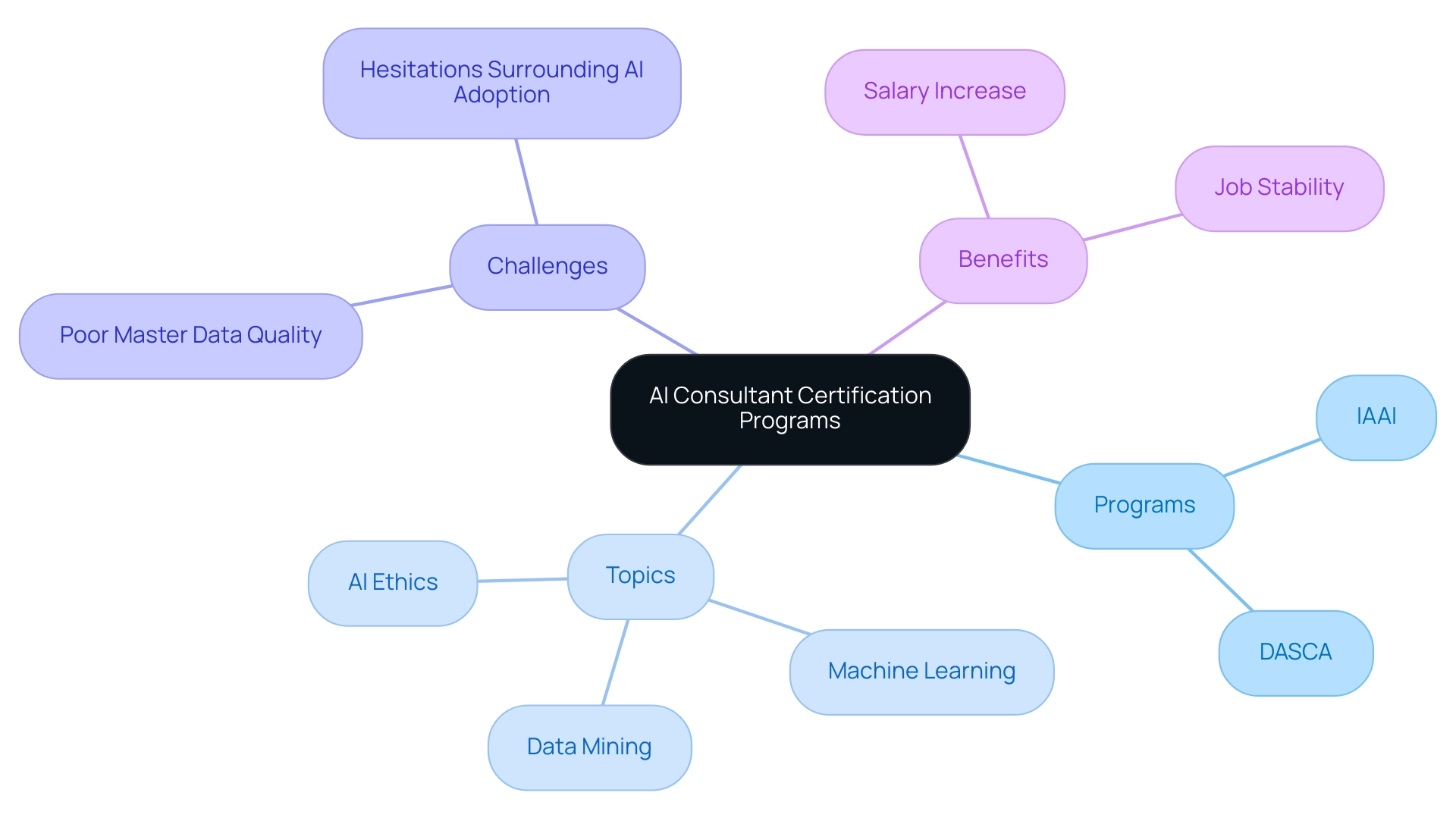
Real-World Applications of AI Consulting
AI consulting services have demonstrated transformative effects across various sectors, especially in healthcare, where improving workflow is crucial. For instance, a recent case study highlights how a mid-sized healthcare company utilized GUI automation to streamline data entry and software testing, overcoming challenges like manual errors, slow processes, and the difficulty of integrating outdated systems without APIs. This implementation not only reduced data entry errors by 70% and accelerated testing by 50%, but also improved workflow efficiency by 80%, achieving a remarkable ROI within six months. Such measurable results emphasize the effectiveness of AI advisors in customizing strategies that tackle particular business challenges.
Furthermore, RPA tools can efficiently handle repetitive tasks by automating tedious processes, reducing employee frustration and enhancing morale, while also tackling the widespread challenge of talent retention in functional departments. By modernizing outdated systems, businesses can enhance productivity and foster innovation, ensuring a strong framework that thrives in today’s competitive landscape.
As we move into 2024, it is expected that 75% of healthcare organizations will adopt AI-driven solutions, reflecting the sector’s commitment to leveraging technology for improved patient outcomes and resource allocation. Through these strategic implementations, AI consulting services continue to empower organizations in their quest for enhanced operational efficiency.
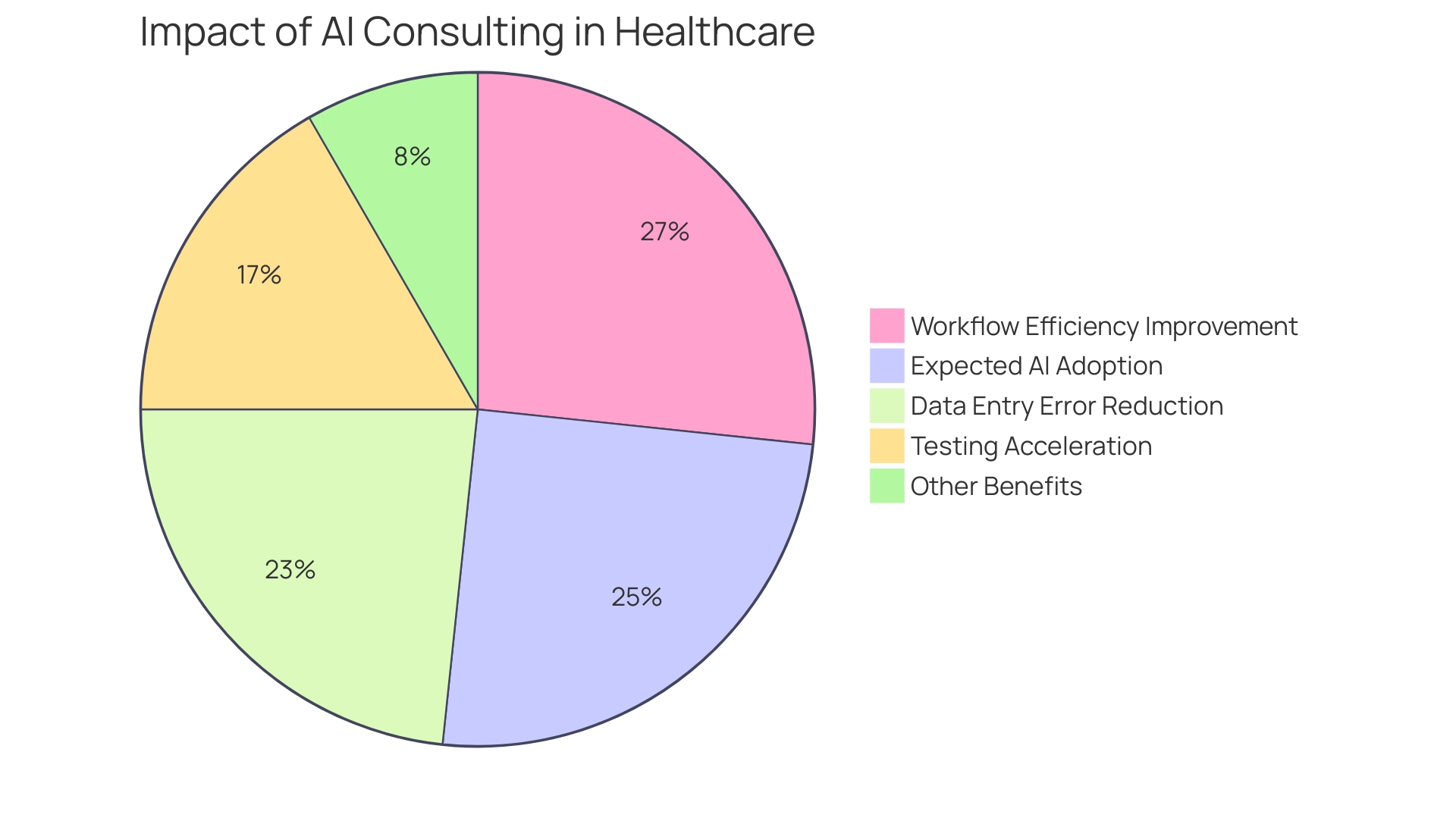
Conclusion
The emergence of Certified AI Consultants is transforming how organizations pursue operational excellence in today’s data-driven environment. These experts serve as strategic partners, tailoring AI solutions to improve efficiency and foster growth. By utilizing tools like Robotic Process Automation (RPA) and Business Intelligence, they effectively address challenges such as inefficiencies and outdated systems, resulting in significant productivity enhancements.
To thrive in this role, AI consultants need a robust educational background and a commitment to continuous learning to keep pace with rapid technological advancements. The increasing demand for certified professionals across various sectors highlights the necessity of honing essential skills for competitiveness.
Engaging a Certified AI Consultant provides organizations with substantial benefits, including improved operational efficiency and better decision-making capabilities. Data shows that businesses that leverage these consultants often experience considerable gains in productivity and reductions in costs. The successful implementation of AI-driven solutions not only streamlines workflows but also empowers organizations to make data-informed strategic decisions.
Certification programs play a crucial role in preparing future consultants with the necessary skills and knowledge. With documented success across diverse industries, the importance of AI consultants is clear for organizations seeking innovation and leadership. Investing in Certified AI Consultants is a strategic move toward achieving operational excellence and maintaining a competitive edge in the market.
Introduction
Navigating the competitive landscape of technology interviews can be daunting, particularly for aspiring NVIDIA Solutions Architects. As organizations increasingly rely on AI and cloud solutions to drive innovation, candidates must not only showcase their technical prowess but also articulate how their skills can address real-world business challenges. This article provides essential preparation strategies, common interview questions, and key technical skills to highlight, empowering candidates to present themselves as valuable assets in the ever-evolving tech ecosystem.
By equipping themselves with the right knowledge and insights, candidates can confidently approach their interviews, transforming opportunities into successful career advancements.
Essential Preparation Strategies for Your NVIDIA Solutions Architect Interview
To excel in your NVIDIA Solutions Architect assessment and effectively navigate the overwhelming AI landscape, consider the following preparation strategies:
-
Research NVIDIA’s Products and Technologies: Familiarize yourself with NVIDIA’s product lineup, including GPUs, AI solutions, and computing services. Grasping these technologies will not only equip you for the discussion but also assist you in expressing how these solutions can generate data-driven insights for businesses.
-
Understand the Role: Review the job description carefully and identify the key responsibilities and skills required. Tailor your preparation to demonstrate how your background aligns with these needs, emphasizing your understanding of how tailored AI solutions can address specific business challenges.
-
Practice Technical Skills: Brush up on technical skills relevant to the position, such as cloud architecture, machine learning frameworks, and software development principles. Use platforms like LeetCode or HackerRank to practice coding problems, ensuring that your skills reflect the capabilities necessary for leveraging Business Intelligence and RPA in operational efficiency.
-
Mock Interviews: Conduct mock interviews with peers or mentors who possess knowledge in technical interviews. This practice will help you refine your answers and gain feedback on your performance, particularly in how you can apply your knowledge of AI solutions to real-world scenarios.
-
Prepare Your Projects: Be ready to discuss your past projects, specifically how you utilized NVIDIA technologies or similar solutions. Get ready to clarify your reasoning, obstacles encountered, and results attained, connecting these instances to how they can aid Business Intelligence initiatives.
-
Behavioral Questions: Prepare for behavioral questions by using the STAR (Situation, Task, Action, Result) method to structure your responses. Reflect on your past experiences and how they relate to the competencies required for the role, especially in the context of driving data-driven insights.
-
Stay Updated on Industry Trends: Keep abreast of the latest trends in AI and GPU advancements. Referencing current developments in your discussion can showcase your passion and dedication to the field, along with your understanding of how these trends influence business efficiency and decision-making.
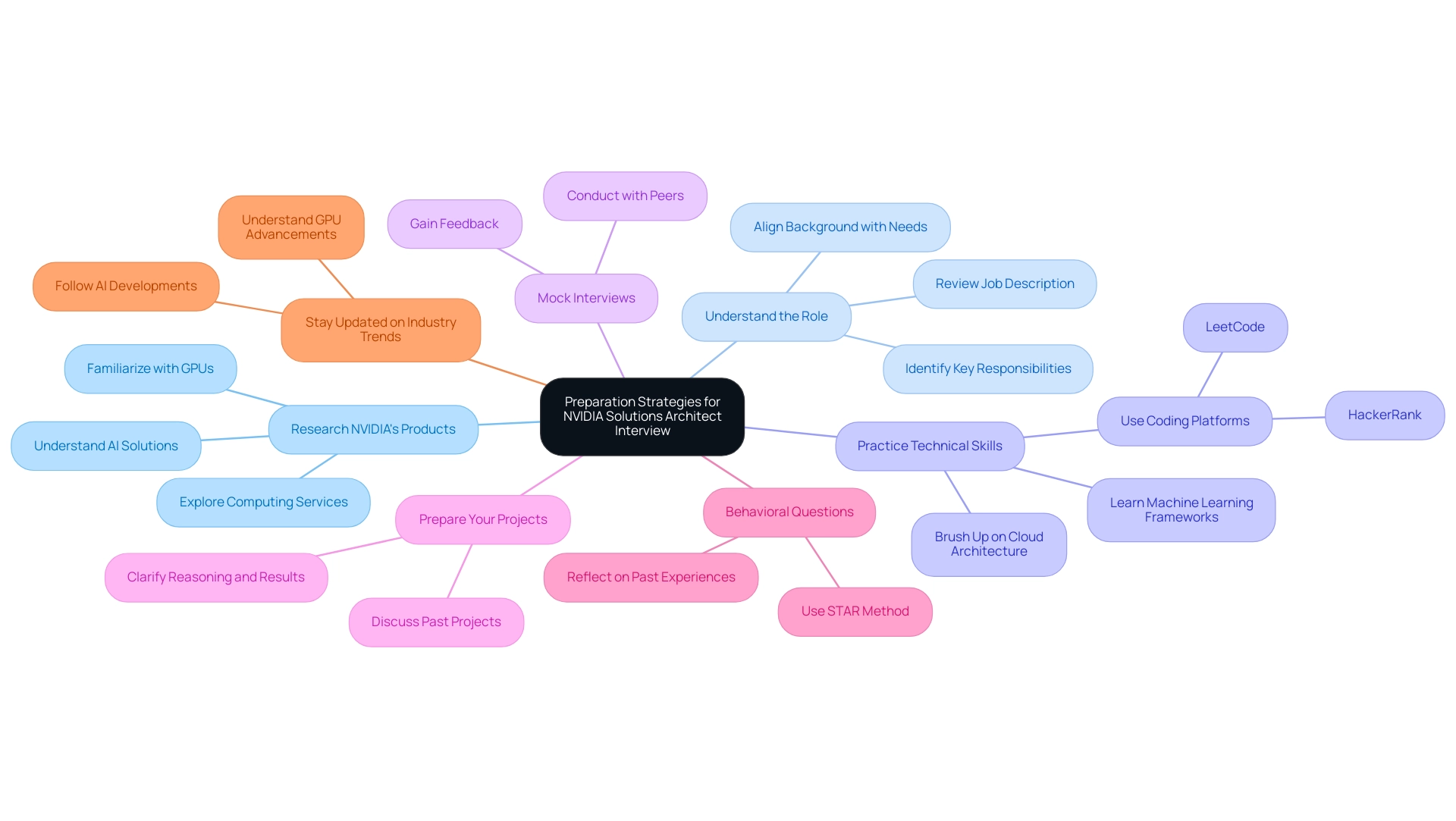
Common Interview Questions for NVIDIA Solutions Architects
In the context of AI Consulting Services, Directors of Operations Efficiency can leverage Robotic Process Automation (RPA) to automate manual workflows effectively. By streamlining operations, RPA not only enhances efficiency but also significantly reduces errors, allowing teams to focus on strategic tasks that drive business growth.
However, it is essential to recognize that overcoming technology implementation challenges is crucial in this process. Tailoring AI solutions and utilizing Business Intelligence can transform raw data into actionable insights, empowering informed decision-making. Specific tools such as EMMA RPA and Power Automate can play a pivotal role in this transformation.
During an NVIDIA Solutions Architect assessment, candidates should prepare to discuss their practical knowledge of cloud architecture, tackle challenging technical problems using structured methods, and showcase their continuous learning in AI advancements—all crucial for contributing to operational success.
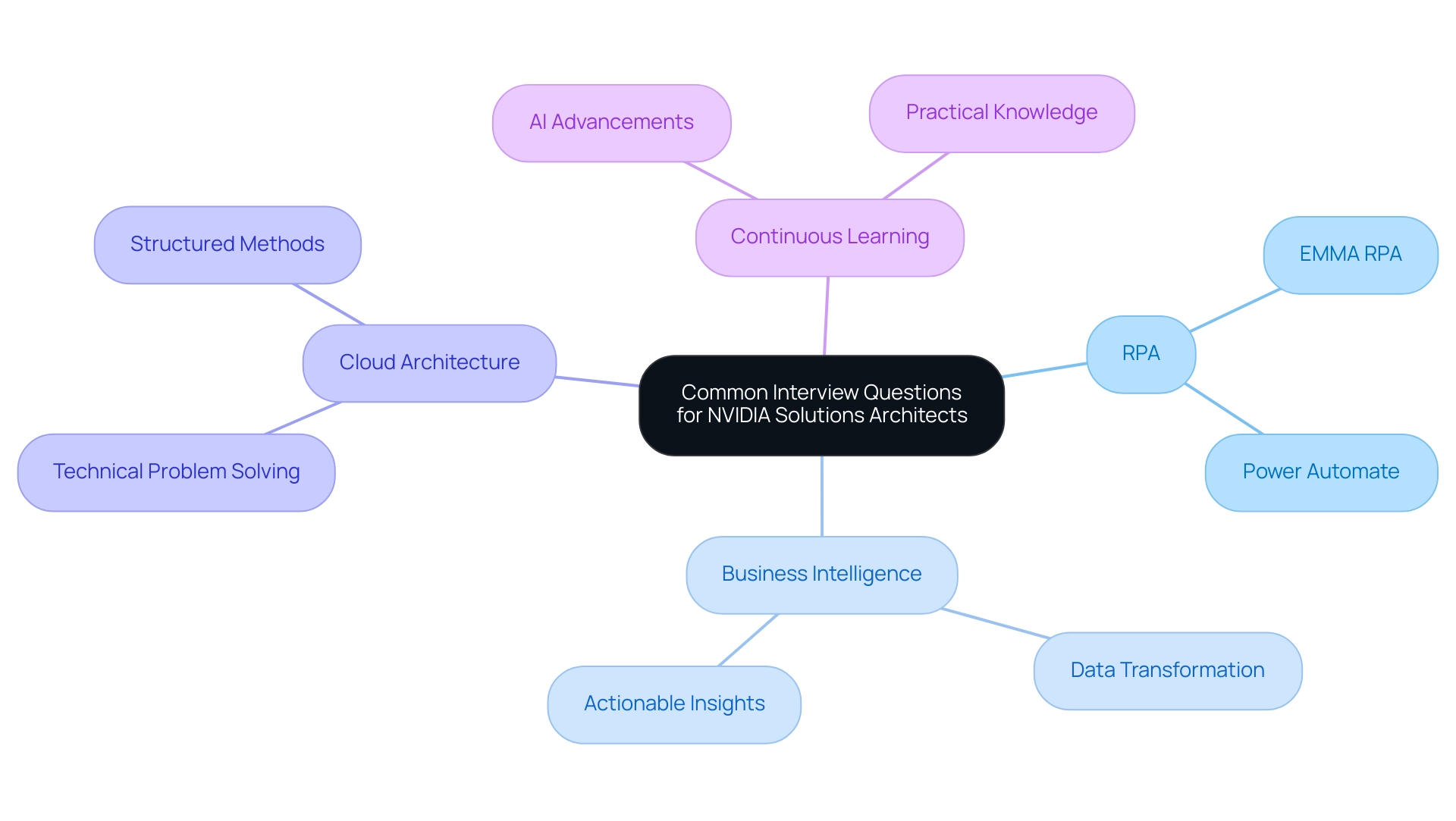
Technical Skills to Highlight in Your Interview
When preparing for your NVIDIA Solutions Architect interview, consider emphasizing the following technical skills:
-
Robotic Process Automation (RPA): Discuss your experience with RPA tools and their role in streamlining processes and enhancing operational efficiency. Highlight how RPA can automate manual workflows, reduce errors, and free up your team for more strategic tasks—an essential consideration as businesses increasingly rely on technology for productivity.
-
Business Intelligence: Emphasize the importance of Business Intelligence in transforming raw data into actionable insights. Discuss how effective data management can support informed decision-making, driving growth and innovation in your organization.
-
Cloud Computing Platforms: Mastery of computing platforms such as AWS, Azure, or Google Cloud is vital. With a 51% rise in phishing attacks hosted at subdomain providers, your expertise in architecture and deployment, combined with a solid understanding of security measures, will be crucial in safeguarding digital assets. As Ronald Reagan famously said, ‘Trust, but verify,’ which underscores the importance of ensuring security in cloud environments.
-
Machine Learning and AI: Familiarity with machine learning frameworks like TensorFlow and PyTorch, along with AI algorithms, is indispensable. Current trends indicate a growing reliance on AI to enhance business processes. Demonstrate your expertise by discussing projects where these tools were applied to solve real-world problems.
-
Software Development: Robust programming skills in languages such as Python, C++, or Java are essential. Highlight your software development background and adherence to best practices, ensuring reliability and efficiency in your solutions.
-
Data Management: Proficiency in data engineering, data pipelines, and database management systems (e.g., SQL, NoSQL) is critical. Showcase your ability to effectively manage and utilize data, which is increasingly important in optimizing operations and supporting informed decision-making.
-
Overcoming Technology Implementation Challenges: Discuss your experience in navigating and overcoming challenges associated with technology implementation. Including examples of successful projects where you addressed these challenges can demonstrate your problem-solving skills.
-
Networking and Security: A profound comprehension of network architecture, security protocols, and best practices is advantageous, especially in virtual environments. Emphasize your role in implementing security measures to protect against potential threats.
-
Communication Skills: As a Solutions Architect, conveying complex technical concepts to non-technical stakeholders is crucial. Highlight your ability to communicate effectively across diverse teams, ensuring everyone is aligned and informed.
-
Current Trends: Stay informed about the latest trends in computing and machine learning, as these areas are rapidly evolving and are critical for Solutions Architects in 2024. For instance, the shift towards hybrid cloud solutions and the integration of AI capabilities into cloud services are shaping the future of technology.
Incorporating these skills into your preparation will not only demonstrate your technical prowess but also your capacity to contribute to the evolving landscape of work and technology. Additionally, consider referencing case studies that highlight successful implementations of these skills in real-world scenarios, further solidifying your expertise.
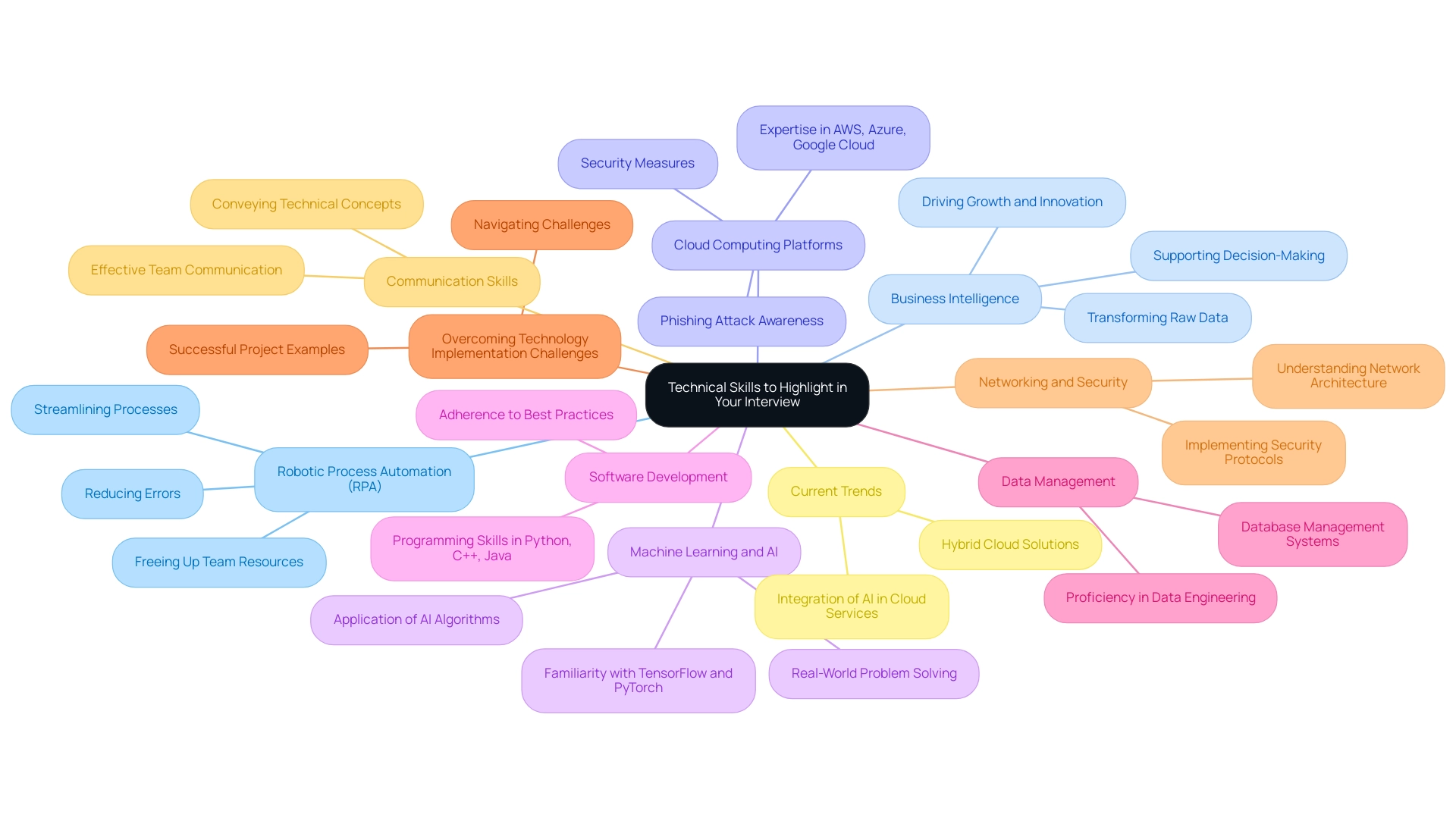
Post-Interview Follow-Up Strategies
After your NVIDIA Solutions Architect meeting, consider these follow-up strategies:
-
Send a Thank-You Email: Within 24 hours of your meeting, send a personalized thank-you email to each interviewer. Express your gratitude for the opportunity and reiterate your enthusiasm for the role. As Barack Obama once reflected, ‘The world is complicated, Bar. That’s why it’s interesting.’ This underscores the value of showing appreciation and engagement in the intricate process of job applications. Thank-you emails have been shown to significantly improve candidates’ chances of receiving positive feedback, making them an essential step in the follow-up process.
-
Mention Key Discussion Points: In your email, reference specific topics talked about during the meeting. This not only reminds the interviewers of your conversation but also reinforces your qualifications and shows that you were actively listening and engaged. Establishing a framework for decision-making can help interviewers feel more at ease with their choices about candidates.
-
Request for Feedback: If suitable, kindly ask for input on your performance during the discussion. This demonstrates your commitment to improvement and can provide valuable insights. Just as President Obama relied on thorough processes and team trust during pivotal decisions, seeking feedback can help you refine your approach. Research indicates that candidates who seek feedback are often viewed more favorably by interviewers.
-
Stay Engaged: If you have not heard back after a week or two, consider sending a follow-up email inquiring about the status of your application. This shows your continued interest in the position and keeps you on the interviewer’s radar. Timely follow-ups can be likened to a commander requesting immediate troop deployment, emphasizing the importance of prompt actions in achieving desired outcomes.
-
Connect on LinkedIn: If you haven’t already, connect with your interviewers on LinkedIn. This can help you maintain a professional relationship and keep you in mind for future opportunities. Building a network is crucial for long-term career success, especially in tech jobs where connections can lead to new opportunities.
-
Continue Learning: Regardless of the outcome, use the experience as a learning opportunity. Reflect on what went well and what could be improved for future discussions. Just as high-stakes decisions require reflection and learning, so too does the job search process. Engaging in this reflective practice can enhance your future interview strategies and overall effectiveness.
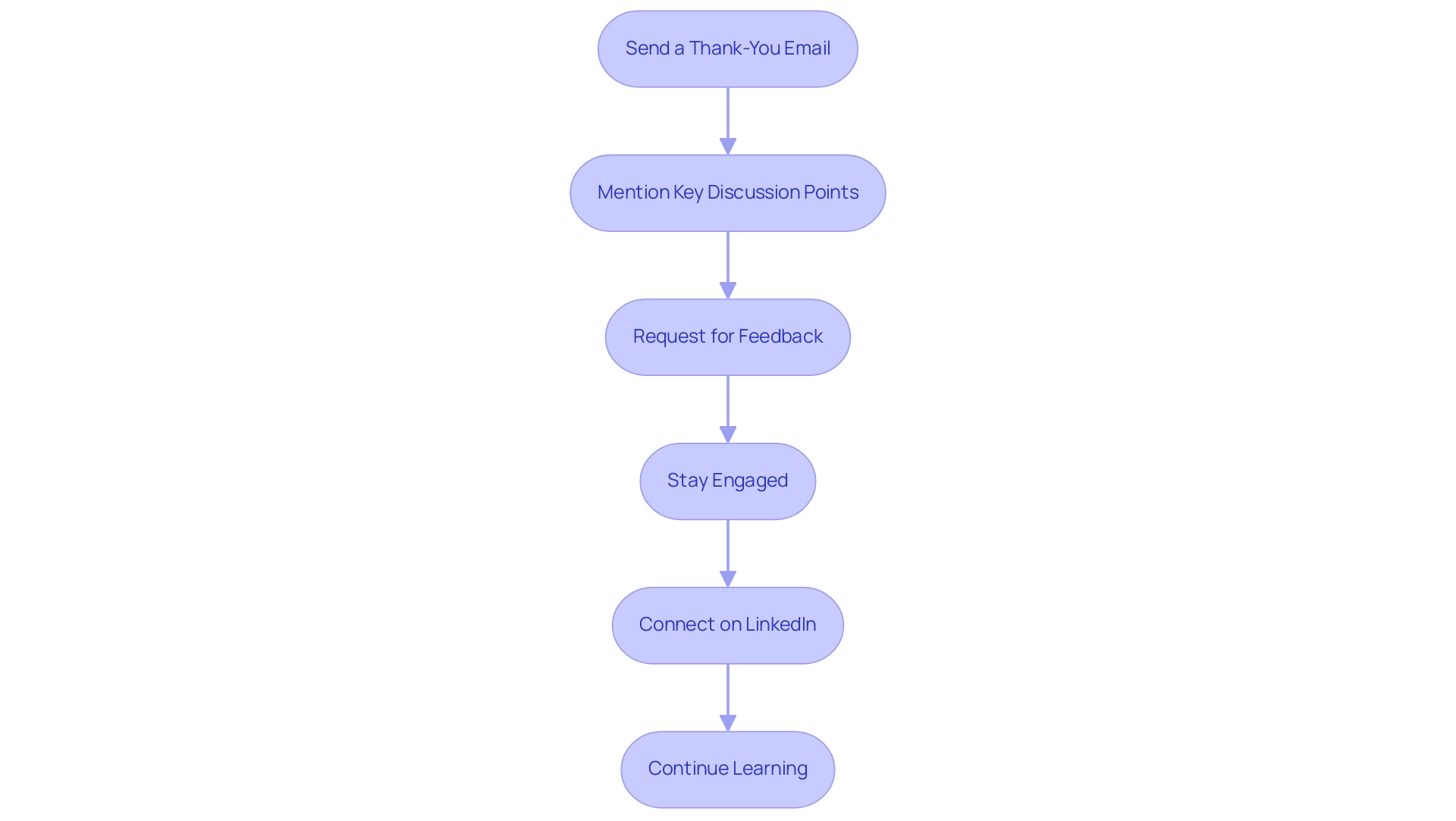
Conclusion
Thorough preparation is key to standing out in an NVIDIA Solutions Architect interview. By researching NVIDIA’s technologies, understanding the specific role, and honing relevant technical skills, candidates can effectively demonstrate their fit for the position. Practicing with mock interviews and preparing to discuss past projects will further enhance confidence and readiness.
Additionally, addressing common interview questions and articulating experiences in areas like Robotic Process Automation, Business Intelligence, and cloud computing will showcase the ability to contribute meaningfully to business goals. Emphasizing communication skills and the capacity to navigate technology implementation challenges will strengthen a candidate’s profile in the competitive landscape of tech interviews.
Finally, proactive post-interview strategies, such as sending thank-you notes and seeking feedback, can leave a positive impression and reinforce interest in the role. By implementing these strategies, candidates can transform the interview process into a powerful stepping stone towards a successful career in technology. Embracing this comprehensive approach will empower candidates to present themselves as invaluable assets in the evolving tech ecosystem.
Introduction
In the rapidly evolving landscape of artificial intelligence, organizations face the pressing challenge of effectively implementing AI solutions that drive operational efficiency and enhance patient care. A well-crafted AI Proof of Concept (PoC) emerges as a crucial first step, offering a structured approach to validate innovative ideas while minimizing risks associated with technology deployment. By engaging stakeholders early and aligning objectives, organizations can navigate the complexities of AI implementation and harness its transformative potential.
This article delves into the intricacies of developing a successful AI PoC, highlighting key strategies, common pitfalls, and the vital role of iteration and evaluation in ensuring that AI initiatives not only meet but exceed expectations. As the healthcare industry increasingly turns to AI for improved outcomes, understanding these foundational elements can empower leaders to make informed decisions that pave the way for sustained success.
Understanding the Importance of AI Proof of Concepts
An AI Proof of Concept (PoC) serves as a vital foundational step in developing AI solutions within organizations, particularly for overcoming technology implementation challenges. This initial phase allows teams to rigorously test the feasibility of their ideas, validating assumptions before committing substantial resources. By clearly demonstrating the potential value of AI applications, PoCs provide a structured framework for informed decision-making.
Involving stakeholders early in the process is crucial, aligning expectations and fostering buy-in, which significantly mitigates failure risks. Recent advancements in AI applications, especially in surgery, have shown promising outcomes, such as reduced error rates in cancer detection and improved patient risk assessments. Research indicates that AI initiatives starting with a PoC boast a success rate of over 70%, compared to only 30% for those that do not.
A relevant case study titled ‘AI’s Impact on Surgical Education and Practice’ illustrates how AI offers evidence-based, real-time clinical decision support that optimizes patient care and enhances surgeon workflow. When developed and implemented effectively, AI has the potential to significantly improve the quality of patient care in surgery.
Additionally, insights from Ozanan R. Meireles, MD, FACS, from Massachusetts General Hospital, underline the critical role that clinicians play in advancing technology for clinical effectiveness. Recognizing the importance of AI PoCs, along with leveraging Business Intelligence to transform raw data into actionable insights, can lead to more strategic initiatives and successful outcomes.
This ultimately transforms how organizations leverage AI and RPA to optimize efficiency and patient care in a competitive, data-rich environment. Staying informed about the latest developments in AI PoC strategies and Business Intelligence is essential for directors of operations efficiency to fully harness the potential of these technologies.
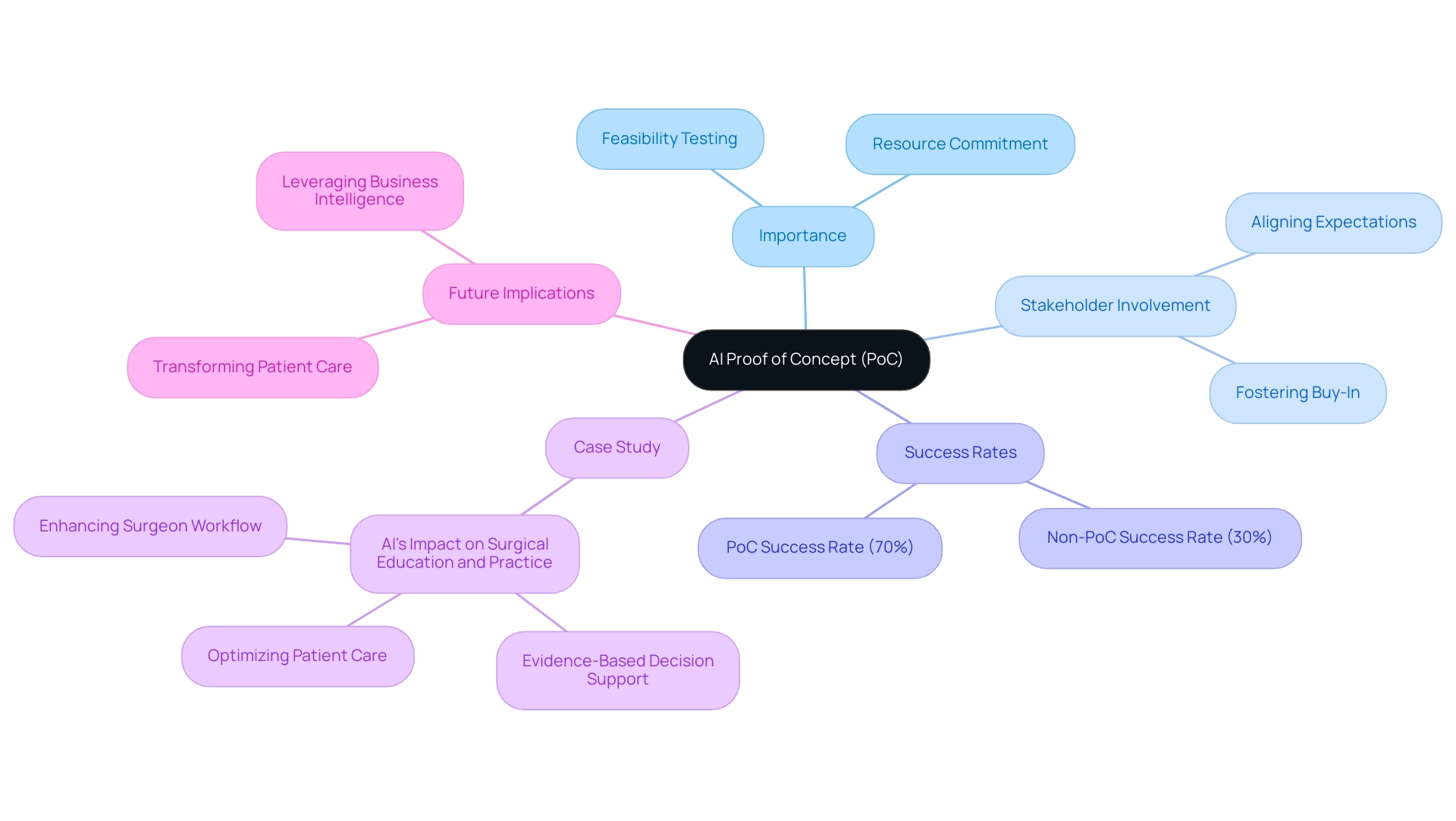
Step-by-Step Guide to Developing Your AI PoC
-
Define Objectives: Begin by clearly outlining the goals of your AI proof of concept (PoC). Identify the specific issue you aim to tackle, particularly the inefficiencies caused by manual, repetitive tasks, and the expected outcomes, which will guide your initiative’s direction. Establishing clear objectives is crucial for measuring success. Common objectives for AI PoCs include improving efficiency through Robotic Process Automation (RPA), enhancing decision-making, and reducing operational costs.
-
Identify Stakeholders: Engage with relevant stakeholders, including team members, executives, and domain experts. Their insights are invaluable for ensuring alignment and understanding organizational needs. As Peter Norvig, an Education Fellow at Stanford University, emphasizes, collaboration is key to harnessing the full potential of AI.
-
Select the Right Technology: Carefully choose the tools and platforms that align with your project requirements. Consider factors such as information availability, integration capabilities, and the specific AI techniques you plan to apply. Incorporating tailored RPA solutions can significantly influence the effectiveness of your PoC, enabling automation of manual workflows and enhancing operational efficiency in a rapidly evolving AI landscape.
-
Gather and Prepare Information: Collect and prepare relevant information to ensure it is clean, structured, and ready for analysis. This step is essential, as precise information is the foundation of dependable AI models. Effective information preparation can lead to enhanced model performance and insights. According to recent statistics, approximately 80% of science time is spent on preparation, underscoring its importance.
-
Develop the Model: Utilize appropriate algorithms and machine learning techniques to build your AI model. Keep the previously defined objectives in mind throughout this process to ensure the model aligns with your goals and effectively addresses the identified problem. Recent best practices suggest employing iterative development to refine model performance continuously.
-
Test and Validate: Conduct rigorous testing of your PoC to validate its performance against the established objectives. This phase is essential for identifying any issues and ensuring that the model meets the required standards. Key performance indicators (KPIs) should be established in advance to facilitate this evaluation.
-
Gather Feedback: Present the PoC to your stakeholders and actively seek their feedback. This collaborative approach allows you to refine the solution further, incorporating diverse perspectives that can enhance the final product.
-
Document the Process: Throughout the development of your PoC, meticulously document lessons learned and insights gained. This record will act as a valuable resource for future endeavors, facilitating continuous improvement in your AI initiatives.
The journey of developing an AI PoC can be informed by recent best practices, including the successful use of convolutional neural networks in case studies like the automated classification of pulmonary tuberculosis. Such examples highlight how AI, combined with RPA, can significantly improve early detection in medical applications, demonstrating the profound impact of AI and RPA on various fields. Furthermore, leveraging Business Intelligence alongside RPA can enhance your ability to derive actionable insights, driving informed decision-making and operational efficiency.
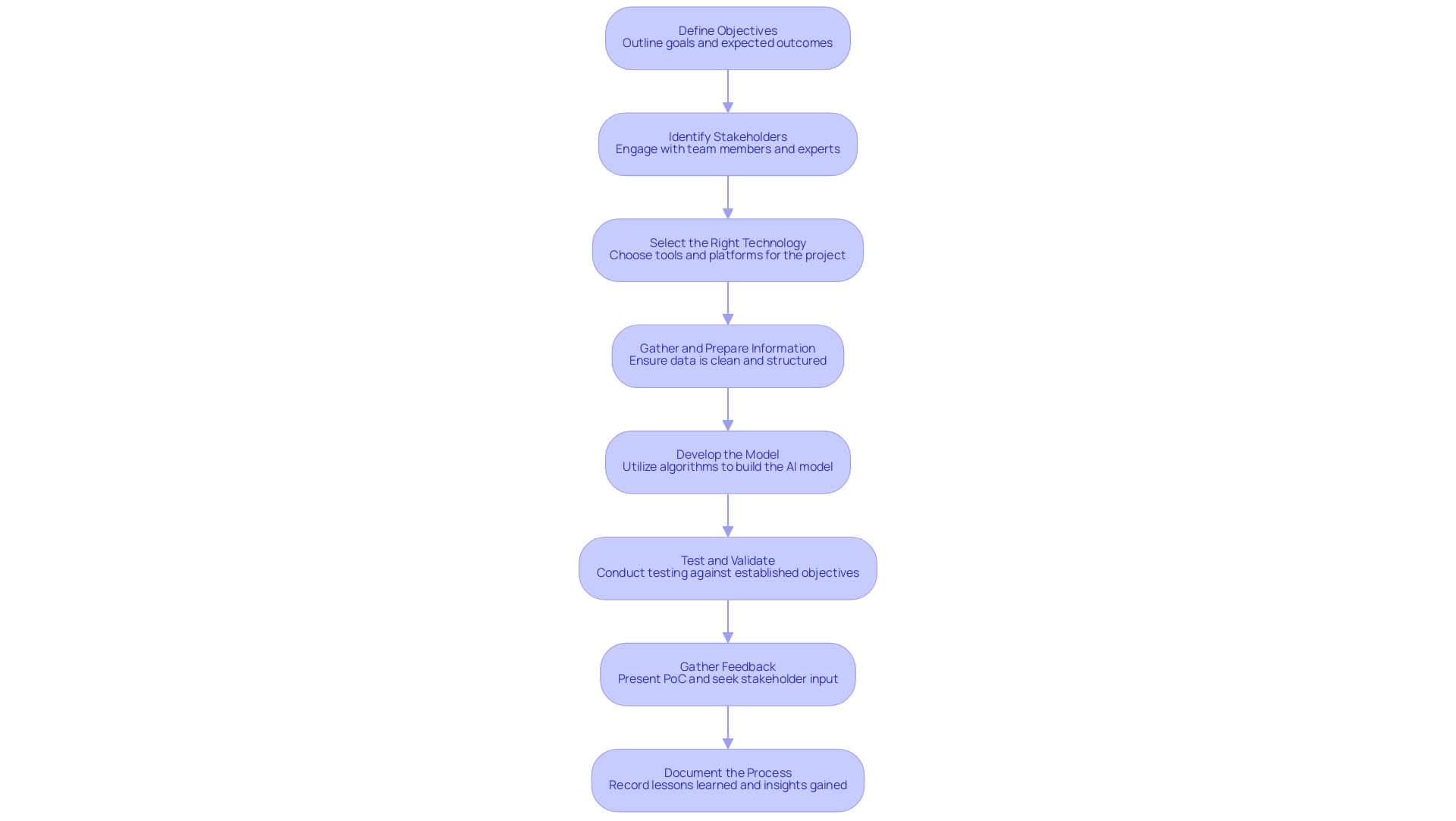
Key Success Factors for AI PoC Implementation
-
Group Composition: For successful AI initiative execution, it is essential to gather a varied group that comprises specialists in AI, data science, and pertinent domain expertise. A recent analysis suggests that initiatives with varied groups are 35% more likely to excel over their rivals (Source: McKinsey). This diversity fosters a range of perspectives, essential for innovative problem-solving, particularly in leveraging Robotic Process Automation (RPA) to automate manual workflows and enhance operational efficiency. The influence of team composition on success cannot be overstated; a well-rounded group can navigate complex challenges more effectively, especially in a rapidly evolving AI landscape.
-
Technology Selection: The choice of technology should align closely with your business goals and be scalable to accommodate future growth. Choosing the right tools, including RPA solutions, ensures that your AI initiative can evolve seamlessly as needs change, optimizing performance and adaptability in a rapidly shifting technological landscape. The evolving AI landscape complicates technology selection, as businesses must navigate a multitude of options that may not directly address their specific challenges. According to industry specialists, 70% of AI initiatives fail due to poor technology choices (Source: Gartner). Emphasizing the importance of tailored AI solutions will further enhance your operational capabilities.
-
Executive Support: Securing backing from leadership is vital for providing the necessary resources and support for your proof of concept. Executive sponsorship not only boosts credibility but also guarantees that the team has access to the tools and funding necessary to advance the initiative successfully. Expert quotes emphasize that “without executive buy-in, AI initiatives often struggle to gain traction” (Source: AI Business). This support is critical in overcoming technology implementation challenges, particularly in integrating RPA and Business Intelligence effectively.
-
Clear Metrics: Establishing clear success metrics from the outset is essential for effectively evaluating the performance of the PoC. Metrics should be specific, measurable, and aligned with overall business objectives, allowing for transparent assessment and adjustments as needed throughout the lifecycle. A study by Deloitte found that organizations that define clear metrics are 50% more likely to successfully implement AI initiatives. This clarity is particularly important when leveraging Business Intelligence to drive data-driven insights that foster informed decision-making.
-
Stakeholder Engagement: Maintaining open lines of communication with stakeholders is crucial for ensuring alignment and addressing any concerns that may arise throughout the process. Engaging stakeholders early and frequently can cultivate a collaborative atmosphere, enabling feedback and insights that can greatly improve the outcome. The significance of these factors is emphasized by prominent projects, such as Ai Weiwei’s ‘Remembering,’ which demonstrated how varied groups and clear communication can convert artistic vision into meaningful social statements. Additional case studies, such as the implementation of AI in healthcare settings, further illustrate how effective team composition and stakeholder engagement lead to successful outcomes. As the AI landscape continues to evolve, concentrating on these key success factors, especially in enhancing efficiency with RPA and utilizing Business Intelligence to convert raw information into actionable insights, will enable organizations to harness the full potential of AI solutions.

Navigating Challenges in AI PoC Development
-
Information Quality Issues: Ensuring that the information is clean and relevant is paramount in AI development. Poor information quality, with studies indicating that up to 30% of information used in AI projects may be inaccurate or inconsistent, can undermine the objectives of the proof of concept. Tackling these concerns is essential, particularly since organizations that emphasize quality information often observe a 20% boost in the effectiveness of their AI implementations. Recent advancements, such as Small Language Models, which provide tailored AI for efficient data analysis and enhanced privacy, and tailored GenAI workshops that offer hands-on training, can significantly enhance data analysis and privacy, addressing these challenges head-on.
-
Lack of Clarity in Objectives: Clearly defining goals from the outset helps avoid scope creep and misalignment. Without clarity, groups may diverge from intended outcomes, leading to wasted resources and missed opportunities. Implementing structured workshops can ensure that all stakeholders are aligned on objectives.
-
Resistance to Change: Cultural resistance can be a significant barrier to successful AI implementation. To combat this, it is vital to involve employees early in the process, showcasing the benefits of AI through tailored training sessions. Demonstrating how AI tools can enhance their work fosters a more positive reception and engagement with new technologies.
-
Underestimating Resources: Conduct a thorough assessment of the resources needed for the PoC, including time, budget, and personnel. Utilizing Power Automate for streamlined workflow automation can provide a clearer picture of required resources, supporting an efficient project setup.
-
Inadequate Testing: Comprehensive testing is essential to validate the proof of concept and ensure it meets predefined objectives. A robust testing phase not only highlights potential issues before full-scale deployment but also builds confidence in the AI solutions being developed. As Oleksandr Hergardt observes, an AI PoC serves as a sandbox for groups to innovate and learn. Furthermore, Ng’s case study on standardization challenges illustrates how varying data types necessitate custom AI systems, underscoring the importance of tailored approaches in overcoming data quality issues.
To explore how our tailored AI solutions can address your specific business challenges, book a free consultation today. Together, we can enhance your operations and leverage AI for innovation.
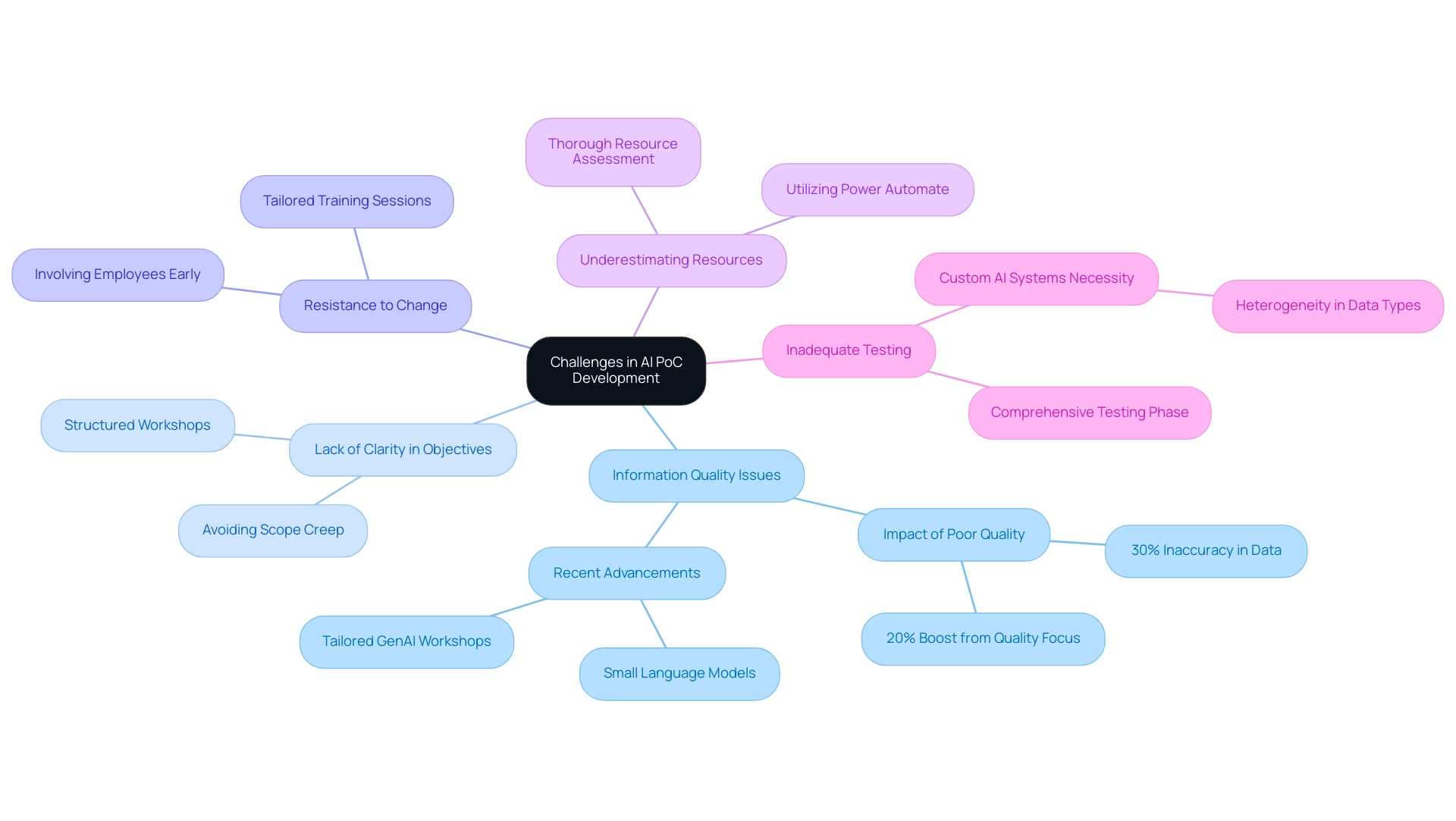
The Role of Iteration and Evaluation in AI PoCs
Iteration and evaluation stand as crucial pillars in the development of AI proof of concepts (PoCs). Following the initial testing phase, it is essential to actively gather feedback from stakeholders and leverage it to refine the model, ensuring that the PoC adapts to evolving business requirements. Embracing an agile approach fosters a culture of frequent iterations, leading to continuous enhancements that contribute to a more robust and effective AI solution. For instance, Keysight Eggplant Test exemplifies this methodology by delivering intelligent testing at scale without the need for manual scripting or access to the source code. Its innovative, AI-powered capabilities enable groups to evaluate applications across any platform or device, generating tests based on a digital twin of the application. This model-based approach not only streamlines the testing process but also significantly reduces man-hours—by up to 92% compared to conventional methods.
To effectively evaluate AI PoCs, organizations should integrate Robotic Process Automation (RPA) to automate manual workflows, enhancing operational efficiency in this rapidly evolving AI landscape. RPA not only enhances efficiency but also minimizes errors and liberates groups for more strategic, value-adding work. Metrics such as accuracy, precision, recall, and F1 score provide insights into model performance, while RPA tools can streamline data collection and analysis, enabling more informed decision-making. As Dr. Jane Smith, a leading AI researcher, states, ‘Frequent iterations allow teams to pivot quickly based on real-world feedback, ensuring the end product meets user needs effectively.’
As we look towards 2024, the importance of these components in AI PoC development cannot be overstated, as they lay the groundwork for sustained advancements in technology and business processes. Furthermore, the latest trends in agile approaches, such as DevOps integration and continuous delivery, alongside tailored AI solutions and Business Intelligence, are reshaping how organizations develop and deploy AI solutions, underscoring the need for ongoing iteration and evaluation. By leveraging RPA and Business Intelligence, organizations can enhance productivity, address task repetition fatigue, and ultimately drive growth.
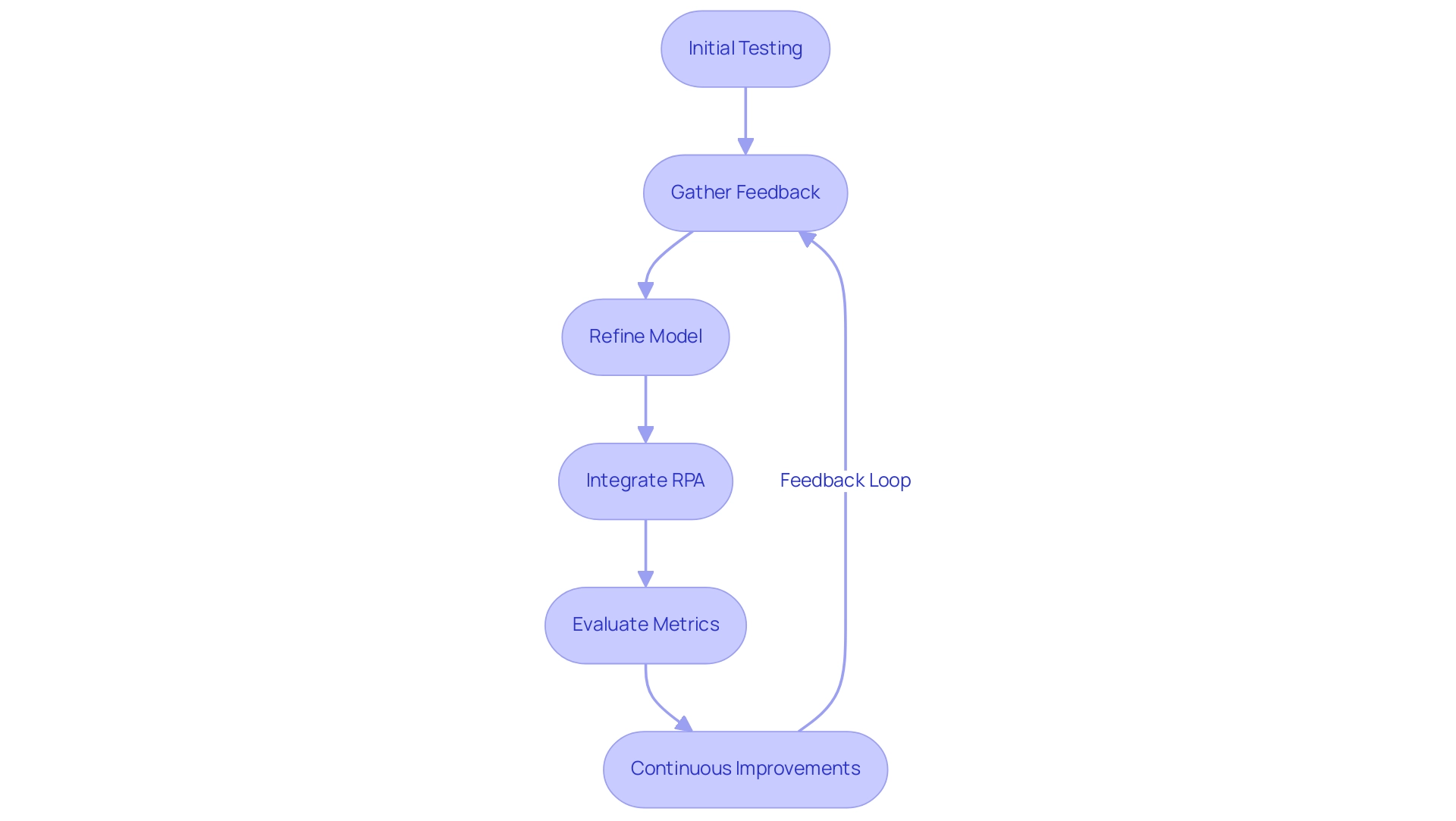
Conclusion
Implementing an AI Proof of Concept (PoC) is a pivotal step for organizations aiming to leverage artificial intelligence to enhance operational efficiency and patient care. By clearly defining objectives, engaging stakeholders, and selecting appropriate technologies, organizations can create a solid foundation for their AI initiatives. The emphasis on collaboration and communication among diverse teams further strengthens the potential for success, as evidenced by the significant impact that well-composed teams can have on project outcomes.
As organizations navigate the complexities of AI development, it is crucial to remain vigilant about potential challenges. Issues such as data quality, resistance to change, and inadequate testing can derail even the most promising projects. By prioritizing data accuracy and involving employees early in the process, organizations can foster a culture that embraces innovation rather than resists it.
Moreover, establishing clear metrics and iterating based on feedback ensures that AI solutions are continuously refined and aligned with business goals.
Ultimately, a well-executed AI PoC not only validates innovative ideas but also paves the way for sustainable success in the healthcare industry. By embracing the transformative power of AI, organizations can significantly improve patient outcomes and operational efficiencies. The future of healthcare lies in the hands of those who are willing to invest in thoughtful, strategic AI initiatives that prioritize collaboration, continuous improvement, and adaptability.
Now is the time to take action and harness the full potential of AI to drive meaningful change.
Introduction
In the rapidly evolving landscape of business analytics, Power BI emerges as a transformative tool that empowers organizations to unlock the full potential of their data. By converting raw numbers into visually engaging reports and interactive dashboards, it enables decision-makers to glean actionable insights that drive operational efficiency. With features like real-time data processing and seamless integration with various data sources, Power BI not only enhances the speed of decision-making but also fosters a culture of collaboration and innovation.
As businesses strive to stay competitive, understanding how to effectively leverage Power BI can lead to significant improvements in data-driven strategies and outcomes. This article serves as a comprehensive guide for beginners, offering practical steps to harness the power of Power BI and integrate it into everyday operations for maximum impact.
Understanding Power BI: An Overview for Beginners
This robust business analytics application developed by Microsoft enables users to convert unrefined information into visually engaging and interactive presentations and dashboards. This tool enables seamless information visualization and sharing across organizations, with functionalities extending to embedding insights within apps or websites. BI Desktop, a no-cost application, enables users to generate detailed reports and visualizations locally, simplifying the analysis process.
One of the standout features of BI is its real-time data processing capability, which facilitates swift decision-making based on the most current information. This aspect is crucial for maintaining operational efficiency and staying ahead in a competitive landscape. Additionally, Microsoft’s commitment to BI is evident through its regular updates, released monthly to enhance features, performance, and security. Such continuous improvement ensures that BI remains at the forefront of business intelligence tools, incorporating user feedback to stay user-friendly and cutting-edge.
The 3-Day BI Sprint provides a swift route to producing professionally crafted reports, allowing entities to swiftly utilize the strength of analytics. Coupled with the General Management App, users can manage their operations comprehensively and intelligently. Embracing BI offers substantial advantages for visualization, allowing decision-makers to recognize trends and insights effortlessly. In fact, based on recent statistics, 75% of organizations reported enhanced decision-making processes after adopting BI in 2024, largely due to its strong analytics capabilities and integration with various information sources. As noted by industry expert Jane Doe, “This business intelligence tool has revolutionized the way we visualize and interact with data, making it a game-changer for operational efficiency.”
Moreover, utilizing Automate permits streamlined workflow automation, which can significantly enhance productivity while addressing outdated systems and inefficiencies. By combining EMMA RPA solutions with Business Intelligence, companies can further improve their operational efficiency. EMMA RPA not only automates repetitive tasks but also enhances BI’s information visualization capabilities, ensuring that insights derived from information are actionable and timely. By familiarizing yourself with BI’s key features, such as real-time data processing and consistent updates, along with the integration of RPA solutions, you can effectively drive data-driven decision-making within your organization, overcoming barriers to AI adoption and ensuring your data is both accurate and actionable.
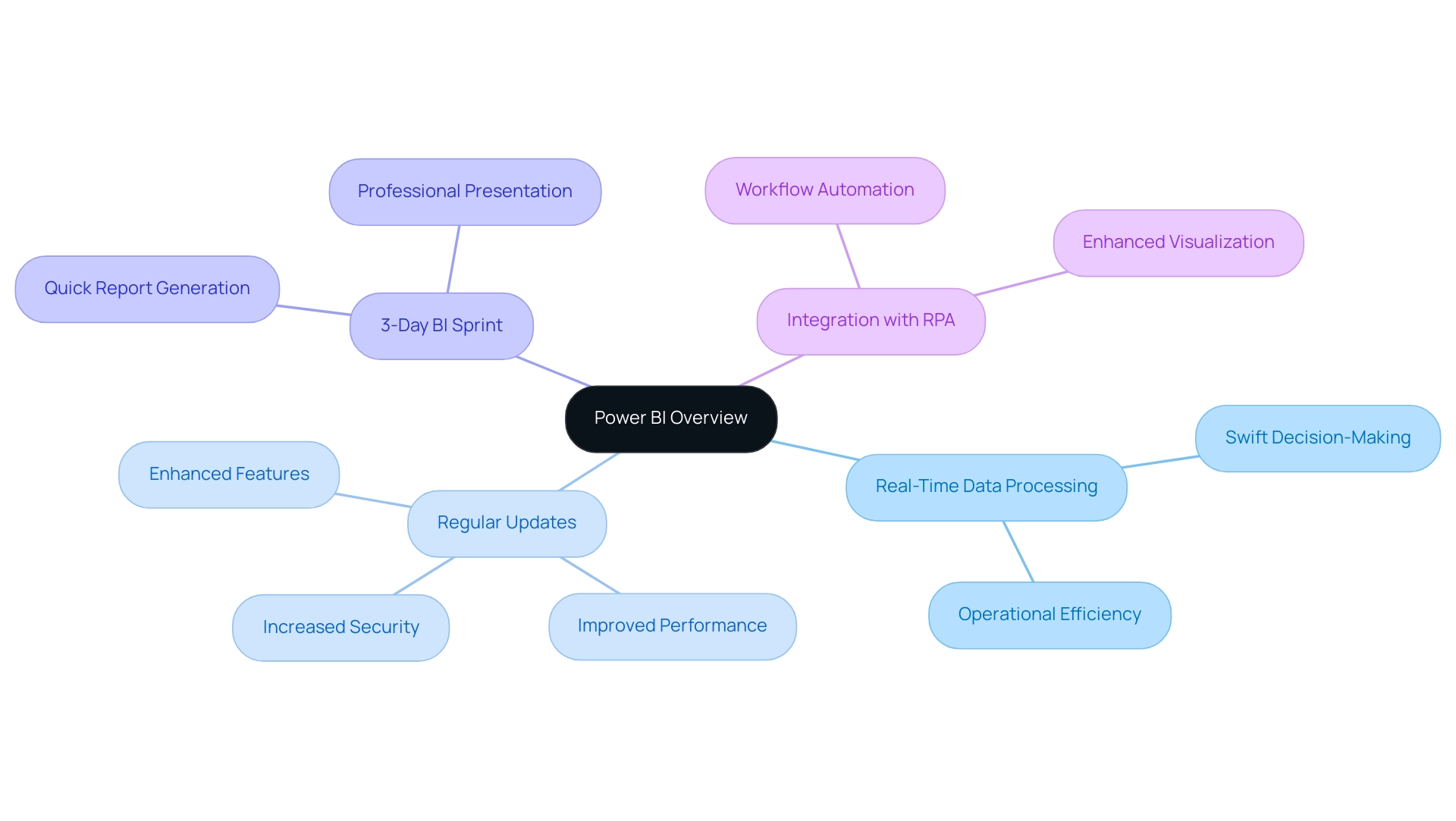
Step-by-Step Guide to Acquiring Power BI
Selecting the appropriate version of BI is essential for aligning with your organizational needs and maximizing efficiency. BI offers several versions:
- BI Desktop (free)
- BI Pro (subscription-based)
- BI Premium
Recent statistics indicate that BI user growth has surged by 40% over the past year, reflecting its increasing adoption and effectiveness in data analysis and visualization.
In today’s data-focused environment, companies may struggle with:
– Time-consuming document creation
– Inconsistencies across various submissions
– A lack of actionable guidance
BI Desktop is ideal for those looking to create reports and dashboards without incurring additional costs. However, it may not address the efficiency needs of larger teams. For organizations seeking collaborative capabilities and advanced features, BI Pro or Premium may prove more suitable. BI Pro includes features such as:
– Data sharing
– Collaboration
– Access to advanced data modeling capabilities
While BI Premium offers:
– Dedicated cloud resources
– Enhanced performance
– The ability to handle larger datasets and complex analytics operations
Organizations like Contoso Ltd. have opted for BI Pro to leverage its collaborative tools, significantly improving their data-driven decision-making processes. In contrast, Fabrikam Inc. opted for BI Premium to manage large datasets and achieve higher performance levels in their analytics operations.
As IT expert John Doe emphasizes, “Choosing the appropriate BI version is about understanding your specific needs and the scale of your operations.” For large organizations, BI Premium can be a transformative solution, offering the resources essential for intricate analytics, whereas BI Desktop is ideal for solo analysts who need to generate documents autonomously.
By evaluating your needs within the framework of extensive management solutions, including the forthcoming Microsoft Copilot integration and the advantages of personalized dashboards for smooth information integration, you can make a well-informed choice regarding the version of BI that aligns best with your operational objectives. The General Management App can further enhance your capabilities by providing a holistic view of your initiatives, ensuring that you are not only tracking KPIs but also optimizing your team’s performance effectively.
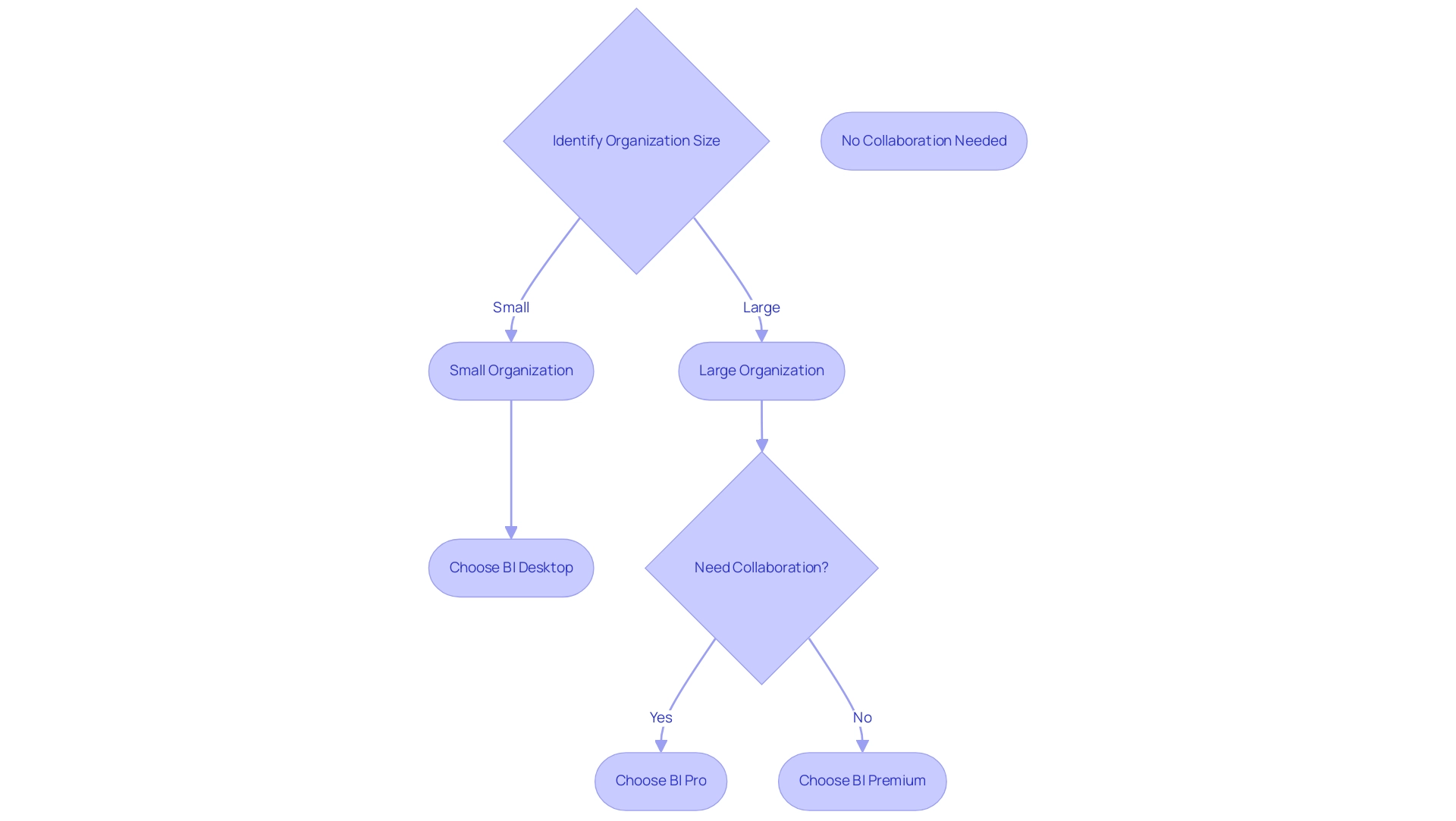
Getting Started with Your First Report
To start your Power BI journey, it’s essential to understand the significance of visualization in transforming raw information into insightful reports that drive decision-making. Business Intelligence, alongside Robotic Process Automation (RPA), plays a crucial role in today’s data-rich environment, as it empowers organizations to extract meaningful insights that fuel growth and innovation.
Begin by selecting the information you wish to analyze using the ‘Get Data’ option, which allows you to choose from a wide array of sources. Once you have chosen and imported your information, it will appear in the ‘Fields’ pane, making it easily accessible for your analysis.
Utilizing various visualization types, such as tree maps and bar charts, can effectively represent relationships and trends. For instance:
- Tree maps can show the size of categories relative to the whole.
- Bar charts can compare different groups side by side.
This process guarantees that your information is easily accessible for crafting engaging visualizations and meaningful reports, ultimately improving your analytical abilities in BI and promoting operational efficiency through informed decision-making.
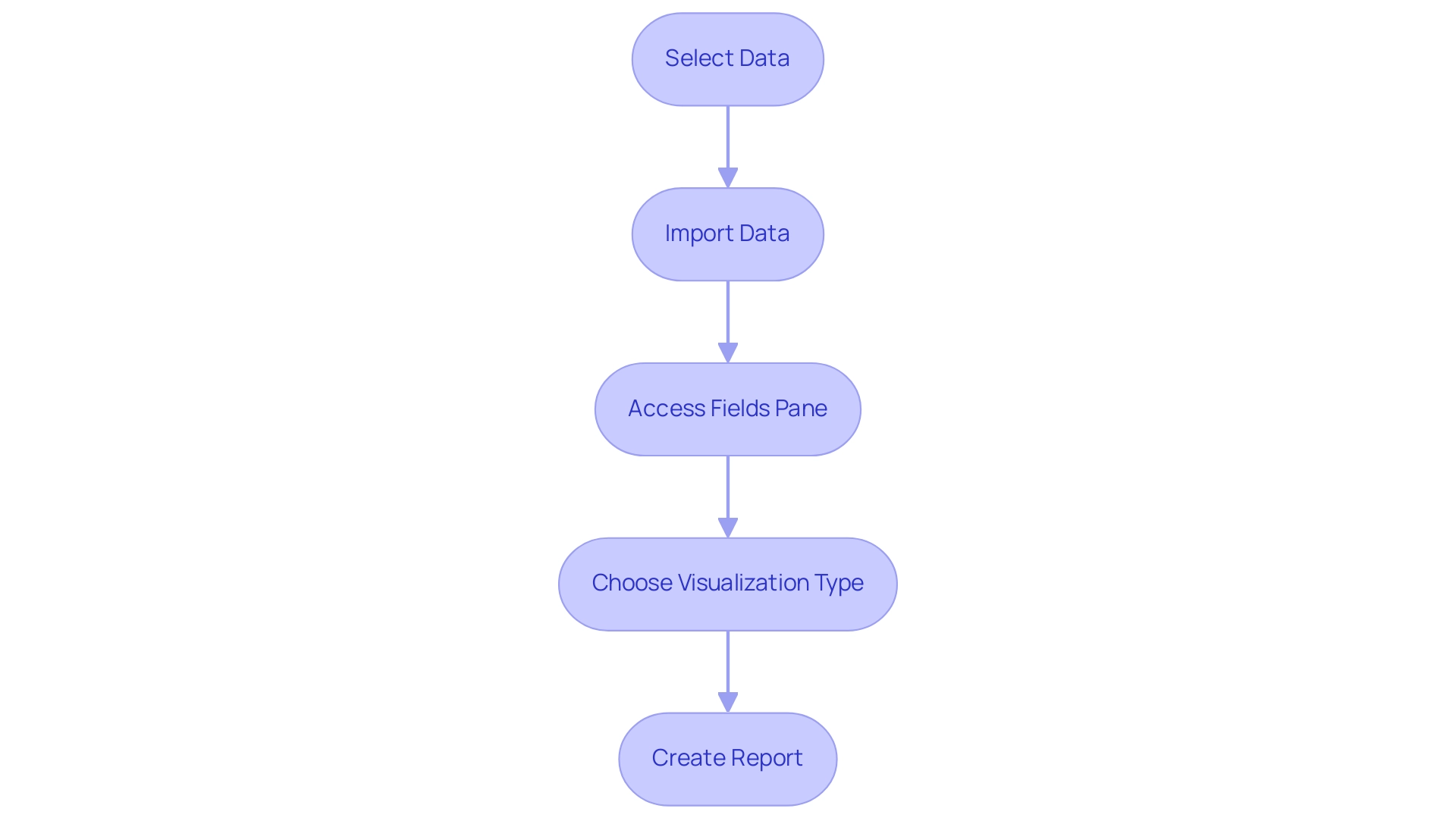
Leveraging Power BI for Business Insights
This tool enables organizations to convert their information into engaging visual stories that promote informed decision-making. By leveraging interactive dashboards, teams can monitor key performance indicators (KPIs) in real-time, identify emerging trends, and proactively adjust their strategies. Research shows that 70% of companies reported improved decision-making capabilities after implementing real-time data solutions.
To harness the full potential of Power BI:
-
3-Day BI Sprint: Are you dedicating more time to creating documents than utilizing insights for significant decisions? Our 3-Day BI Sprint is intended to generate a fully functional, professionally crafted document on a subject of your choice in just three days. This allows you to focus on utilizing insights effectively, ensuring informed decisions can be made quickly.
-
Integrate Real-Time Information: Connecting BI to live information sources ensures that reports reflect the most current insights, enabling timely assessments and choices. The significance of real-time information cannot be overstated, as it offers a competitive advantage in swiftly evolving markets, with 80% of organizations observing enhanced operational efficiency through real-time analytics.
-
Custom Dashboards and Data Integration: Get tailor-made dashboards that provide real-time insights, empowering you to track performance and make smarter decisions. Seamless data integration merges information from various sources into BI for a comprehensive view of your business metrics.
-
Advanced Analytics and Expert Training: Discover hidden patterns and trends with predictive analytics and machine learning. Equip your team with the skills and knowledge to maximize BI’s capabilities through hands-on training and ongoing support.
-
Share Insights: Utilize BI’s robust sharing capabilities to distribute reports throughout your company. This practice fosters a data-driven culture, encouraging collaboration and ensuring that every team member has access to critical insights.
-
Continuous Learning: Stay up-to-date with Microsoft’s regular feature updates and enhancements for BI. Ongoing education and adjustment are essential for enhancing the platform’s worth and maintaining your organization at the leading edge of analytics.
A notable example is the Salesforce Business Intelligence Dashboard, which offers detailed reports on client metrics and team performance. This dashboard has significantly increased conversion rates, revenue, and sales team productivity, demonstrating the powerful impact of real-time information integration. As one business analyst states, ‘It has become a main driver in the competitive business world that can boost businesses’ sales and operations.’
By effectively integrating real-time data, sharing insights, and continuously learning, Power BI can serve as a critical tool for driving business performance and achieving strategic objectives, especially in light of the latest trends showcasing the integration of AI and machine learning with real-time data analytics.
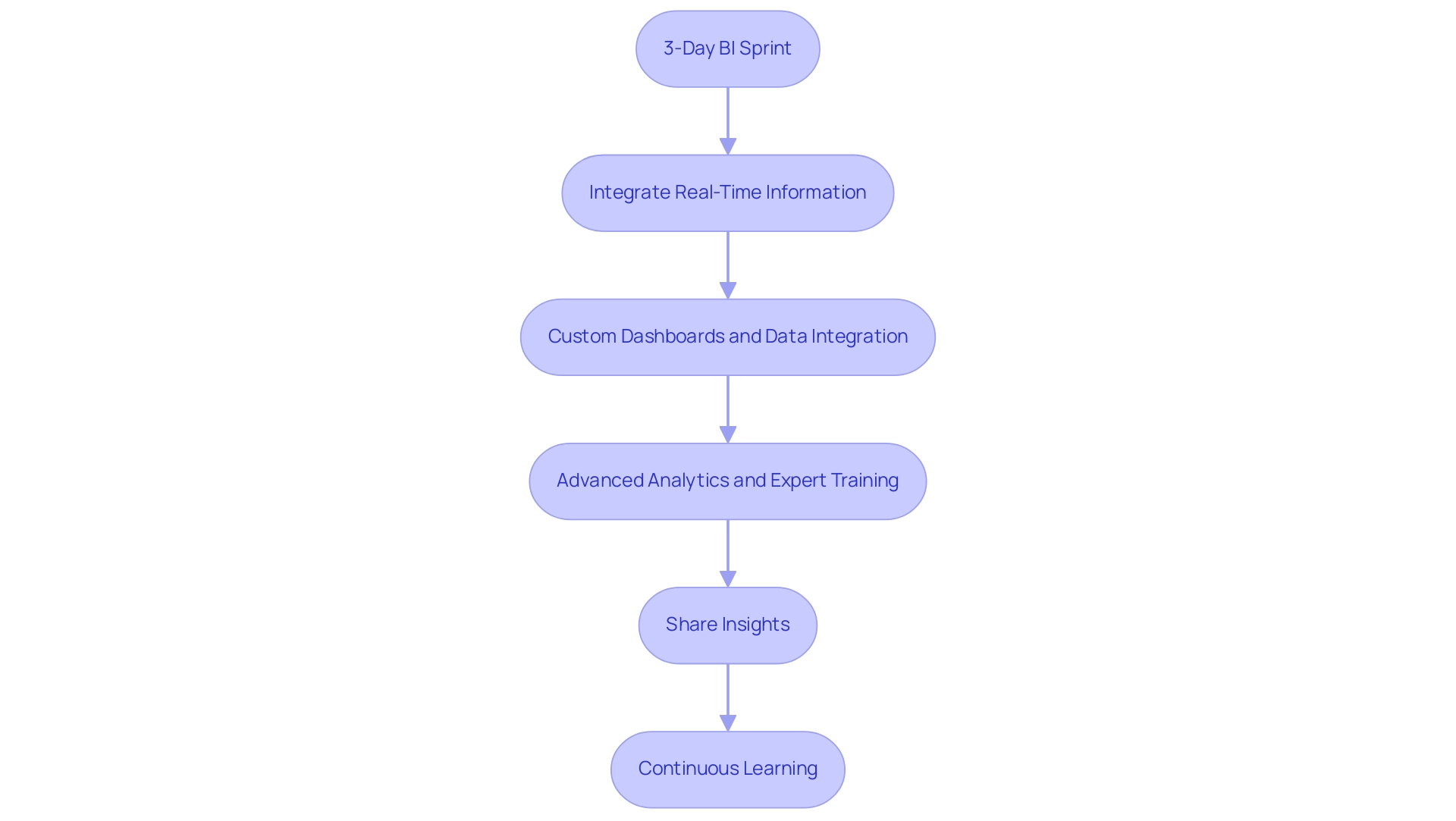
Conclusion
Harnessing the power of Power BI can dramatically transform how organizations approach data analytics and decision-making. By utilizing its robust features, such as real-time data processing and customizable dashboards, businesses can turn complex data sets into clear and actionable insights. This not only enhances operational efficiency but also fosters a culture where data-driven strategies thrive.
The journey to successful data visualization begins with selecting the right version of Power BI tailored to specific organizational needs. Whether opting for Power BI Desktop for individual use or Power BI Pro and Premium for collaborative efforts, understanding these options is vital for maximizing the impact of analytics. Moreover, the integration of tools like Power Automate and RPA solutions further streamlines processes, ensuring that insights are not just theoretical but practical and timely.
As organizations embark on their Power BI journey, they must remain committed to continuous learning and adaptation. Embracing advanced analytics and leveraging real-time insights will empower teams to monitor performance effectively and pivot strategies as necessary. By sharing insights across the organization, businesses can cultivate a data-centric culture that drives innovation and competitive advantage.
In conclusion, Power BI stands as a game-changer in the realm of business analytics. By taking proactive steps to implement its capabilities, organizations can elevate their decision-making processes, enhance operational efficiency, and ultimately achieve their strategic goals. The time is ripe to unlock the potential of data and leverage Power BI to stay ahead in the ever-evolving business landscape.
Introduction
In an era where operational efficiency is paramount, organizations are increasingly turning to Robotic Process Automation (RPA) as a transformative solution. By harnessing the power of software bots, businesses can automate repetitive tasks, minimize human error, and significantly enhance productivity. The implications of RPA stretch across various industries, from healthcare to finance, where it streamlines processes and fosters innovation.
As companies navigate the complexities of modern operations, understanding the multifaceted benefits of RPA, its diverse applications, and the challenges of implementation becomes essential. This exploration not only highlights the strategic necessity of RPA but also showcases its potential to redefine workflows and drive significant competitive advantages in today’s fast-paced market.
Defining Robotic Process Automation (RPA) and Its Importance in Business
Robotic Process Automation (RPA) leverages software robots, or ‘bots,’ to automate repetitive and rule-based tasks traditionally performed by human workers. This technology is pivotal in business, significantly reducing human error and boosting efficiency. The work capacity of RPA software can equate to that of 2-5 full-time employees, showcasing its transformative potential in operational workflows. Tools such as EMMA RPA and Microsoft Power Automate not only enhance employee morale by alleviating task repetition fatigue but also streamline processes, enabling staff to focus on higher-value activities that foster innovation and strategic thinking.
In today’s fast-paced business environment, where productivity is crucial, RPA emerges as a vital tool for organizations aiming to overcome challenges posed by outdated systems. By modernizing operations, RPA enhances productivity and responsiveness to market demands, thereby increasing competitiveness. For example, in fraud detection and prevention, RPA continuously monitors transactions, analyzing patterns and flagging suspicious activities, thereby enhancing organizations’ fraud prevention capabilities.
The importance of RPA is highlighted by a case study where a mid-sized company enhanced its workflow through GUI automation. This solution decreased data entry mistakes by 70%, sped up testing procedures by 50%, and enhanced workflow productivity by 80%, achieving ROI within six months. Such measurable outcomes emphasize the effectiveness of RPA solutions in improving capabilities across various industries, including healthcare.
Moreover, regular maintenance and updates are essential to sustain the effectiveness and longevity of RPA systems, ensuring they continue to deliver optimal performance. As Jonas Sveistrup Soegaard from Deloitte Consulting notes, RPA’s impact is widely acknowledged in leading industry forums, reinforcing its importance in modern business practices. His insights demonstrate how RPA is not just a technological progress but a strategic requirement for effective operations.
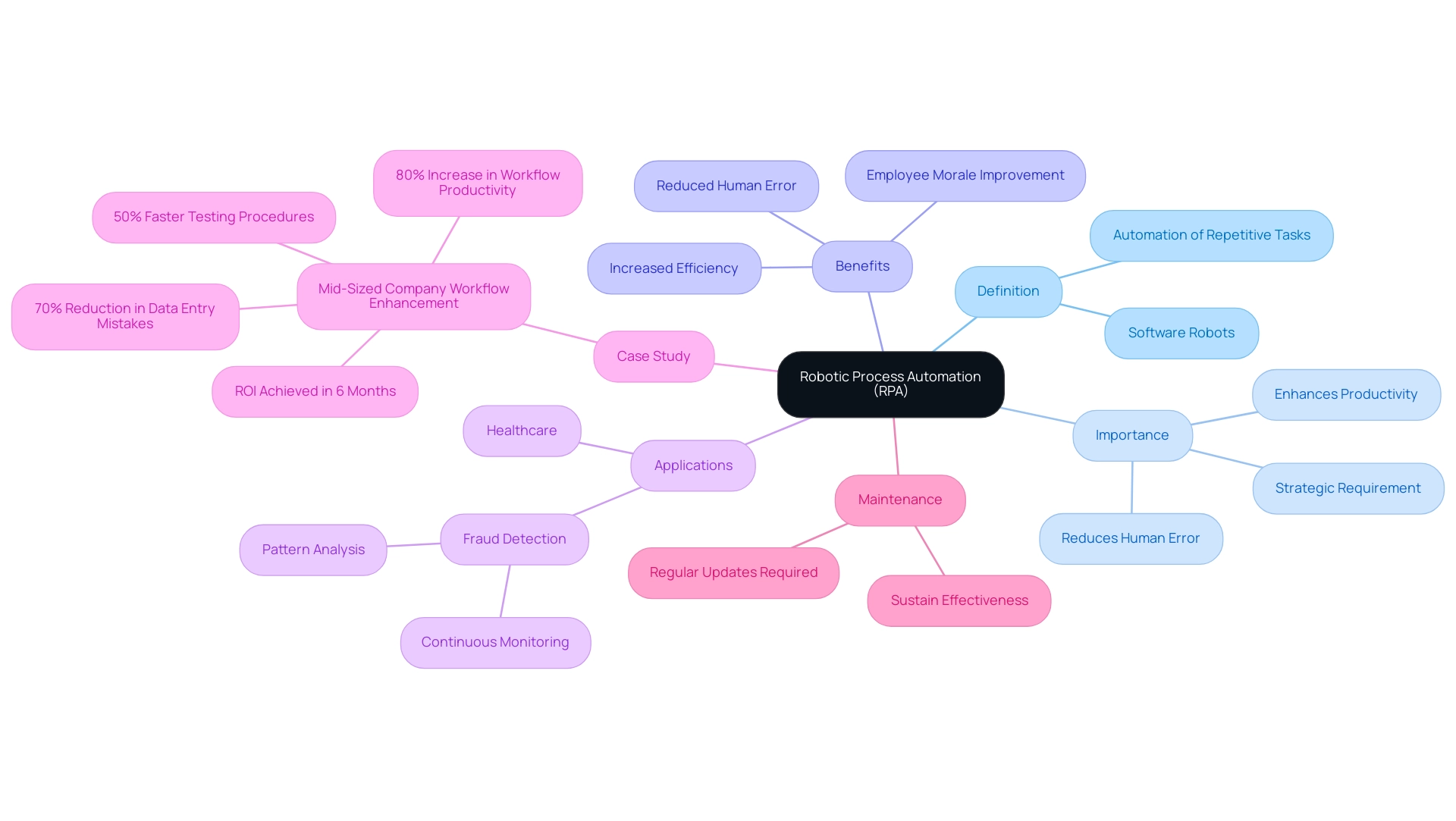
Exploring RPA Applications Across Industries: Use Cases and Success Stories
RPA is being deployed across numerous industries, each leveraging it to address unique challenges. For instance, a mid-sized healthcare company enhanced operational performance by automating data entry, software testing, and legacy system integration using GUI automation. This initiative diminished data entry mistakes by 70%, expedited software testing procedures by 50%, and enhanced workflow productivity by 80%, achieving ROI within six months.
In the finance sector, banks utilize RPA to automate account reconciliation processes, significantly reducing processing time and errors—some institutions report reductions in reconciliation time by up to 60%.
Hospitals utilize RPA to simplify patient registration and insurance verification, improving patient experience and overall effectiveness, with studies indicating a 30% decrease in patient wait times.
Retailers like Walmart adopt RPA for inventory management, which not only enhances stock accuracy but also reduces costs by approximately 20%.
These diverse use cases not only showcase RPA’s versatility but also exemplify its tangible benefits in real-world scenarios, particularly in enhancing business productivity through tailored AI solutions and Business Intelligence for informed decision-making.
Overall, RPA stands out as a powerful tool for organizations seeking to optimize operations, minimize errors, and drive significant productivity gains.
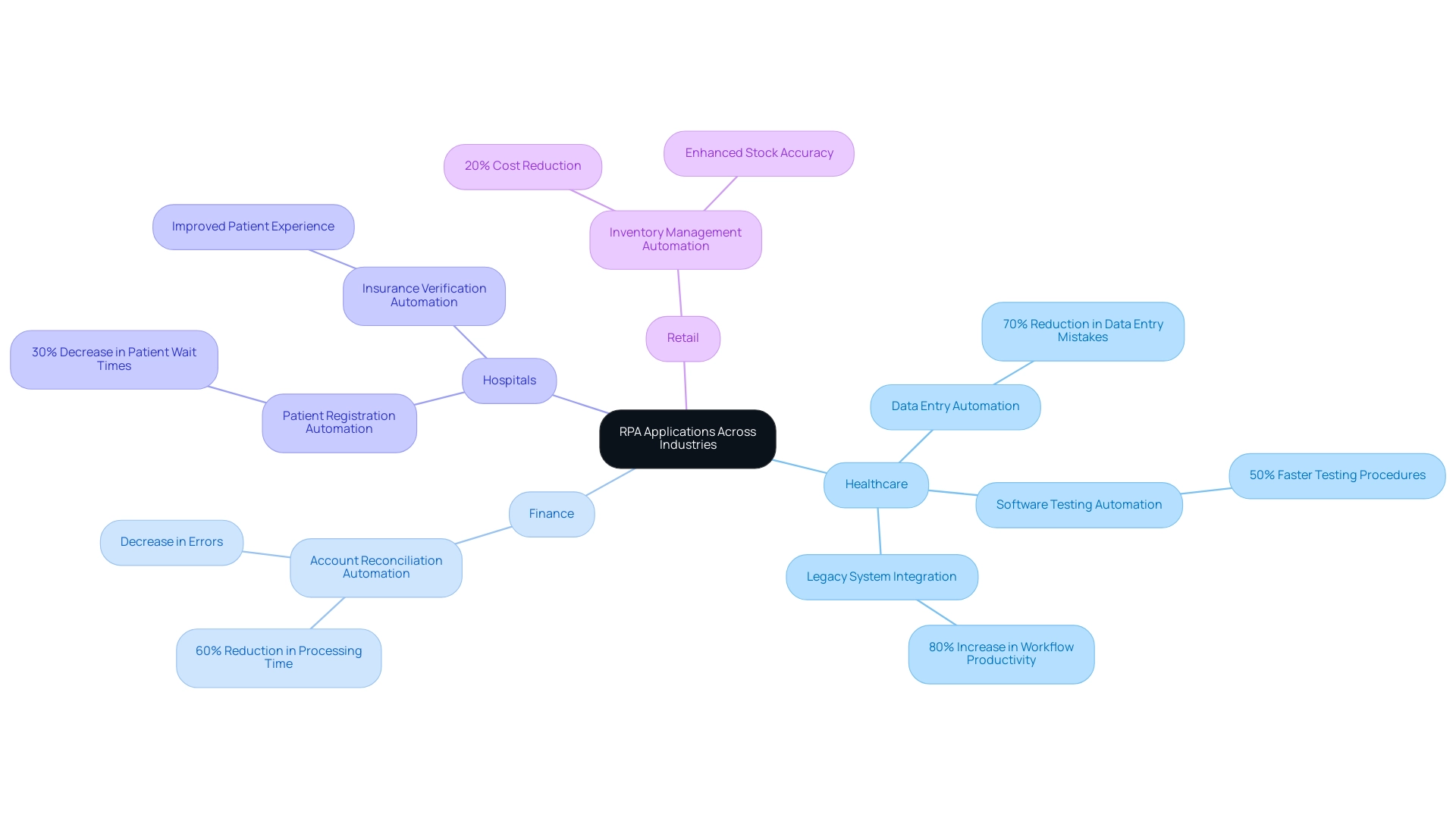
Key Benefits of Implementing RPA in Business Operations
Implementing RPA provides various advantages, such as substantial cost savings, improved performance, and enhanced accuracy. For instance, in the finance sector, RPA can automate invoice processing, drastically reducing the time spent on manual data entry. By automating routine tasks, organizations can reduce labor costs and allocate human resources to more strategic initiatives.
RPA streamlines workflows, minimizes errors associated with manual processes, and leads to improved data quality and compliance. This technology not only enhances scalability, allowing businesses to adapt quickly to changes in demand without proportional increases in staffing, but it also empowers organizations in a rapidly evolving AI landscape to identify tailored solutions that drive productivity.
Furthermore, integrating Business Intelligence with RPA transforms raw data into actionable insights, enabling informed decision-making that fuels growth and innovation. In summary, RPA enables organizations to attain greater efficiency and productivity while lowering costs, positioning them advantageously in a competitive landscape. By addressing common challenges such as task repetition fatigue and staffing shortages, RPA solutions can significantly improve employee morale and operational effectiveness.
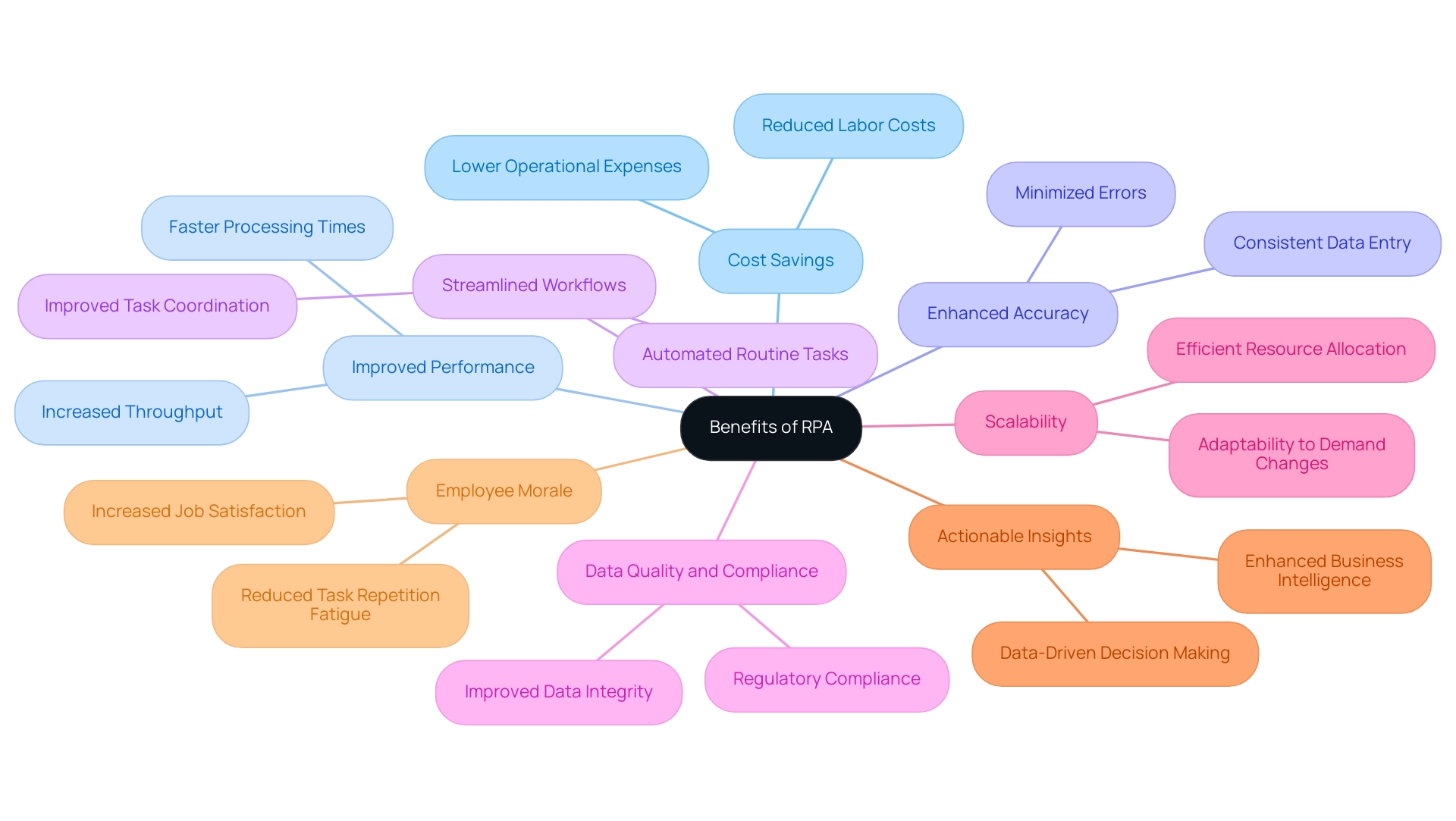
Navigating the Challenges and Risks of RPA Implementation
While RPA offers numerous advantages, organizations must navigate several implementation challenges. Common risks include:
- Employee resistance to change
- Underestimating the complexity of integrating RPA with existing systems
- Potential disruptions in workflows
To mitigate these challenges, organizations should adopt comprehensive change management strategies, including:
- Training
- Involving employees in the RPA implementation
Carrying out comprehensive evaluations prior to implementation is vital to guarantee RPA corresponds with organizational objectives and workflows. By proactively addressing these issues, businesses can successfully integrate RPA and realize its benefits.
Our risk-free automation services ensure that you only pay if we provide the automated solutions as intended. Together, we will assess your current processes, calculate the effort required for automation, and estimate the resulting time savings and ROI. For instance, one of our clients reduced data entry mistakes by 70% and enhanced workflow productivity by 80% within six months of implementing RPA.
This methodology not only streamlines operations but also addresses workplace challenges such as:
- Repetitive tasks
- Staffing shortages
- Outdated systems
Empowering you to enhance productivity and staff morale.

The Future of RPA: Trends and Innovations Shaping Business Automation
The future of Robotic Process Automation (RPA) is poised for significant transformation, driven by advancements in artificial intelligence and machine learning. Emerging trends include the integration of cognitive capabilities, enabling RPA bots to perform more complex tasks, such as predictive analytics and real-time decision-making based on data analysis.
As organizations confront challenges such as inadequate master data quality and the perceived intricacies and expenses of AI implementation, RPA provides a feasible route ahead by automating manual workflows and improving overall performance. For instance, companies in the finance sector have successfully implemented RPA to automate invoice processing, resulting in reduced errors and faster turnaround times.
Additionally, the rise of cloud-based RPA solutions provides greater flexibility and scalability for businesses, allowing them to adapt quickly to changing demands. As companies continue to adopt digital transformation strategies, RPA is expected to play an increasingly central role in automating processes and driving efficiency.
Organizations that stay abreast of these trends, along with tailored AI solutions and business intelligence insights, will be better positioned to leverage RPA effectively and gain a competitive advantage. The urgency to adopt RPA and tailored AI solutions cannot be overstated, as those who do will likely lead the way in operational excellence and innovation.

Conclusion
Robotic Process Automation (RPA) stands at the forefront of business transformation, offering a myriad of benefits that empower organizations to enhance operational efficiency and drive innovation. By automating repetitive tasks, RPA significantly reduces human error, liberates employees from mundane activities, and allows them to focus on higher-value work that fosters strategic growth. With compelling case studies illustrating its effectiveness across various industries, RPA has proven to be a game-changer, yielding measurable improvements such as reduced processing times and increased accuracy.
However, the journey to successful RPA implementation is not without its challenges. Organizations must navigate employee resistance, integration complexities, and potential disruptions. By embracing comprehensive change management strategies and involving employees in the transition, businesses can overcome these hurdles and unlock the full potential of RPA.
The stories of companies that have achieved remarkable efficiencies and ROI within months underscore the importance of proactive planning and execution in harnessing RPA’s transformative power.
Looking ahead, the future of RPA is bright, driven by advancements in artificial intelligence and machine learning. As RPA evolves to incorporate cognitive capabilities, organizations that stay ahead of these trends will be well-equipped to optimize processes and enhance decision-making. The urgency to adopt RPA solutions is clear; those who embrace this technology will not only streamline operations but also position themselves as leaders in a rapidly evolving market.
By prioritizing RPA, businesses can redefine their workflows, enhance productivity, and secure a competitive edge in today’s dynamic landscape.
Introduction
In the realm of data analytics, Power BI emerges as a transformative tool that reshapes how organizations visualize and interact with their data. By bridging the gap between complex data sets and actionable insights, Power BI empowers teams to make informed decisions with confidence. As businesses navigate an increasingly data-driven landscape, the challenge lies not just in accessing data, but in harnessing it effectively.
This article explores the multifaceted capabilities of Power BI, from its key components and features to the practical benefits it offers organizations. By understanding how to leverage this powerful platform, directors of operations can unlock new levels of efficiency, collaboration, and strategic decision-making, ultimately driving their organizations toward success in a competitive environment.
Understanding Power BI: Definition and Importance
Power BI is an essential business analytics tool created by Microsoft that enhances visualization and enables the sharing of insights throughout the company. By linking to a broad variety of information sources, it enables users to produce interactive documents and dynamic dashboards. However, many organizations face challenges with time-consuming report creation and inconsistencies due to a lack of governance, often resulting in stakeholders lacking clear, actionable guidance. One of BI’s most considerable benefits is its capacity to democratize information access, enabling non-technical users to participate in analysis and make informed choices without necessitating extensive technical knowledge.
As businesses increasingly adopt data-driven strategies, tools like Power BI become essential. They enhance operational efficiency and foster a culture where data-driven decision-making is standard. For instance, utilizing large information sets, akin to how Netflix saves roughly $1 billion each year on customer retention, can greatly influence a company’s bottom line, emphasizing the financial advantages of efficient information use.
Experts emphasize the significance of engaging critically with information. Nate Silver, founder and editor-in-chief at FiveThirtyEight, advises, ‘People should be more skeptical when they see numbers. They should be more willing to experiment with the information themselves.’ This sentiment is echoed by Jennifer Shin, an analytics and AI expert, who believes that the inclination to explore information is nearly inherent for specialists. This BI solution tackles this skepticism by offering user-friendly tools that allow individuals to visualize and manipulate information effortlessly, promoting a deeper comprehension of the content.
Real-world examples and case studies illustrate how Power BI democratizes access to information. By permitting more individuals within an organization to engage with and examine information, businesses foster a deeper understanding and make more nuanced decisions. This democratization of information is crucial for promoting a data-driven culture, ultimately leading to more efficient and informed operational strategies.
In conclusion, this tool enhances information accessibility, empowers decision-making, and drives significant business value through informed and strategic use of information. Moreover, integrating RPA solutions can further streamline processes, alleviate task repetition fatigue, and enhance governance, ensuring that businesses can fully utilize their information for growth and innovation.
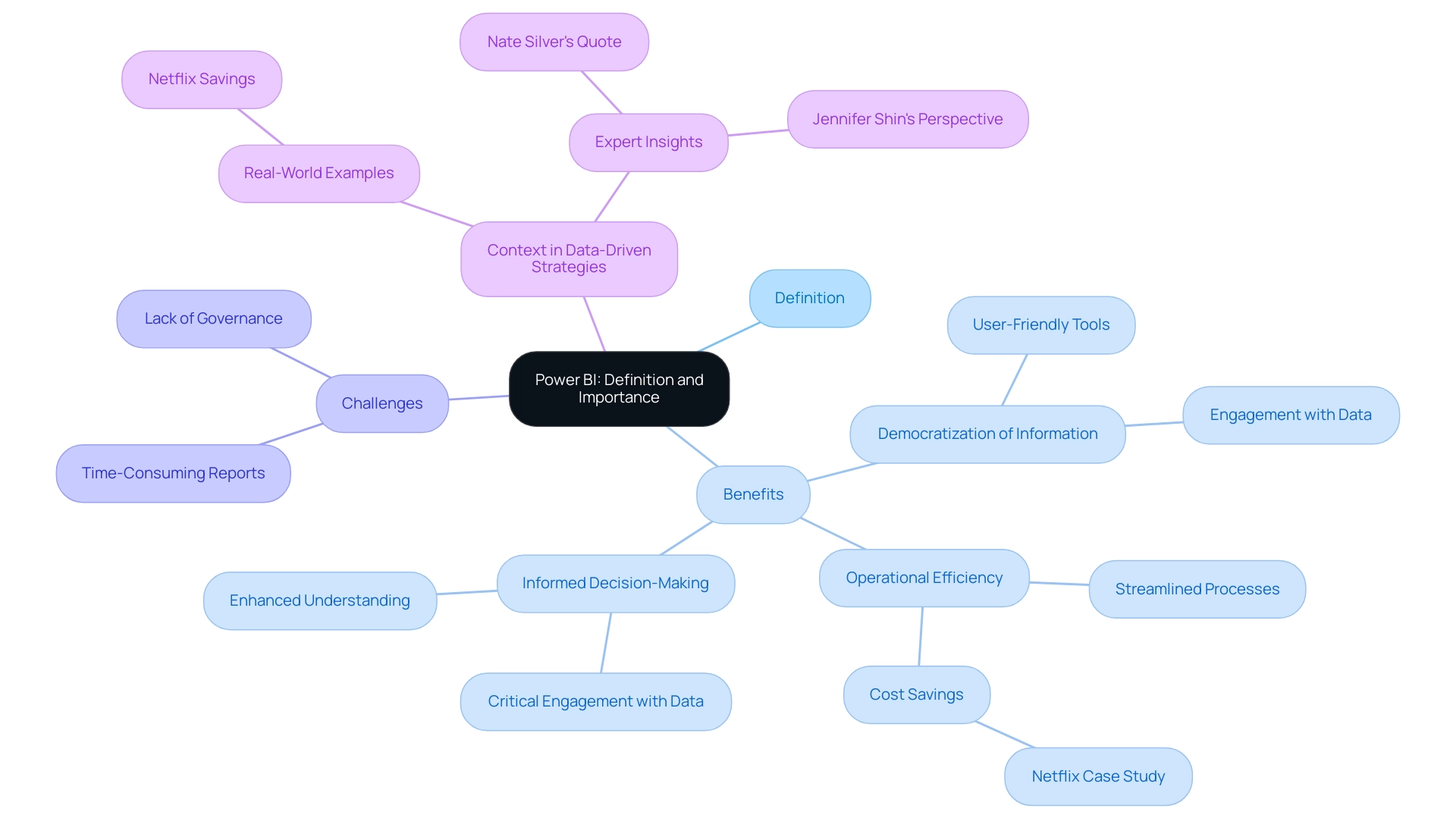
Key Components and Features of Power BI
BI is a multifaceted platform comprising BI Desktop, BI Service, and BI Mobile, each tailored to distinct aspects of management and analytics. BI Desktop, a Windows-based application, excels in document creation with strong information modeling capabilities and advanced analytics features such as AI insights. It’s an essential tool for creating detailed, customizable dashboards that cater to specific business needs.
BI Service, a cloud-based platform, enhances collaboration by allowing users to share and manage reports within workspaces. This service is essential for organizations looking to promote a collaborative environment and simplify information sharing across teams. According to Bhakti Shete, ‘BI Desktop and BI Service are two sides of the same coin, each with its unique strengths.’ Comprehending when to utilize which tool is essential for unlocking the full potential of your information journey.
To further enhance information presentation, our services encompass a 3-Day BI Sprint tailored for swiftly generating professionally crafted documents, along with a General Management App that offers extensive oversight with intelligent evaluations. These solutions ensure efficient reporting, information consistency, and clear, actionable guidance, enabling organizations to gain deeper insights into their operations.
BI Mobile offers smooth access to reports, ensuring that vital insights are always at your fingertips. This mobile capability is crucial for operational efficiency, allowing decision-makers to stay informed and responsive, regardless of their location.
Key features of Power BI include extensive connectivity options, supporting sources like Excel, SQL Server, and various web services. This versatility ensures that users can integrate various sets of information for comprehensive analysis. Additionally, the platform’s advanced analytics capabilities, including AI-driven insights, empower users to derive deeper, actionable intelligence from their information.
However, many users frequently discover that they spend more time creating analyses than utilizing insights from BI dashboards. This common challenge can lead to data inconsistencies and a lack of actionable guidance. Recent statistics indicate that around 70% of companies utilize BI Desktop for report creation, while 30% leverage BI Service for collaborative sharing and management. Case studies reveal that organizations utilizing BI often require at least one Pro license for effective workspace management and sharing, with Free licenses sufficing for individual users. For example, Company X implemented Business Intelligence to enhance their reporting processes, leading to a 25% rise in team productivity due to better information accessibility and collaboration. This licensing strategy is integral to maximizing BI’s benefits and ensuring operational efficiency.
In summary, BI’s components collectively provide a robust, versatile solution for enhancing data analytics capabilities and driving operational efficiency within organizations. Combined with user-friendly automation solutions such as EMMA RPA and Automate, businesses can achieve a seamless digitalization process that enhances productivity and operational outcomes.
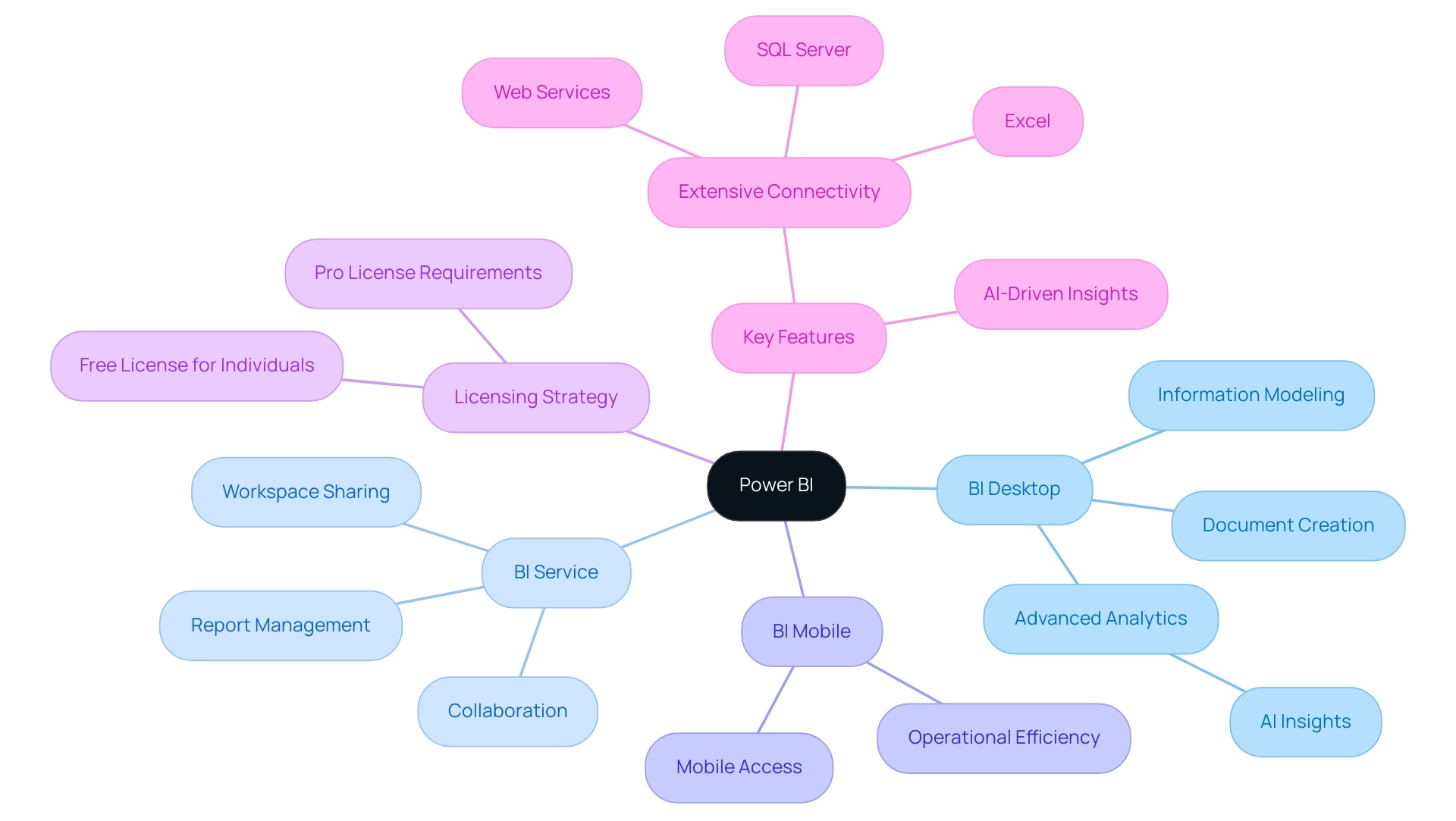
Power BI App vs. Other Versions: Key Differences
The BI ecosystem offers versatile tools designed to meet various operational needs, particularly in enhancing operational efficiency through automation and data-driven insights. The BI App, designed for mobile access, distinguishes itself for its simplicity, allowing analysis and monitoring while on the move. In contrast, BI Desktop is focused on creating presentations and modeling information, making it essential for analysts who require strong analytical capabilities. The BI Service, functioning as a cloud platform, encourages collaboration by enabling teams to share and work together on documents and dashboards effortlessly. This collaborative feature enhances operational efficiency by enabling real-time updates and collective decision-making.
According to Frederic Charest, VP of Marketing, ‘Power Bi’s real-time capabilities are particularly useful when you need to monitor key metrics and KPIs in real time.’ While these tools provide unique functionalities, challenges such as time-consuming document creation and information inconsistencies can hinder effective use. Numerous users discover they invest too much time creating reports instead of utilizing insights from BI dashboards, which can result in confusion and mistrust in the information presented.
Furthermore, the integration of Robotic Process Automation (RPA) can streamline manual workflows, addressing challenges such as poor master information quality and barriers to AI adoption. Recent statistics indicate that the BI community comprises several thousand members globally, with a growing number of users leveraging the mobile app for its accessibility. In fact, recent surveys show that over 60% of users find mobile access crucial for timely decision-making, enabling immediate data availability and the flexibility to make data-driven decisions anywhere, anytime.
Ultimately, each BI tool offers distinct advantages:
1. The Desktop version is ideal for detailed analysis,
2. The Service excels in collaborative efforts,
3. The App ensures accessibility on the move.
Directors of Operations Efficiency can thus choose the most suitable tool according to their specific operational needs, ensuring optimal resource allocation and cost management. To summarize, understanding the unique strengths of each BI version, along with the integration of RPA, empowers directors to make informed decisions that enhance operational efficiency and drive success.
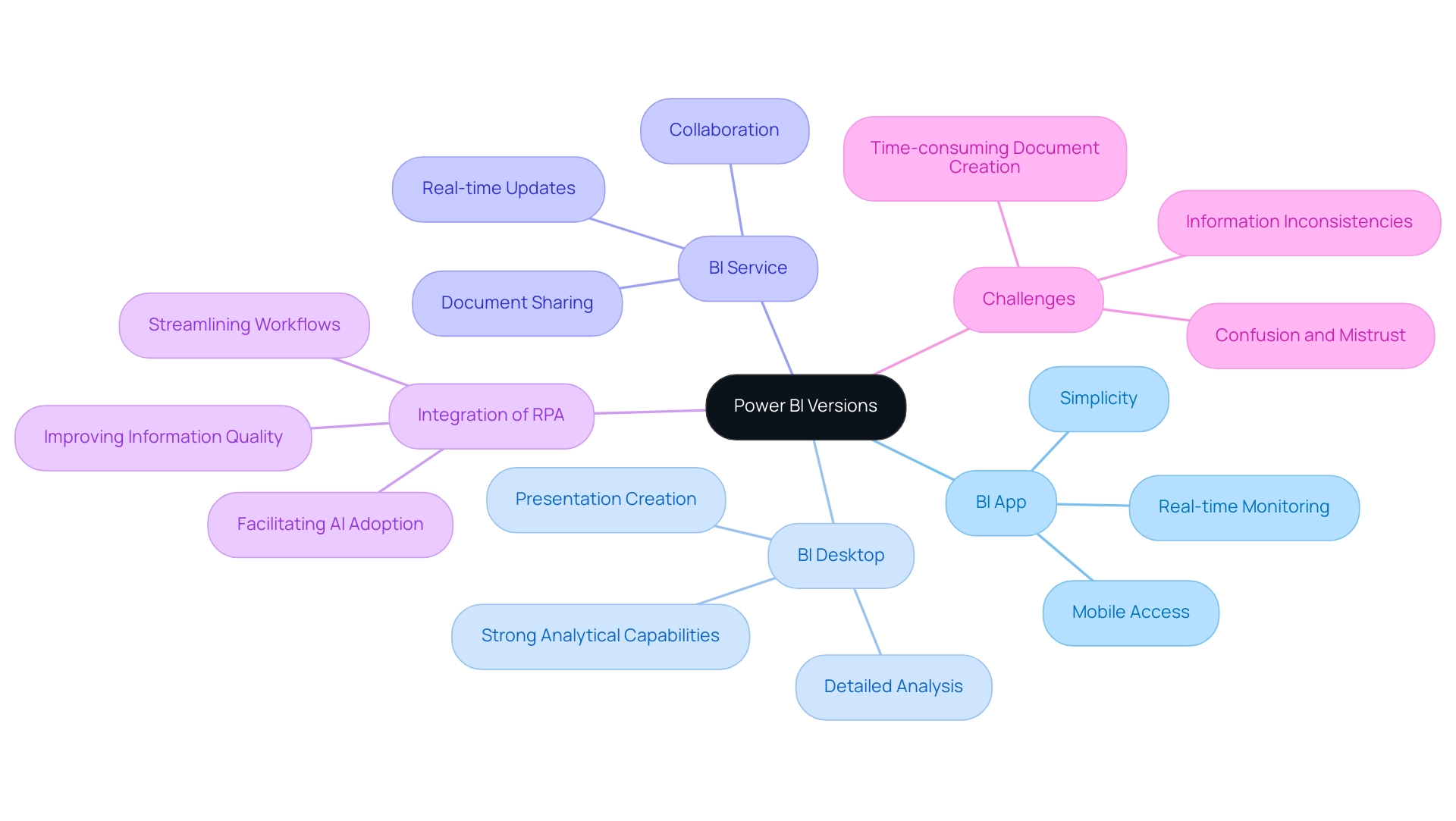
Creating and Publishing Power BI Apps: A Step-by-Step Guide
Developing and releasing BI Apps is a systematic procedure that improves information accessibility and teamwork within an organization, which is essential for utilizing Business Intelligence effectively. The journey starts with creating comprehensive documents in BI Desktop, incorporating crucial data visualizations to guarantee clarity and significance. Once these documents are complete, they are released to the BI Service, a crucial step in broadening their reach and addressing obstacles such as time-consuming creation.
In the BI Service, users can seamlessly create an app by selecting the pertinent reports and dashboards. This stage includes customizing the app’s layout to suit organizational needs and defining user permissions to control access, addressing common issues like data inconsistencies and the lack of actionable guidance. The final step is the publication of the app, making it available for organizational use. This enables team members to access and collaborate on the insights generated, fostering a more collaborative and efficient analytics environment.
For example, enabling the ‘Publish to web’ setting in BI not only streamlines sharing capabilities but also enhances transparency across teams. This feature allows for the generation of shareable links that can be distributed widely, thus broadening the audience for critical insights. A notable case study involves adjusting tenant settings through the admin portal, which resolved issues with the ‘Publish to web’ feature, ultimately allowing the generation of shareable dashboard links. Faith Omonigho Oseghale, an expert in the field, succinctly encapsulates the sentiment: ‘I hope you found this helpful.’
Adhering to recent best practices is crucial. Studies indicate that entities utilizing the ‘Publish to web’ feature effectively enhance their reporting efficiency by as much as 30%. Ensuring that settings are correctly configured can significantly enhance the publishing process, making it smoother and more reliable. By adhering to these clear, step-by-step guidelines, entities can efficiently develop and publish BI Apps, driving improved decision-making and operational efficiency through actionable insights enabled by Business Intelligence and RPA.

Benefits of Power BI Apps for Organizations
BI Apps provide various advantages for companies, enhancing collaboration across departments and improving data-sharing capabilities. In today’s overwhelming AI landscape, these apps assist businesses in cutting through the noise by offering tailored solutions that promote a unified approach to analytics. By employing BI Apps, organizations guarantee all stakeholders have access to the same information, fostering a culture based on insight crucial for informed decision-making. The user-friendly interface enables non-technical team members to easily engage with information, further enhancing operational efficiency.
Customizing the app’s appearance provides a consistent branding experience, while structured navigation improves user engagement and productivity, as noted by Product Marketing Enthusiast Shubhangi Pandey. Furthermore, reports generated in BI Desktop must be published to BI Service prior to sharing, ensuring that the most recent information is available.
A case study illustrates the importance of maintaining Power BI Apps, where Workspace Admins or Members must update apps for changes to be visible to end users. This practice, along with monitoring permissions, prevents data leakage and ensures the app remains relevant and secure as organizational roles evolve. Regular updates and audits are essential for keeping the app aligned with the entity’s needs.
Furthermore, BI Apps streamline the report-sharing process, significantly enhancing project management. Research indicates that entities utilizing Power BI experience a 30% improvement in collaboration and decision-making efficiency. By offering team members and stakeholders access to the most recent information, these apps facilitate improved decision-making. The ability to customize and share apps further enhances reporting capabilities, making it easier for organizations to adapt to changing business needs and optimize their operations while overcoming challenges such as time-consuming report creation and data inconsistencies.
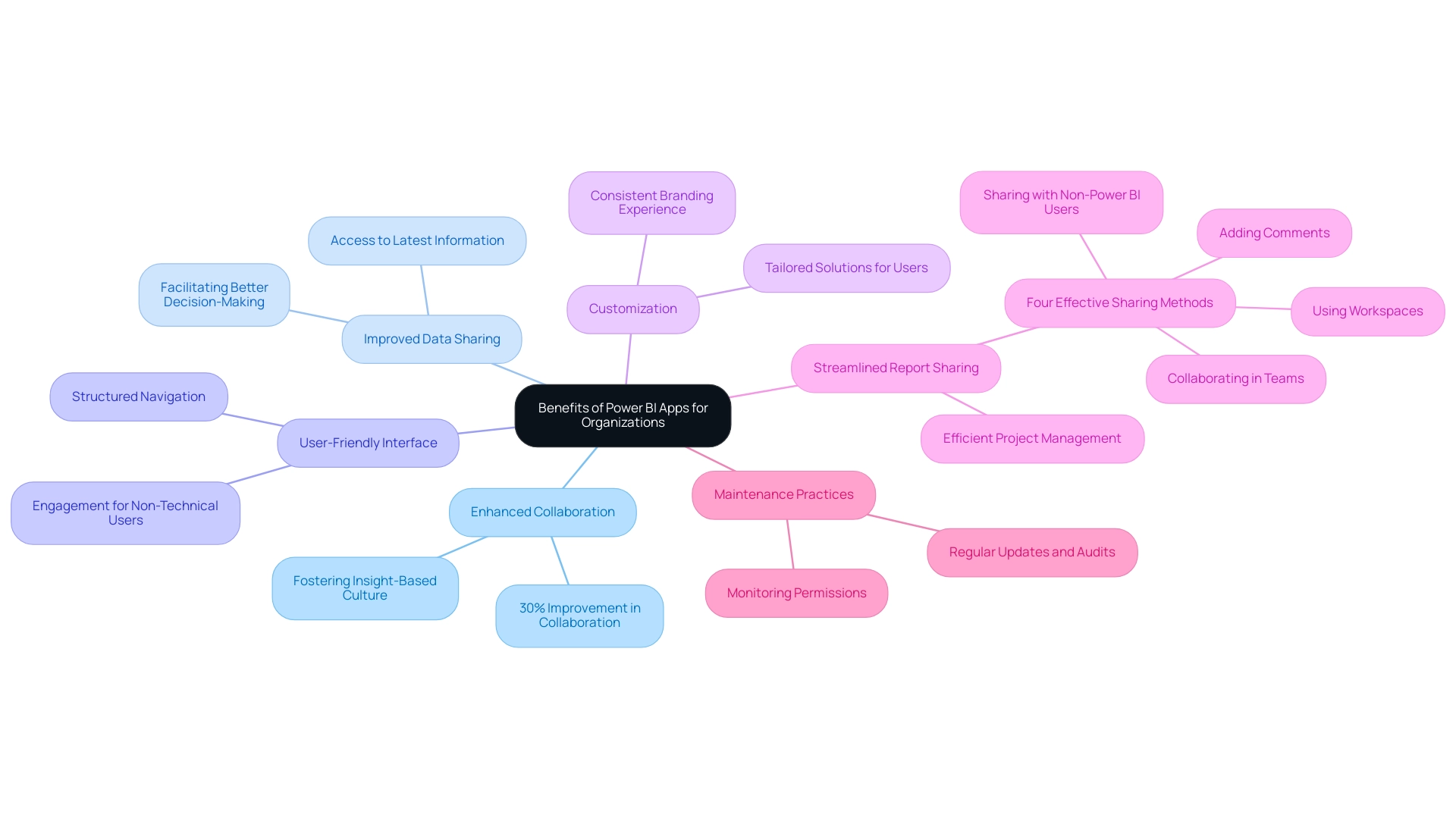
Conclusion
Harnessing the full potential of Power BI can significantly transform how organizations approach data analytics and decision-making. By integrating tools like Power BI Desktop, Power BI Service, and Power BI Mobile, businesses can streamline their reporting processes, enhance collaboration, and democratize data access across teams. This multifaceted platform not only empowers non-technical users to engage with data effectively but also fosters a culture of data-driven decision-making that is crucial for navigating today’s competitive landscape.
The benefits of Power BI Apps further amplify these advantages, offering tailored solutions that improve collaboration, ensure data consistency, and enhance user engagement. With user-friendly interfaces and customizable features, organizations can maintain a cohesive brand experience while ensuring that all stakeholders access the most relevant information. Regular updates and effective governance practices are essential to keep the data accurate and actionable, driving continuous improvement in operational efficiency.
Ultimately, the strategic use of Power BI equips directors of operations with the insights needed to make informed decisions that propel their organizations forward. Embracing this powerful tool not only addresses common challenges associated with data management but also positions businesses to thrive in an increasingly data-centric world. Now is the time to leverage Power BI’s capabilities to unlock new levels of efficiency and innovation, ensuring sustained growth and success.
Introduction
In the rapidly evolving landscape of artificial intelligence, organizations are presented with both immense opportunities and significant challenges. The role of an AI Implementation Consultant has emerged as a crucial asset in navigating this complexity, ensuring that businesses can effectively integrate AI technologies into their operations. By focusing on customized solutions tailored to specific organizational needs, these consultants empower companies to enhance operational efficiency, reduce errors, and drive innovation.
Through real-world examples and case studies, the impact of AI and robotic process automation becomes clear, demonstrating how strategic implementation can lead to measurable improvements and a competitive edge. As businesses strive to harness the power of AI, understanding the vital responsibilities, skills, and success metrics associated with this role is essential for achieving sustainable growth and transformation.
Defining the Role of an AI Implementation Consultant
An AI Implementation Consultant, illustrated by our newest addition, Hayley, who is a pretrained AI-based junior consultant, acts as a crucial figure in aiding entities with the incorporation of artificial intelligence technologies into their current processes. For instance, Hayley has previously worked with a retail company to streamline their inventory management through AI-driven analytics, resulting in a 30% reduction in excess stock. She provides tailored consulting insights, helping businesses navigate their specific needs and challenges. This role encompasses designing customized AI solutions and ensuring seamless implementation.
Our GenAI workshops enable organizations through practical training, emphasizing customized AI experiences, integration tactics, and ethical approaches that are essential for effective performance. By connecting the gap between business goals and technological capabilities, AI Implementation Consultants like Hayley play a crucial role in optimizing workflows.
A case study showing how a mid-sized company improved its performance through GUI automation illustrates the measurable results attainable through these strategies. In this situation, Hayley’s guidance was crucial in attaining a 70% decrease in data entry mistakes, demonstrating how her expertise directly aids in utilizing AI technologies for improved productivity, innovation, and competitive edge.
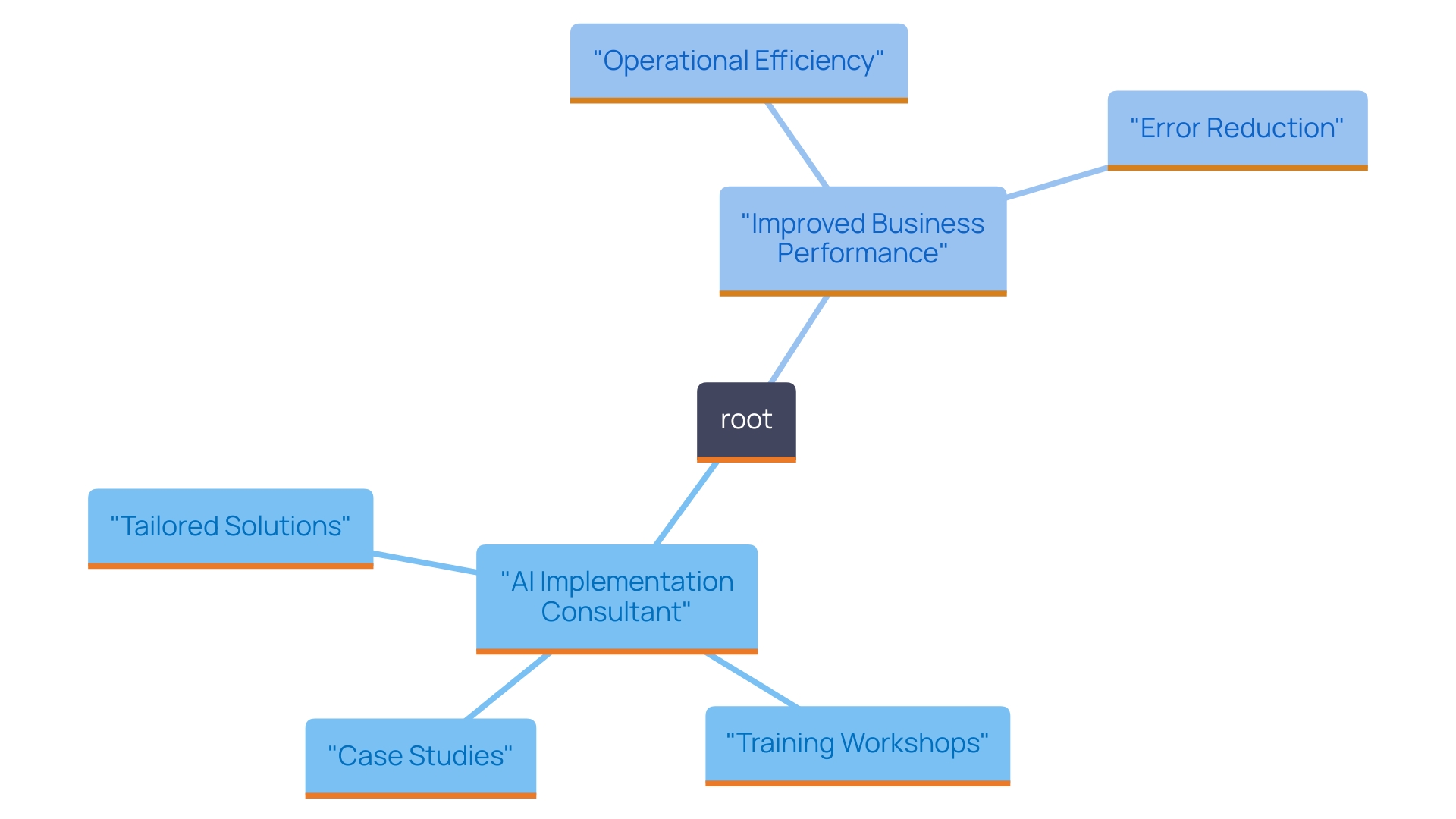
Key Responsibilities and Skills of an AI Implementation Consultant
AI Implementation Consultants play a crucial role in assessing organizational needs, designing tailored AI strategies, implementing robotic process automation (RPA), and training staff on new technologies to overcome workplace challenges. For instance, in a recent case, a manufacturing company successfully utilized RPA to automate their inventory management, resulting in a 30% reduction in processing time and a significant decrease in human error.
By utilizing RPA, these consultants assist entities in tackling repetitive tasks and dealing with staffing shortages, ultimately improving efficiency in a swiftly changing AI environment. Key skills for these consultants include:
- A strong understanding of data analytics
- Project management
- The ability to communicate complex technical concepts in an accessible manner
- Problem-solving skills to tackle challenges that arise during implementation
Effective consultants excel at fostering collaboration among stakeholders, ensuring that AI initiatives align with broader business goals. Their role encompasses not just technological solutions but also emphasizes change management and employee engagement to facilitate smooth transitions into AI-enhanced workflows, thereby driving data-driven insights and supporting business growth.
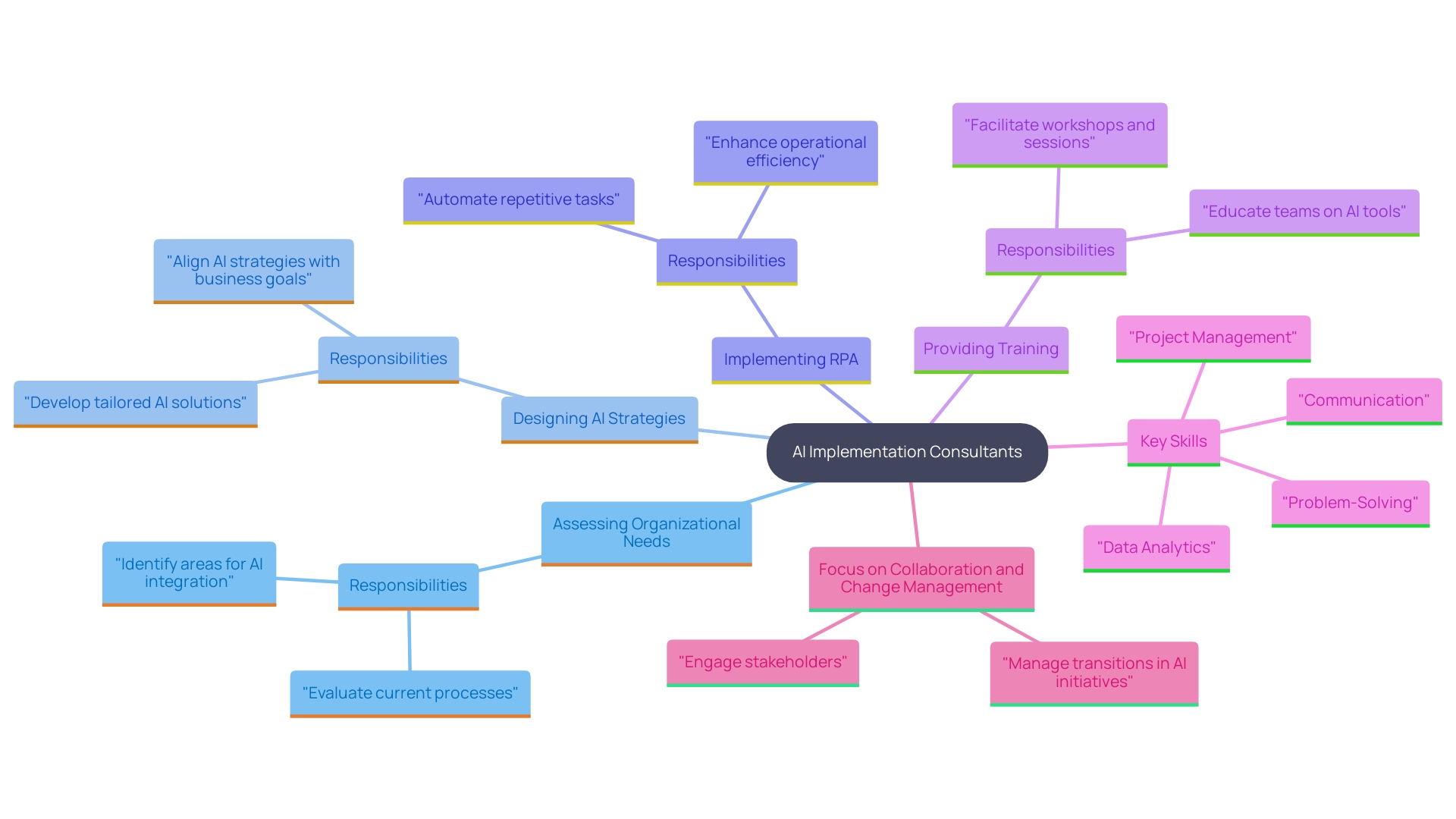
The Importance of Customization in AI Solutions
Customization in AI solutions is essential for addressing the specific operational challenges faced by various entities. Each business has unique workflows, data structures, and performance metrics that require tailored approaches to maximize the effectiveness of AI technologies. An AI Implementation Consultant conducts thorough assessments to understand these unique needs, ensuring that the AI solutions implemented are aligned with the company’s goals. This tailored approach not only increases the likelihood of successful implementation but also enhances user acceptance and adoption among employees, ultimately leading to better results and ROI.
For instance, a manufacturing company that implemented EMMA RPA was able to reduce its order processing time by 30%, allowing employees to focus on more strategic tasks. Similarly, a financial institution using Microsoft Power Automate streamlined its reporting process, resulting in a 40% decrease in errors and improved compliance.
Furthermore, utilizing Robotic Process Automation (RPA) solutions such as EMMA RPA and Microsoft Power Automate can further improve productivity and employee morale by automating repetitive tasks and streamlining workflows. In a rapidly evolving AI landscape, this customization is crucial in navigating overwhelming options and achieving actionable insights through Business Intelligence. Ultimately, adopting customized AI and RPA solutions not only enhances productivity but also promotes a culture of innovation and flexibility within companies.
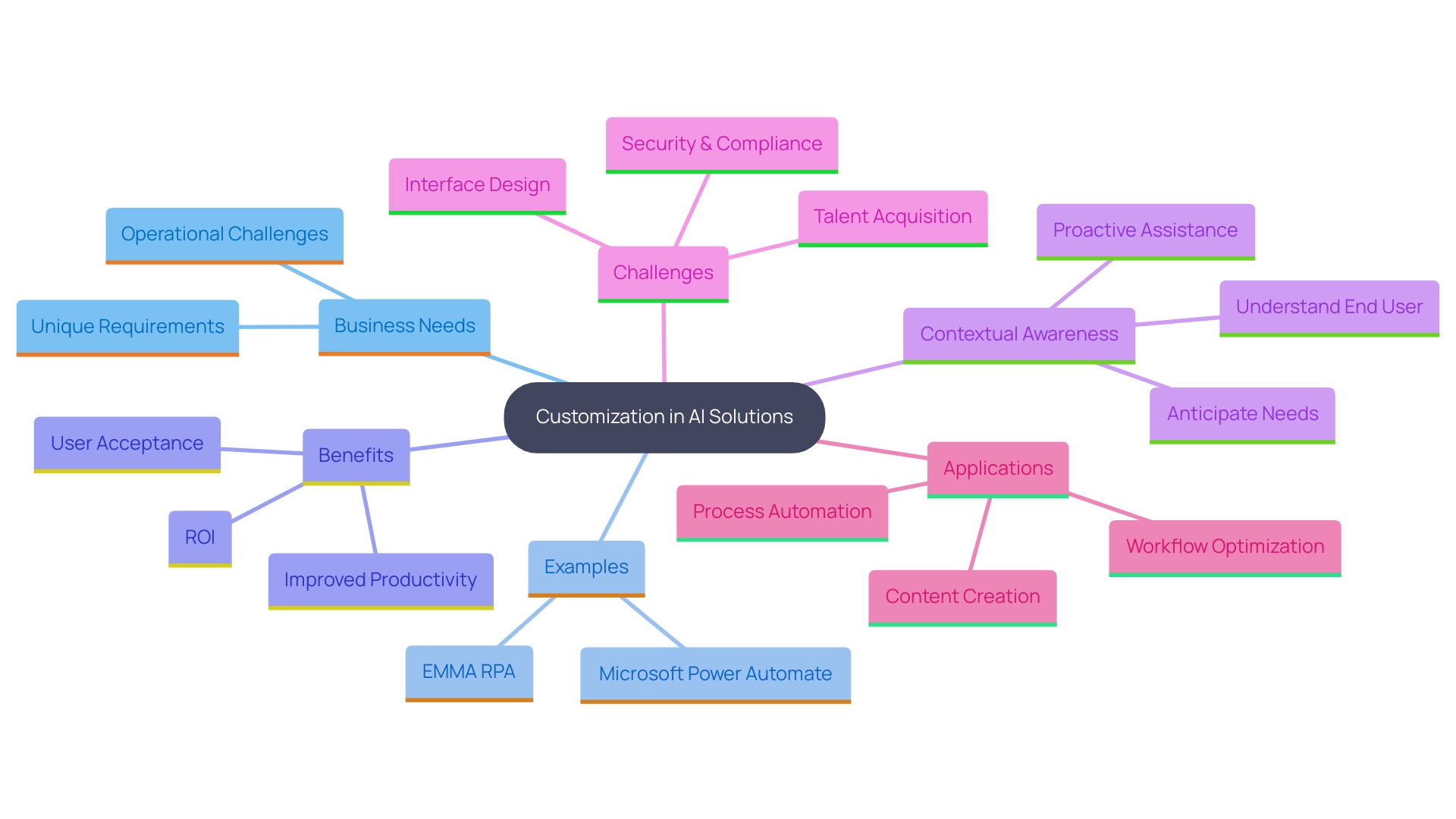
Measuring Success: Metrics for AI Implementation
To effectively measure the success of AI implementations, organizations must establish precise metrics tailored to their unique goals. Key performance indicators (KPIs) should include:
- Enhancements in functional productivity
- Reductions in processing times
- Cost savings
- User satisfaction levels
For example, Schneider Electric’s AI solution for Waterforce has demonstrated the ability to save up to 50% in energy expenses, highlighting how AI can directly influence performance and cost savings. Similarly, Cisco’s innovative use of machine learning in networking demonstrates how AI can autonomously manage traffic and respond to security threats, significantly optimizing network performance.
Moreover, leveraging Robotic Process Automation (RPA) enhances operational efficiency by automating manual workflows, allowing your team to focus on more strategic, value-adding work. This technology not only boosts productivity but also reduces errors, addressing challenges posed by staffing shortages and outdated systems. The significance of Business Intelligence in this context is crucial, as it converts raw data into actionable insights, enabling entities to make informed decisions that drive growth and innovation.
The WildTrack Footprint Identification Technique (FIT), developed with SAS, exemplifies AI’s capability to enhance data processing in wildlife conservation, enabling effective monitoring and identification of endangered species. These examples underscore the necessity of setting clear benchmarks and continuously monitoring KPIs to evaluate the success of AI projects.
Eva Dong, a Senior Expert Manager at McKinsey & Company, emphasizes the significance of gaining insights into best practices and strategies for measuring success and ROI in AI marketing projects. Her viewpoint emphasizes the necessity for a structured method to define and evaluate metrics, ensuring that entities can effectively gauge the impact of their AI initiatives.
By collaborating with an AI Implementation Consultant, organizations can define these critical metrics and establish benchmarks for success. Continuous monitoring of these indicators allows for timely adjustments, ensuring that AI initiatives, along with RPA and Business Intelligence, drive real value and contribute to sustained business growth.
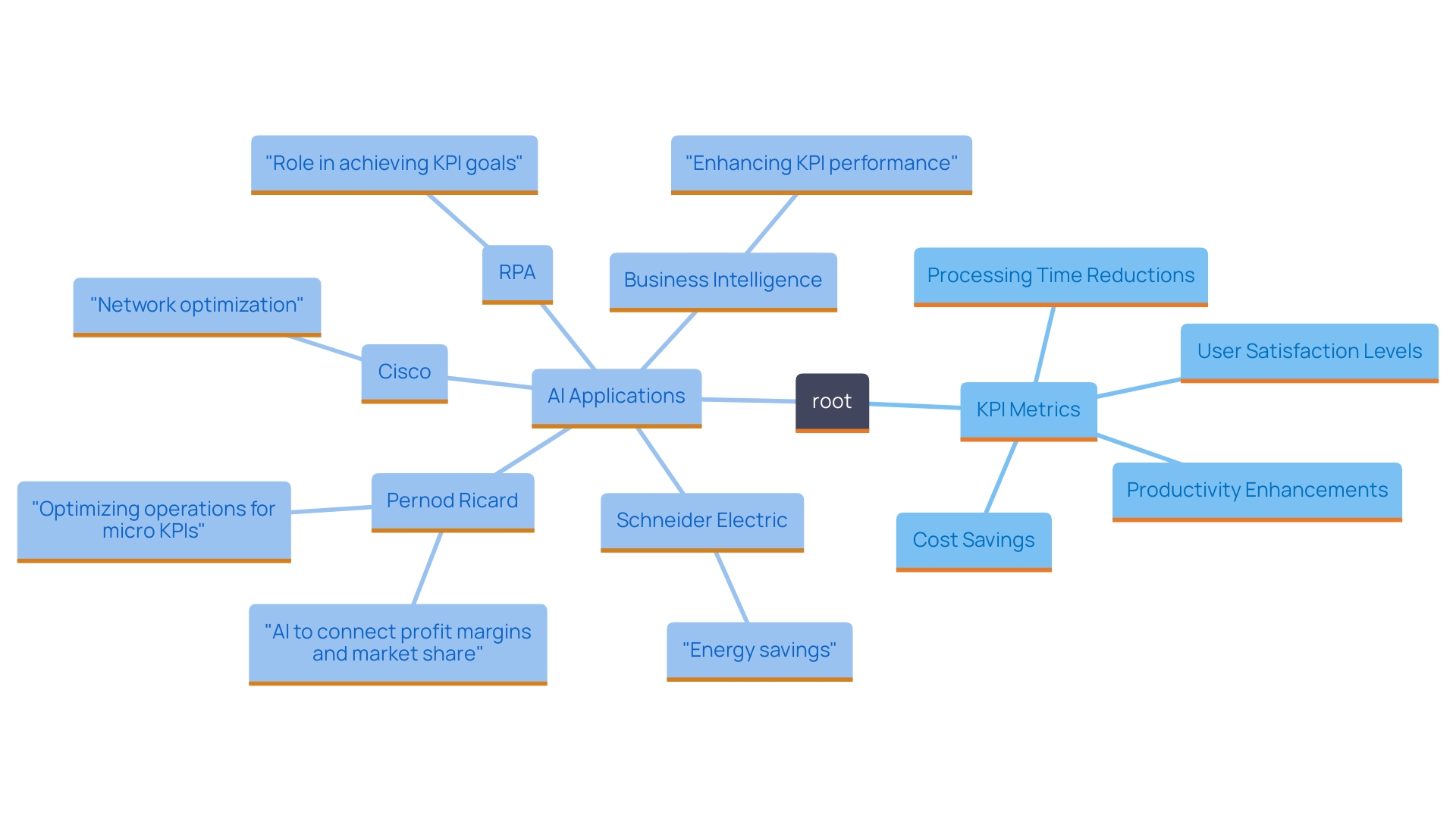
Conclusion
The integration of artificial intelligence into business operations is not just a strategic move; it’s a transformative journey that requires expert guidance. AI Implementation Consultants serve as the linchpins in this process, offering customized solutions that cater to the unique challenges of each organization. By leveraging their expertise in assessing needs, designing tailored strategies, and implementing robotic process automation, these consultants help businesses streamline workflows, reduce errors, and ultimately enhance operational efficiency.
Customization emerges as a key theme throughout the implementation process, allowing organizations to align AI solutions with their specific goals and performance metrics. The successful case studies highlighted in the article illustrate the tangible benefits of such tailored approaches, from significant reductions in processing times to improved compliance and user satisfaction. This adaptability not only fosters a culture of innovation but also ensures that employees are engaged and receptive to new technologies.
Measuring success through clear metrics is essential for sustaining AI initiatives. By establishing key performance indicators that reflect operational improvements and cost savings, organizations can continuously monitor progress and make informed decisions. Collaborating with an AI Implementation Consultant allows businesses to define these metrics and adjust strategies as needed, ensuring that the integration of AI technologies drives real value and supports long-term growth.
As organizations navigate the complexities of AI adoption, the role of the AI Implementation Consultant is invaluable. By focusing on customization, effective training, and ongoing evaluation, these experts empower businesses to harness the full potential of AI, turning challenges into opportunities for innovation and competitive advantage. Embracing this partnership is a crucial step towards achieving sustainable growth in an increasingly AI-driven landscape.
